Next: Functions and Variables for pictures, Previous: Introduction to draw, Up: draw [Contents][Index]
53.2 Functions and Variables for draw
53.2.1 Scenes
- Scene constructor: gr2d (argument_1, ...) ¶
-
Function
gr2dbuilds an object describing a 2D scene. Arguments are graphic options, graphic objects, or lists containing both graphic options and objects. This scene is interpreted sequentially: graphic options affect those graphic objects placed on its right. Some graphic options affect the global appearance of the scene.This is the list of graphic objects available for scenes in two dimensions:
bars,ellipse,explicit,image,implicit,label,parametric,points,polar,polygon,quadrilateral,rectangle,triangle,vectorandgeomap(this one defined in packageworldmap).(%i1) draw( gr2d( key="sin (x)",grid=[2,2], explicit( sin(x), x,0,2*%pi ) ), gr2d( key="cos (x)",grid=[2,2], explicit( cos(x), x,0,2*%pi ) ) ); (%o1) [gr2d(explicit), gr2d(explicit)]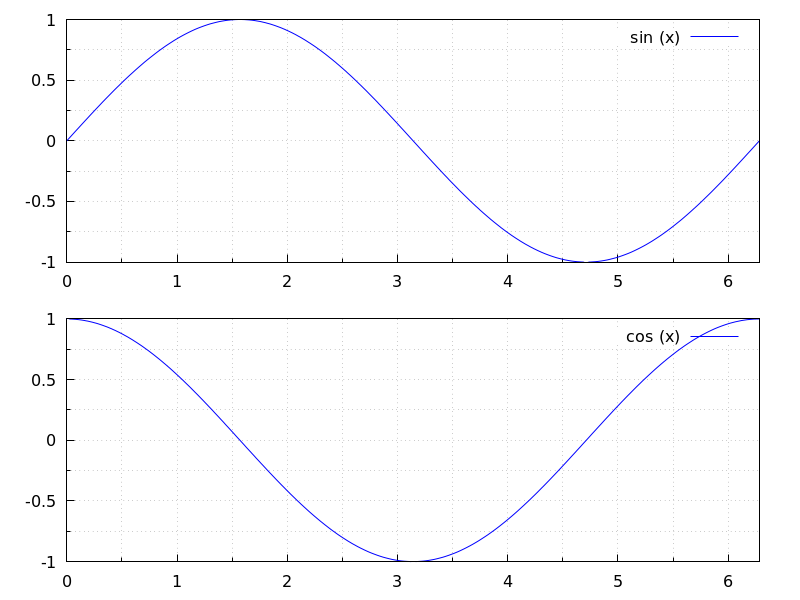 Categories: Package draw ·
Categories: Package draw ·
- Scene constructor: gr3d (argument_1, ...) ¶
-
Function
gr3dbuilds an object describing a 3d scene. Arguments are graphic options, graphic objects, or lists containing both graphic options and objects. This scene is interpreted sequentially: graphic options affect those graphic objects placed on its right. Some graphic options affect the global appearance of the scene.This is the list of graphic objects available for scenes in three dimensions:
cylindrical,elevation_grid,explicit,implicit,label,mesh,parametric,
parametric_surface,points,quadrilateral,spherical,triangle,tube,
vector, andgeomap(this one defined in packageworldmap).Categories: Package draw ·
53.2.2 Functions
- Function: draw (
<arg_1>, ...) ¶ -
Plots a series of scenes; its arguments are
gr2dand/orgr3dobjects, together with some options, or lists of scenes and options. By default, the scenes are put together in one column.Besides scenes the function
drawaccepts the following global options:terminal,columns,dimensions,file_nameanddelay.Functions
draw2danddraw3dshort cuts that can be used when only one scene is required, in two or three dimensions, respectively.Examples:
(%i1) scene1: gr2d(title="Ellipse", nticks=300, parametric(2*cos(t),5*sin(t),t,0,2*%pi))$ (%i2) scene2: gr2d(title="Triangle", polygon([4,5,7],[6,4,2]))$ (%i3) draw(scene1, scene2, columns = 2)$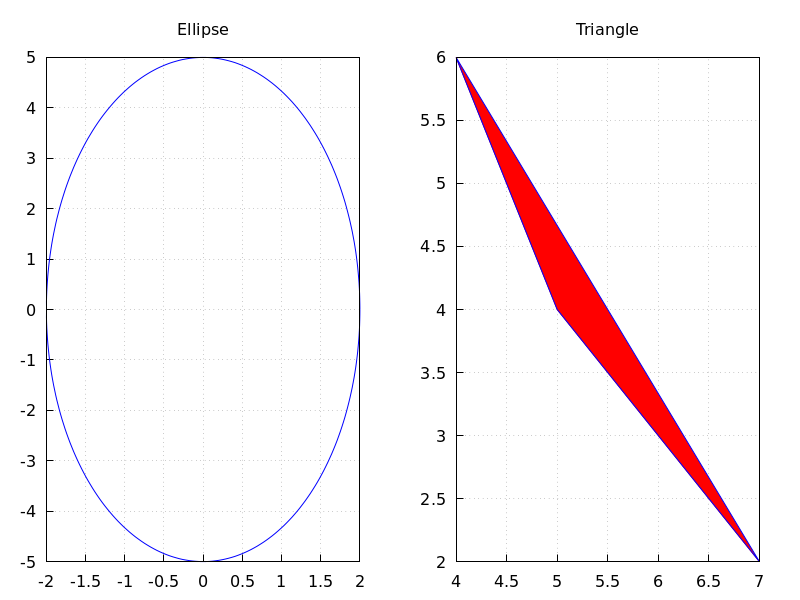
(%i1) scene1: gr2d(title="A sinus", grid=true, explicit(sin(t),t,0,2*%pi))$ (%i2) scene2: gr2d(title="A cosinus", grid=true, explicit(cos(t),t,0,2*%pi))$ (%i3) draw(scene1, scene2)$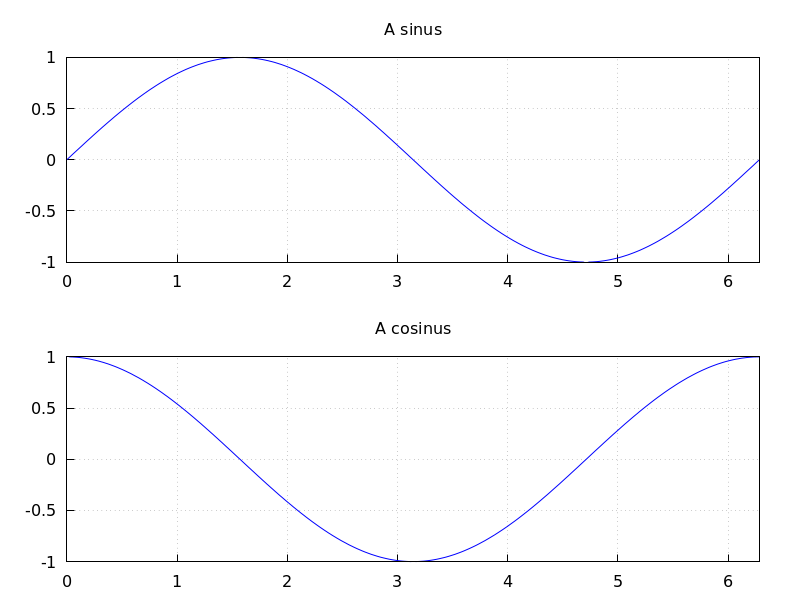
The following two draw sentences are equivalent:
(%i1) draw(gr3d(explicit(x^2+y^2,x,-1,1,y,-1,1))); (%o1) [gr3d(explicit)] (%i2) draw3d(explicit(x^2+y^2,x,-1,1,y,-1,1)); (%o2) [gr3d(explicit)]
Creating an animated gif file:
(%i1) draw( delay = 100, file_name = "zzz", terminal = 'animated_gif, gr2d(explicit(x^2,x,-1,1)), gr2d(explicit(x^3,x,-1,1)), gr2d(explicit(x^4,x,-1,1))); End of animation sequence (%o1) [gr2d(explicit), gr2d(explicit), gr2d(explicit)]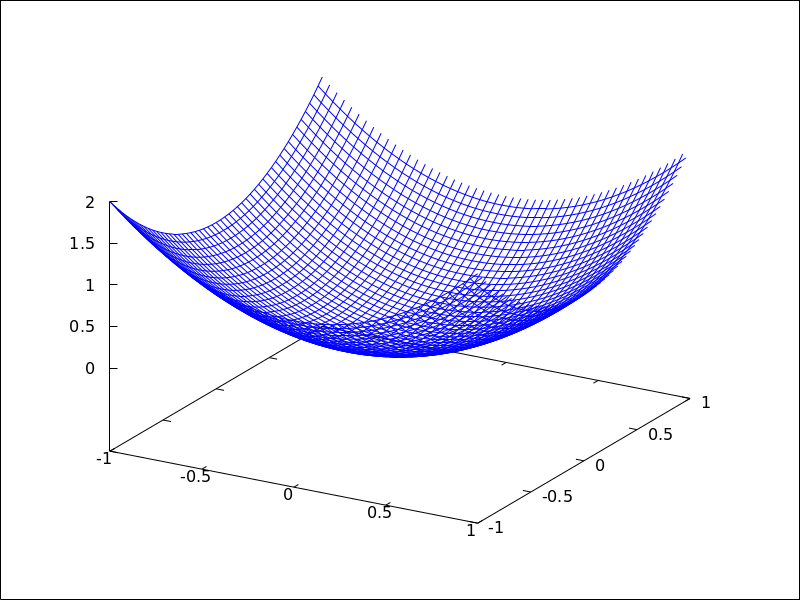
See also
gr2d,gr3d,draw2danddraw3d.Categories: Package draw · File output ·
- Function: draw2d (argument_1, ...) ¶
-
This function is a shortcut for
draw(gr2d(options, ..., graphic_object, ...)).It can be used to plot a unique scene in 2d, as can be seen in most examples below.
Categories: Package draw · File output ·
- Function: draw3d (argument_1, ...) ¶
-
This function is a shortcut for
draw(gr3d(options, ..., graphic_object, ...)).It can be used to plot a unique scene in 3d, as can be seen in many examples below.
Categories: Package draw · File output ·
- Function: draw_file (graphic option, ..., graphic object, ...) ¶
-
Saves the current plot into a file. Accepted graphics options are:
terminal,dimensionsandfile_name.Example:
(%i1) /* screen plot */ draw(gr3d(explicit(x^2+y^2,x,-1,1,y,-1,1)))$ (%i2) /* same plot in eps format */ draw_file(terminal = eps, dimensions = [5,5]) $Categories: Package draw · File output ·
- Function: multiplot_mode (term) ¶
-
This function enables Maxima to work in one-window multiplot mode with terminal term; accepted arguments for this function are
screen,wxt,aquaterm,windowsandnone.When multiplot mode is enabled, each call to
drawsends a new plot to the same window, without erasing the previous ones. To disable the multiplot mode, writemultiplot_mode(none).When multiplot mode is enabled, global option
terminalis blocked and you have to disable this working mode before changing to another terminal.On Windows this feature requires Gnuplot 5.0 or newer. Note, that just plotting multiple expressions into the same plot doesn’t require multiplot: It can be done by just issuing multiple
explicitor similar commands in a row.Example:
(%i1) set_draw_defaults( xrange = [-1,1], yrange = [-1,1], grid = true, title = "Step by step plot" )$ (%i2) multiplot_mode(screen)$ (%i3) draw2d(color=blue, explicit(x^2,x,-1,1))$ (%i4) draw2d(color=red, explicit(x^3,x,-1,1))$ (%i5) draw2d(color=brown, explicit(x^4,x,-1,1))$ (%i6) multiplot_mode(none)$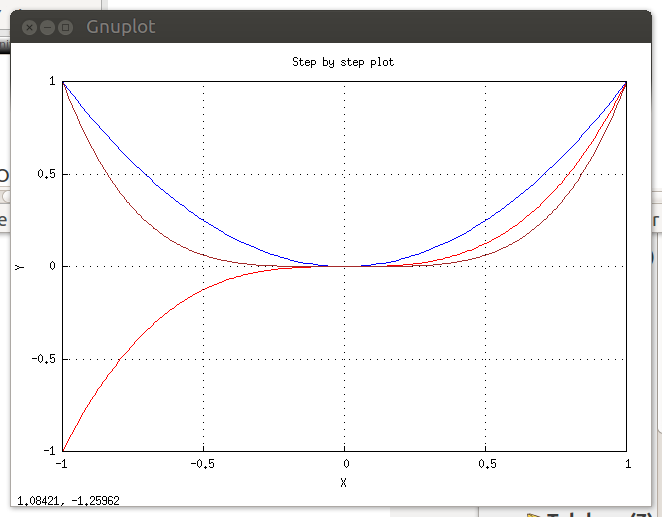 Categories: Package draw · File output ·
Categories: Package draw · File output ·
- Function: set_draw_defaults (graphic option, ..., graphic object, ...) ¶
-
Sets user graphics options. This function is useful for plotting a sequence of graphics with common graphics options. Calling this function without arguments removes user defaults.
Example:
(%i1) set_draw_defaults( xrange = [-10,10], yrange = [-2, 2], color = blue, grid = true)$ (%i2) /* plot with user defaults */ draw2d(explicit(((1+x)**2/(1+x*x))-1,x,-10,10))$ (%i3) set_draw_defaults()$ (%i4) /* plot with standard defaults */ draw2d(explicit(((1+x)**2/(1+x*x))-1,x,-10,10))$Categories: Package draw ·
53.2.3 Plot options for draw programs
- Graphic option: adapt_depth ¶
Default value: 10
adapt_depthis the maximum number of splittings used by the adaptive plotting routine.This option is relevant only for 2d
explicitfunctions.See also
nticksCategories: Package draw ·
- Graphic option: allocation ¶
Default value:
falseWith option
allocationit is possible to place a scene in the output window at will; this is of interest in multiplots. Whenfalse, the scene is placed automatically, depending on the value assigned to optioncolumns. In any other case,allocationmust be set to a list of two pairs of numbers; the first corresponds to the position of the lower left corner of the scene, and the second pair gives the width and height of the plot. All quantities must be given in relative coordinates, between 0 and 1.Examples:
In site graphics.
(%i1) draw( gr2d( explicit(x^2,x,-1,1)), gr2d( allocation = [[1/4, 1/4],[1/2, 1/2]], explicit(x^3,x,-1,1), grid = true) ) $
Multiplot with selected dimensions.
(%i1) draw( terminal = wxt, gr2d( grid=[5,5], allocation = [[0, 0],[1, 1/4]], explicit(x^2,x,-1,1)), gr3d( allocation = [[0, 1/4],[1, 3/4]], explicit(x^2+y^2,x,-1,1,y,-1,1) ))$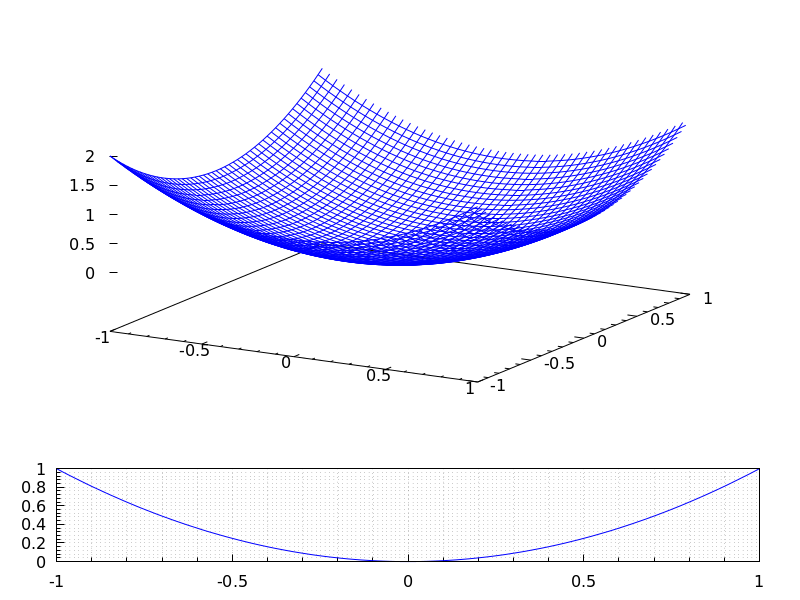
See also option
columns.Categories: Package draw ·
- Graphic option: axis_3d ¶
Default value:
trueIf
axis_3distrue, the x, y and z axis are shown in 3d scenes.Since this is a global graphics option, its position in the scene description does not matter.
Example:
(%i1) draw3d(axis_3d = false, explicit(sin(x^2+y^2),x,-2,2,y,-2,2) )$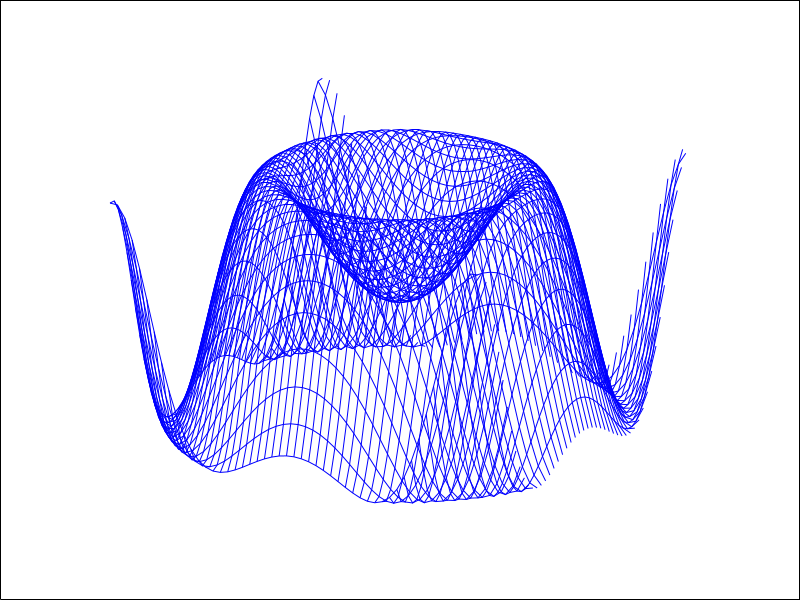
See also
axis_bottom,axis_left,axis_top, andaxis_rightfor axis in 2d.Categories: Package draw ·
- Graphic option: axis_bottom ¶
Default value:
trueIf
axis_bottomistrue, the bottom axis is shown in 2d scenes.Since this is a global graphics option, its position in the scene description does not matter.
Example:
(%i1) draw2d(axis_bottom = false, explicit(x^3,x,-1,1))$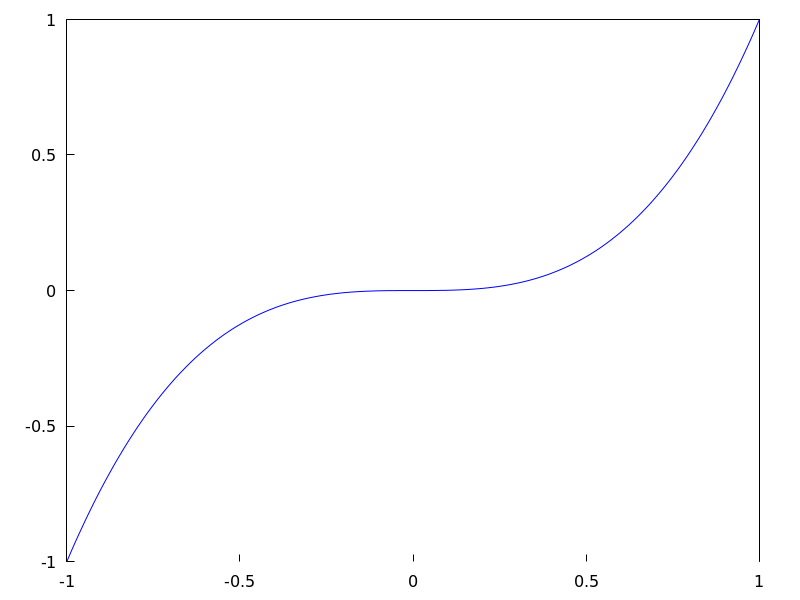
See also
axis_left,axis_top,axis_rightandaxis_3d.Categories: Package draw ·
- Graphic option: axis_left ¶
Default value:
trueIf
axis_leftistrue, the left axis is shown in 2d scenes.Since this is a global graphics option, its position in the scene description does not matter.
Example:
(%i1) draw2d(axis_left = false, explicit(x^3,x,-1,1))$See also
axis_bottom,axis_top,axis_rightandaxis_3d.Categories: Package draw ·
- Graphic option: axis_right ¶
Default value:
trueIf
axis_rightistrue, the right axis is shown in 2d scenes.Since this is a global graphics option, its position in the scene description does not matter.
Example:
(%i1) draw2d(axis_right = false, explicit(x^3,x,-1,1))$See also
axis_bottom,axis_left,axis_topandaxis_3d.Categories: Package draw ·
- Graphic option: axis_top ¶
Default value:
trueIf
axis_topistrue, the top axis is shown in 2d scenes.Since this is a global graphics option, its position in the scene description does not matter.
Example:
(%i1) draw2d(axis_top = false, explicit(x^3,x,-1,1))$See also
axis_bottom,axis_left,axis_right, andaxis_3d.Categories: Package draw ·
- Graphic option: background_color ¶
Default value:
whiteSets the background color for terminals. Default background color is white.
Since this is a global graphics option, its position in the scene description does not matter.
This option does not work with terminals
epslatexandepslatex_standalone.See also
colorCategories: Package draw ·
- Graphic option: border ¶
Default value:
trueIf
borderistrue, borders of polygons are painted according toline_typeandline_width.This option affects the following graphic objects:
Example:
(%i1) draw2d(color = brown, line_width = 8, polygon([[3,2],[7,2],[5,5]]), border = false, fill_color = blue, polygon([[5,2],[9,2],[7,5]]) )$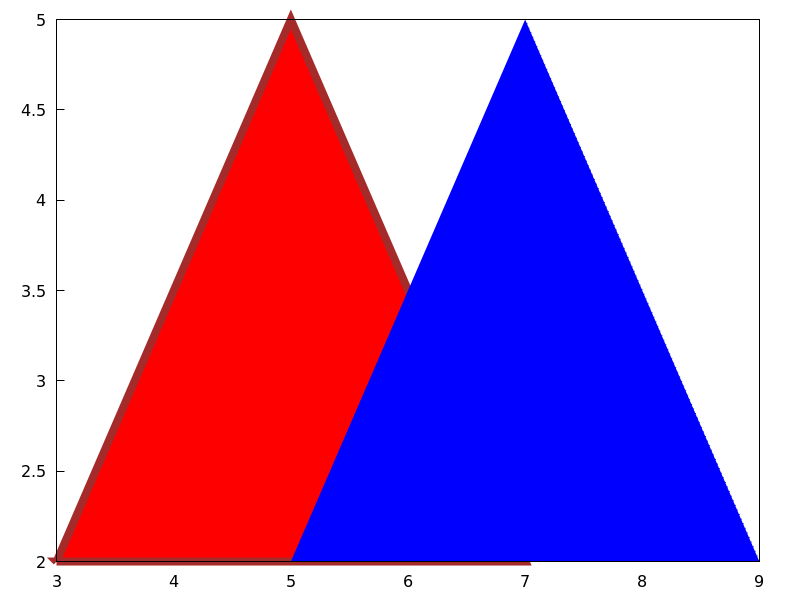 Categories: Package draw ·
Categories: Package draw ·
- Graphic option: capping ¶
Default value:
[false, false]A list with two possible elements,
trueandfalse, indicating whether the extremes of a graphic objecttuberemain closed or open. By default, both extremes are left open.Setting
capping = falseis equivalent tocapping = [false, false], andcapping = trueis equivalent tocapping = [true, true].Example:
(%i1) draw3d( capping = [false, true], tube(0, 0, a, 1, a, 0, 8) )$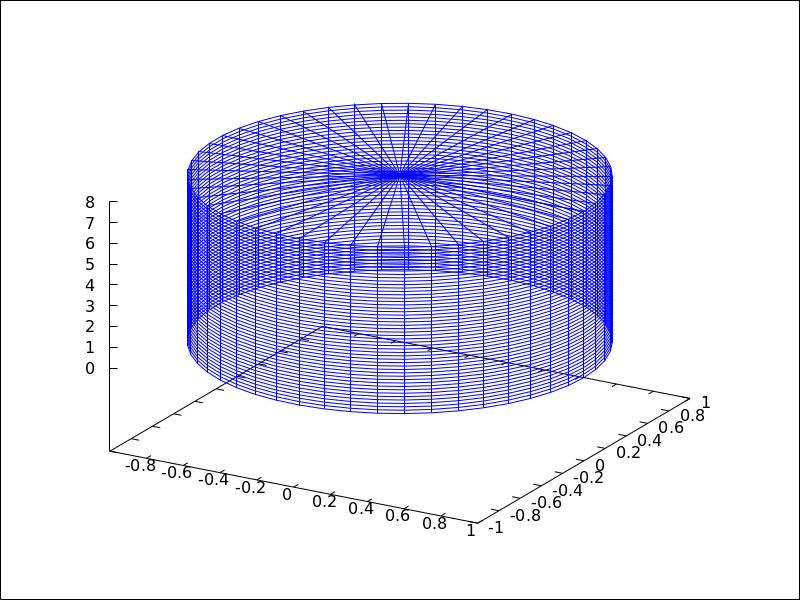 Categories: Package draw ·
Categories: Package draw ·
- Graphic option: cbrange ¶
Default value:
autoIf
cbrangeisauto, the range for the values which are colored whenenhanced3dis notfalseis computed automatically. Values outside of the color range use color of the nearest extreme.When
enhanced3dorcolorboxisfalse, optioncbrangehas no effect.If the user wants a specific interval for the colored values, it must be given as a Maxima list, as in
cbrange=[-2, 3].Since this is a global graphics option, its position in the scene description does not matter.
Example:
(%i1) draw3d ( enhanced3d = true, color = green, cbrange = [-3,10], explicit(x^2+y^2, x,-2,2,y,-2,2)) $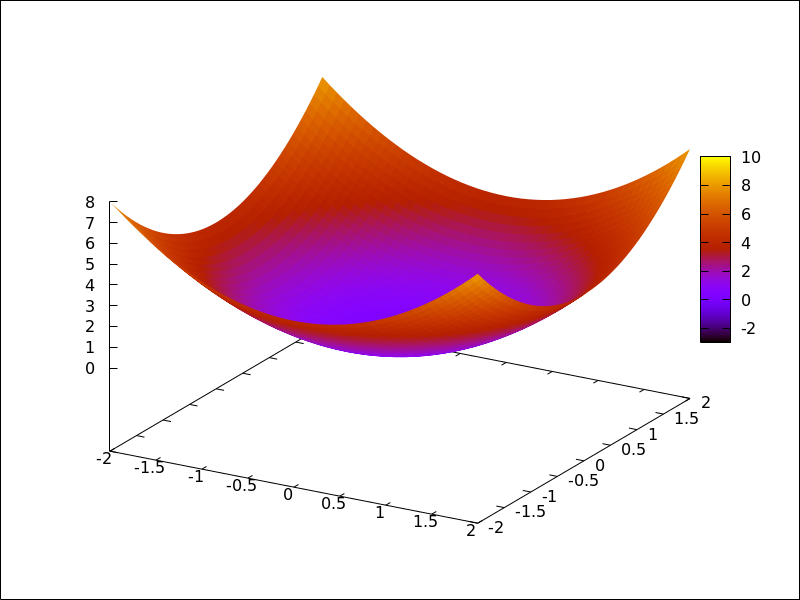
See also
enhanced3d,colorboxandcbtics.Categories: Package draw ·
- Graphic option: cbtics ¶
Default value:
autoThis graphic option controls the way tic marks are drawn on the colorbox when option
enhanced3dis notfalse.When
enhanced3dorcolorboxisfalse, optioncbticshas no effect.See
xticsfor a complete description.Example :
(%i1) draw3d ( enhanced3d = true, color = green, cbtics = {["High",10],["Medium",05],["Low",0]}, cbrange = [0, 10], explicit(x^2+y^2, x,-2,2,y,-2,2)) $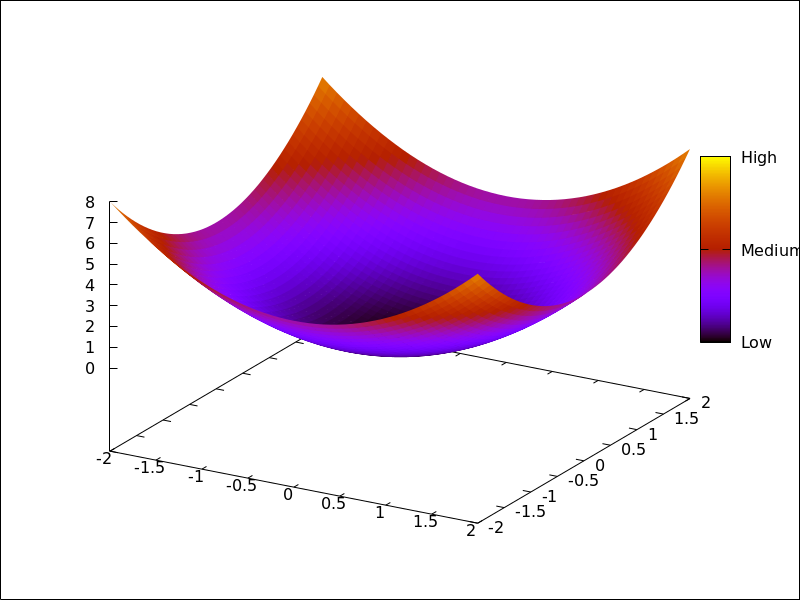
See also
enhanced3d,colorboxandcbrange.Categories: Package draw ·
- Graphic option: color ¶
Default value:
bluecolorspecifies the color for plotting lines, points, borders of polygons and labels.Colors can be given as names or in hexadecimal rgb code. If a gnuplot version
>= 5.0is used and the terminal that is in use supports this rgba colors with transparency information are also supported.Available color names are:
white black gray0 grey0 gray10 grey10 gray20 grey20 gray30 grey30 gray40 grey40 gray50 grey50 gray60 grey60 gray70 grey70 gray80 grey80 gray90 grey90 gray100 grey100 gray grey light_gray light_grey dark_gray dark_grey red light_red dark_red yellow light_yellow dark_yellow green light_green dark_green spring_green forest_green sea_green blue light_blue dark_blue midnight_blue navy medium_blue royalblue skyblue cyan light_cyan dark_cyan magenta light_magenta dark_magenta turquoise light_turquoise dark_turquoise pink light_pink dark_pink coral light_coral orange_red salmon light_salmon dark_salmon aquamarine khaki dark_khaki goldenrod light_goldenrod dark_goldenrod gold beige brown orange dark_orange violet dark_violet plum purple
Cromatic components in hexadecimal code are introduced in the form
"#rrggbb".Example:
(%i1) draw2d(explicit(x^2,x,-1,1), /* default is black */ color = red, explicit(0.5 + x^2,x,-1,1), color = blue, explicit(1 + x^2,x,-1,1), color = light_blue, explicit(1.5 + x^2,x,-1,1), color = "#23ab0f", label(["This is a label",0,1.2]) )$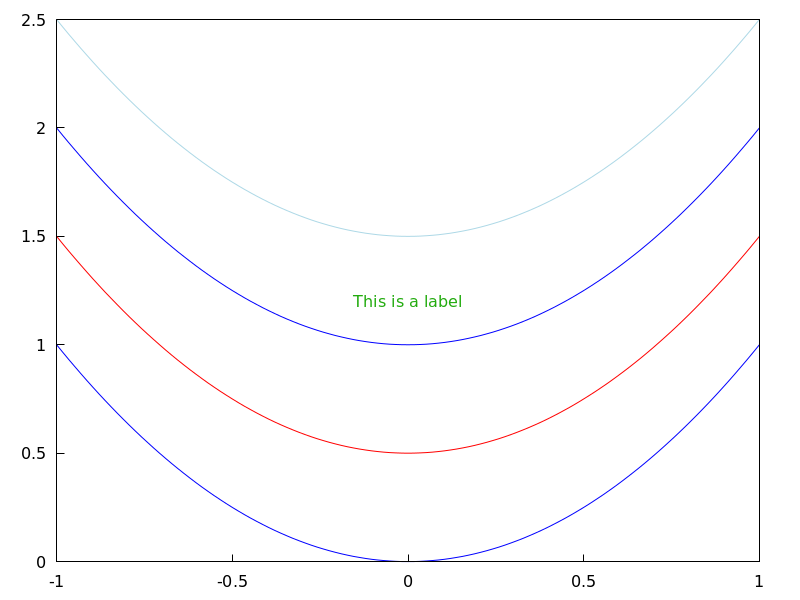
(%i1) draw2d( line_width=50, color="#FF0000", explicit(sin(x),x,0,10), color="#0000FF80", explicit(cos(x),x,0,10) );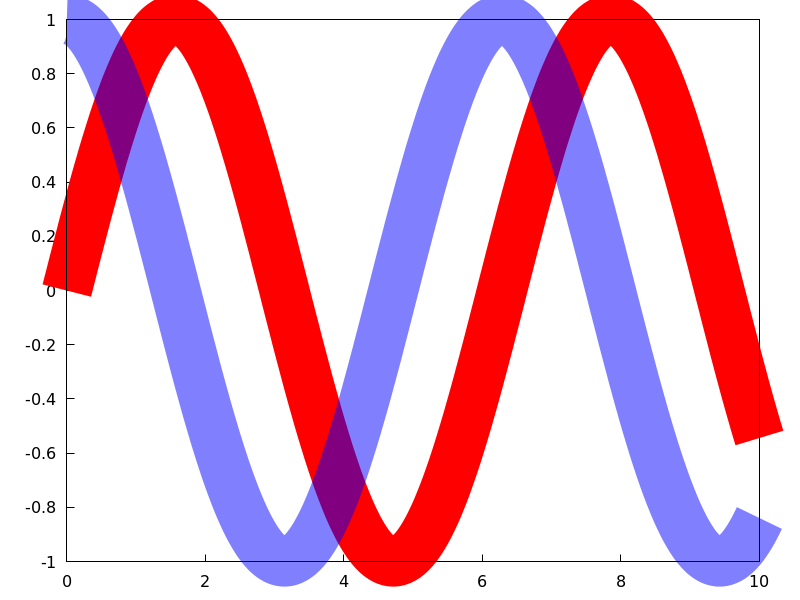
(%i1) H(p,p_0) := %i/(2*%pi*(p-p_0))$ (%i2) draw2d( proportional_axes=xy, ip_grid=[150,150], grid=true, makelist( [ color=printf(false,"#~2,'0x~2,'0x~2,'0x",i*10,0,0), key_pos=top_left, key = if mod(i,5)=0 then sconcat("H=",i,"A/M") else "", implicit( cabs(H(x+%i*y,-1-%i)+H(x+%i*y,1+%i)-H(x+%i*y,1-%i) -H(x+%i*y,-1+%i))=i/10, x,-3,3, y,-3,3 ) ], i,1,25 ) )$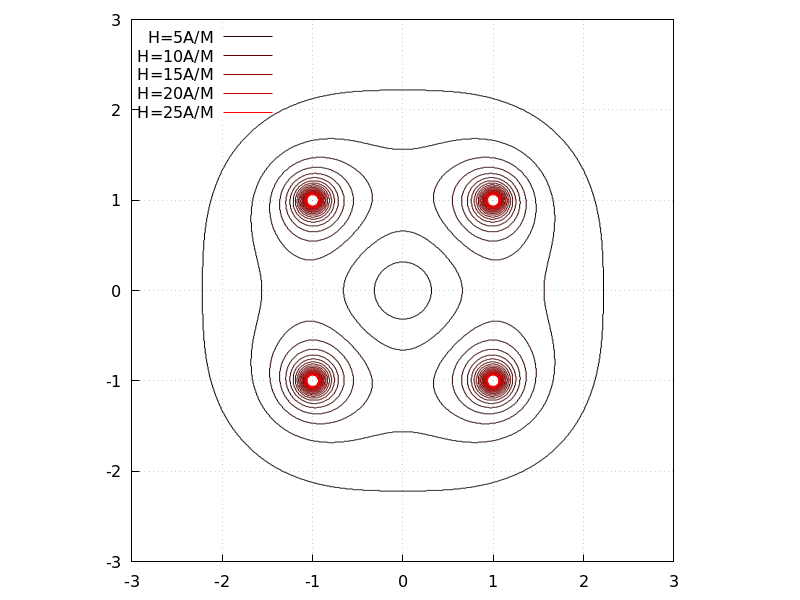
(%i1) draw2d( "figures/draw_color4", makelist( [ color=i, key=sconcat("color =",i), explicit(sin(i*x),x,0,1) ], i,0,17 ) )$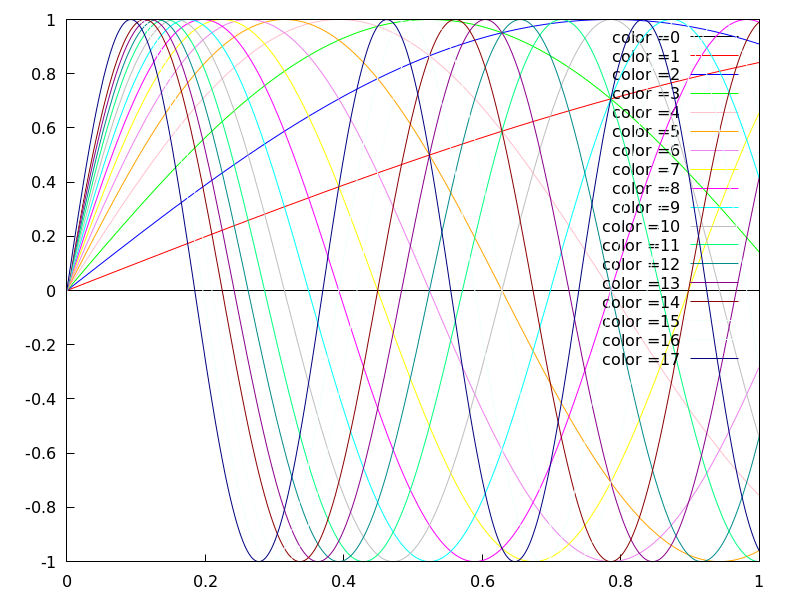
See also
fill_color.Categories: Package draw ·
- Graphic option: colorbox ¶
Default value:
trueIf
colorboxistrue, a color scale without label is drawn together withimage2D objects, or coloured 3d objects. Ifcolorboxisfalse, no color scale is shown. Ifcolorboxis a string, a color scale with label is drawn.Since this is a global graphics option, its position in the scene description does not matter.
Example:
Color scale and images.
(%i1) im: apply('matrix, makelist(makelist(random(200),i,1,30),i,1,30))$ (%i2) draw( gr2d(image(im,0,0,30,30)), gr2d(colorbox = false, image(im,0,0,30,30)) )$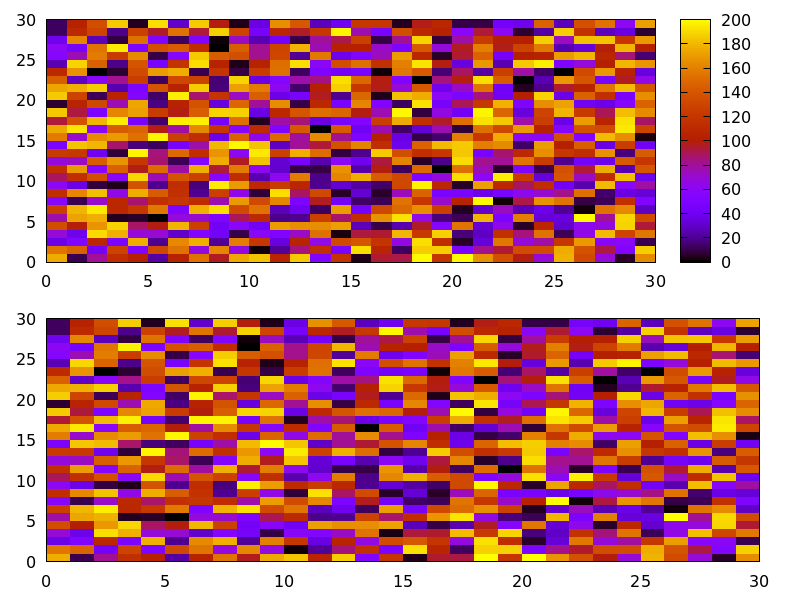
Color scale and 3D coloured object.
(%i1) draw3d( colorbox = "Magnitude", enhanced3d = true, explicit(x^2+y^2,x,-1,1,y,-1,1))$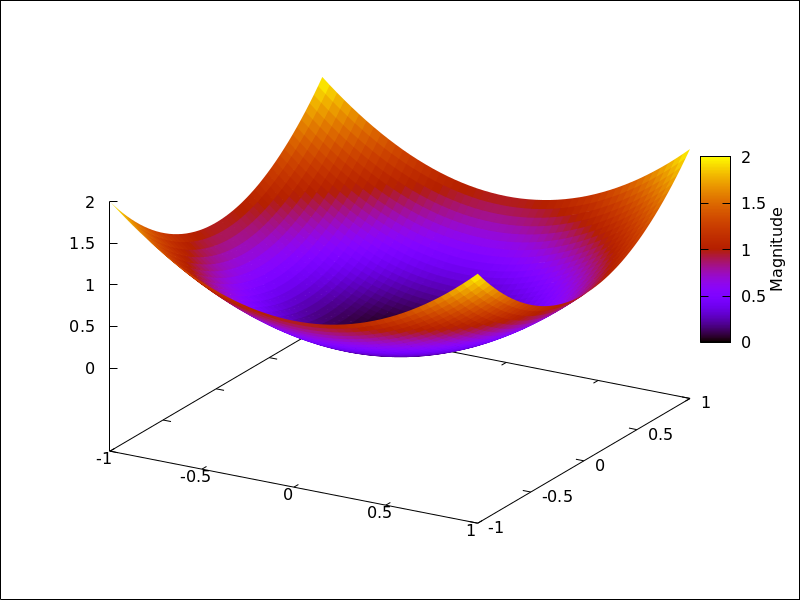
See also
palette_draw.Categories: Package draw ·
- Graphic option: columns ¶
Default value: 1
columnsis the number of columns in multiple plots.Since this is a global graphics option, its position in the scene description does not matter. It can be also used as an argument of function
draw.Example:
(%i1) scene1: gr2d(title="Ellipse", nticks=30, parametric(2*cos(t),5*sin(t),t,0,2*%pi))$ (%i2) scene2: gr2d(title="Triangle", polygon([4,5,7],[6,4,2]))$ (%i3) draw(scene1, scene2, columns = 2)$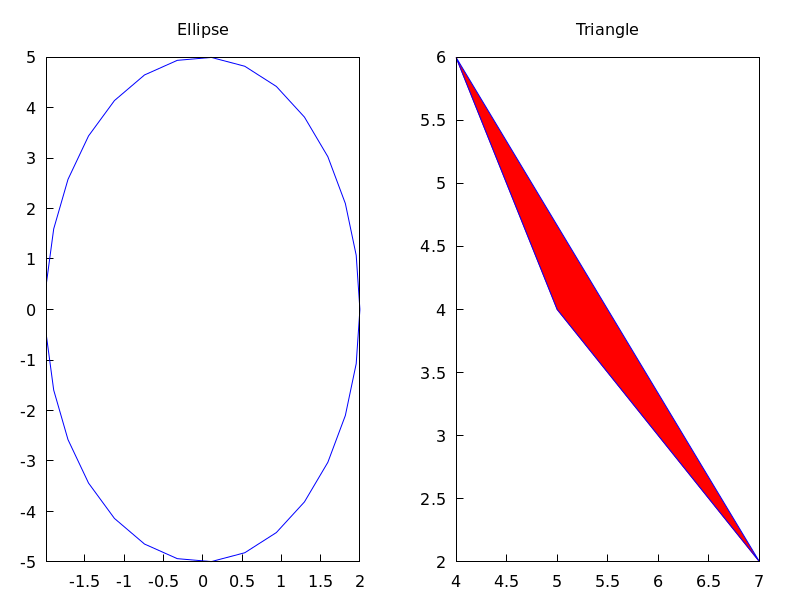 Categories: Package draw ·
Categories: Package draw ·
- Graphic option: contour ¶
Default value:
noneOption
contourenables the user to select where to plot contour lines. Possible values are:-
none: no contour lines are plotted. -
base: contour lines are projected on the xy plane. -
surface: contour lines are plotted on the surface. -
both: two contour lines are plotted: on the xy plane and on the surface. -
map: contour lines are projected on the xy plane, and the view point is set just in the vertical.
Since this is a global graphics option, its position in the scene description does not matter.
Example:
(%i1) draw3d(explicit(20*exp(-x^2-y^2)-10,x,0,2,y,-3,3), contour_levels = 15, contour = both, surface_hide = true) $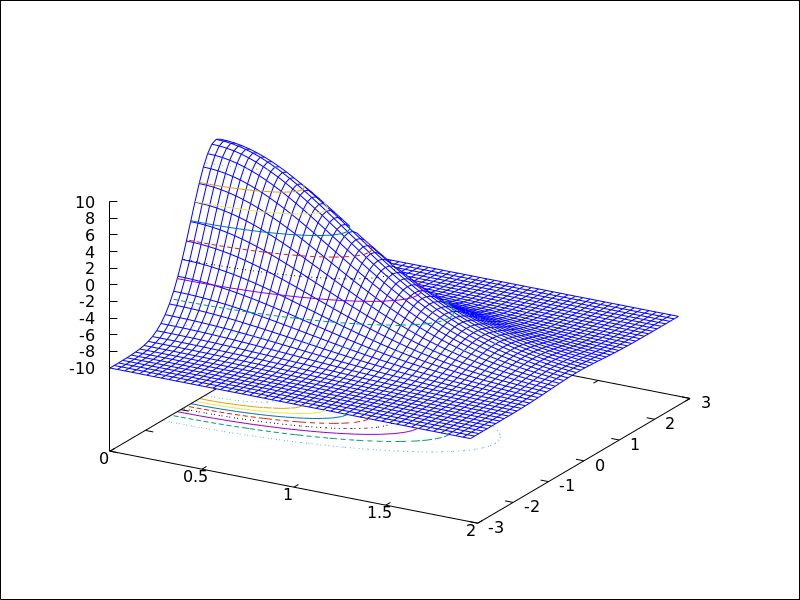
(%i1) draw3d(explicit(20*exp(-x^2-y^2)-10,x,0,2,y,-3,3), contour_levels = 15, contour = map ) $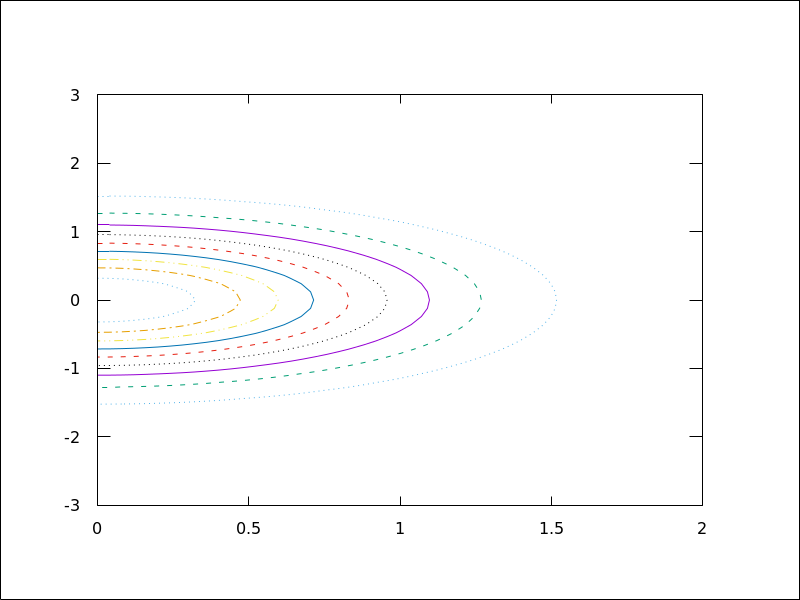 Categories: Package draw ·
Categories: Package draw ·-
- Graphic option: contour_levels ¶
Default value: 5
This graphic option controls the way contours are drawn.
contour_levelscan be set to a positive integer number, a list of three numbers or an arbitrary set of numbers:- When option
contour_levelsis bounded to positive integer n, n contour lines will be drawn at equal intervals. By default, five equally spaced contours are plotted. - When option
contour_levelsis bounded to a list of length three of the form[lowest,s,highest], contour lines are plotted fromlowesttohighestin steps ofs. - When option
contour_levelsis bounded to a set of numbers of the form{n1, n2, ...}, contour lines are plotted at valuesn1,n2, ...
Since this is a global graphics option, its position in the scene description does not matter.
Examples:
Ten equally spaced contour lines. The actual number of levels can be adjusted to give simple labels.
(%i1) draw3d(color = green, explicit(20*exp(-x^2-y^2)-10,x,0,2,y,-3,3), contour_levels = 10, contour = both, surface_hide = true) $From -8 to 8 in steps of 4.
(%i1) draw3d(color = green, explicit(20*exp(-x^2-y^2)-10,x,0,2,y,-3,3), contour_levels = [-8,4,8], contour = both, surface_hide = true) $Isolines at levels -7, -6, 0.8 and 5.
(%i1) draw3d(color = green, explicit(20*exp(-x^2-y^2)-10,x,0,2,y,-3,3), contour_levels = {-7, -6, 0.8, 5}, contour = both, surface_hide = true) $See also
contour.Categories: Package draw ·- When option
- Graphic option: data_file_name ¶
Default value:
"data.gnuplot"This is the name of the file with the numeric data needed by Gnuplot to build the requested plot.
Since this is a global graphics option, its position in the scene description does not matter. It can be also used as an argument of function
draw.See example in
gnuplot_file_name.Categories: Package draw ·
- Graphic option: delay ¶
Default value: 5
This is the delay in 1/100 seconds of frames in animated gif files.
Since this is a global graphics option, its position in the scene description does not matter. It can be also used as an argument of function
draw.Example:
(%i1) draw( delay = 100, file_name = "zzz", terminal = 'animated_gif, gr2d(explicit(x^2,x,-1,1)), gr2d(explicit(x^3,x,-1,1)), gr2d(explicit(x^4,x,-1,1))); End of animation sequence (%o2) [gr2d(explicit), gr2d(explicit), gr2d(explicit)]Option
delayis only active in animated gif’s; it is ignored in any other case.See also
terminal, anddimensions.Categories: Package draw ·
- Graphic option: dimensions ¶
Default value:
[600,500]Dimensions of the output terminal. Its value is a list formed by the width and the height. The meaning of the two numbers depends on the terminal you are working with.
With terminals
gif,animated_gif,png,jpg,svg,screen,wxt, andaquaterm, the integers represent the number of points in each direction. If they are not integers, they are rounded.With terminals
eps,eps_color,pdf, andpdfcairo, both numbers represent hundredths of cm, which means that, by default, pictures in these formats are 6 cm in width and 5 cm in height.Since this is a global graphics option, its position in the scene description does not matter. It can be also used as an argument of function
draw.Examples:
Option
dimensionsapplied to file output and to wxt canvas.(%i1) draw2d( dimensions = [300,300], terminal = 'png, explicit(x^4,x,-1,1)) $ (%i2) draw2d( dimensions = [300,300], terminal = 'wxt, explicit(x^4,x,-1,1)) $Option
dimensionsapplied to eps output. We want an eps file with A4 portrait dimensions.(%i1) A4portrait: 100*[21, 29.7]$ (%i2) draw3d( dimensions = A4portrait, terminal = 'eps, explicit(x^2-y^2,x,-2,2,y,-2,2)) $Categories: Package draw ·
- Graphic option: draw_realpart ¶
Default value:
trueWhen
true, functions to be drawn are considered as complex functions whose real part value should be plotted; whenfalse, nothing will be plotted when the function does not give a real value.This option affects objects
explicitandparametricin 2D and 3D, andparametric_surface.Example:
(%i1) draw2d( draw_realpart = false, explicit(sqrt(x^2 - 4*x) - x, x, -1, 5), color = red, draw_realpart = true, parametric(x,sqrt(x^2 - 4*x) - x + 1, x, -1, 5) );Categories: Package draw ·
- Graphic option: enhanced3d ¶
Default value:
noneIf
enhanced3disnone, surfaces are not colored in 3D plots. In order to get a colored surface, a list must be assigned to optionenhanced3d, where the first element is an expression and the rest are the names of the variables or parameters used in that expression. A list such[f(x,y,z), x, y, z]means that point[x,y,z]of the surface is assigned numberf(x,y,z), which will be colored according to the actualpalette. For those 3D graphic objects defined in terms of parameters, it is possible to define the color number in terms of the parameters, as in[f(u), u], as in objectsparametricandtube, or[f(u,v), u, v], as in objectparametric_surface. While all 3D objects admit the model based on absolute coordinates,[f(x,y,z), x, y, z], only two of them, namelyexplicitandelevation_grid, accept also models defined on the[x,y]coordinates,[f(x,y), x, y]. 3D graphic objectimplicitaccepts only the[f(x,y,z), x, y, z]model. Objectpointsaccepts also the[f(x,y,z), x, y, z]model, but when points have a chronological nature, model[f(k), k]is also valid, beingkan ordering parameter.When
enhanced3dis assigned something different tonone, optionscolorandsurface_hideare ignored.The names of the variables defined in the lists may be different to those used in the definitions of the graphic objects.
In order to maintain back compatibility,
enhanced3d = falseis equivalent toenhanced3d = none, andenhanced3d = trueis equivalent toenhanced3d = [z, x, y, z]. If an expression is given toenhanced3d, its variables must be the same used in the surface definition. This is not necessary when using lists.See option
paletteto learn how palettes are specified.Examples:
explicitobject with coloring defined by the[f(x,y,z), x, y, z]model.(%i1) draw3d( enhanced3d = [x-z/10,x,y,z], palette = gray, explicit(20*exp(-x^2-y^2)-10,x,-3,3,y,-3,3))$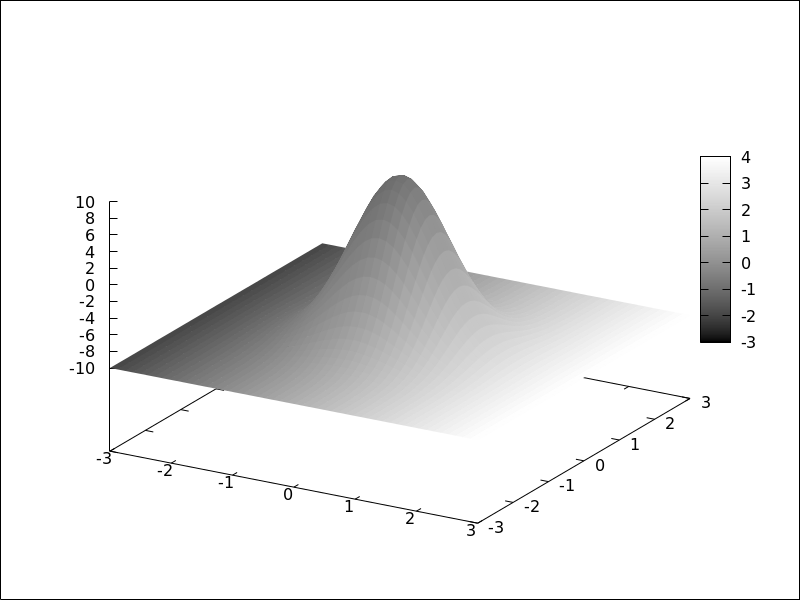
explicitobject with coloring defined by the[f(x,y), x, y]model. The names of the variables defined in the lists may be different to those used in the definitions of the graphic objects; in this case,rcorresponds tox, andstoy.(%i1) draw3d( enhanced3d = [sin(r*s),r,s], explicit(20*exp(-x^2-y^2)-10,x,-3,3,y,-3,3))$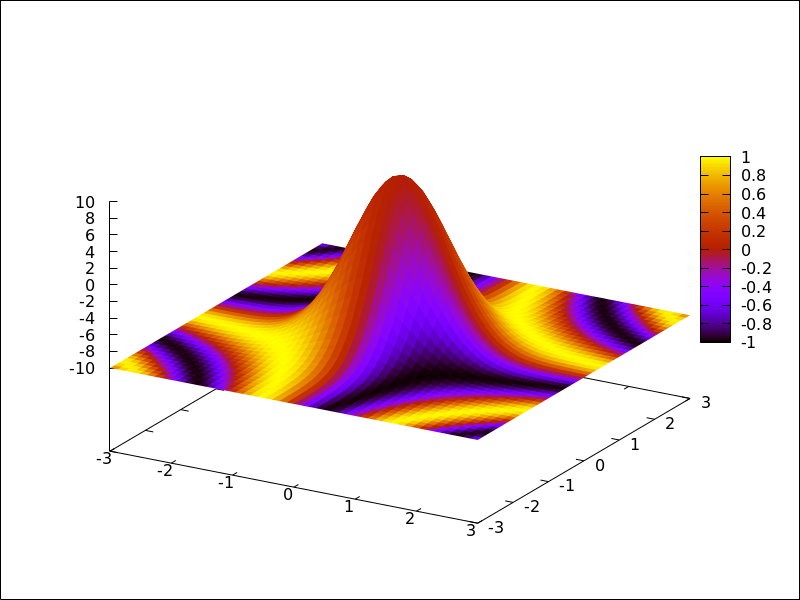
parametricobject with coloring defined by the[f(x,y,z), x, y, z]model.(%i1) draw3d( nticks = 100, line_width = 2, enhanced3d = [if y>= 0 then 1 else 0, x, y, z], parametric(sin(u)^2,cos(u),u,u,0,4*%pi)) $
parametricobject with coloring defined by the[f(u), u]model. In this case,(u-1)^2is a shortcut for[(u-1)^2,u].(%i1) draw3d( nticks = 60, line_width = 3, enhanced3d = (u-1)^2, parametric(cos(5*u)^2,sin(7*u),u-2,u,0,2))$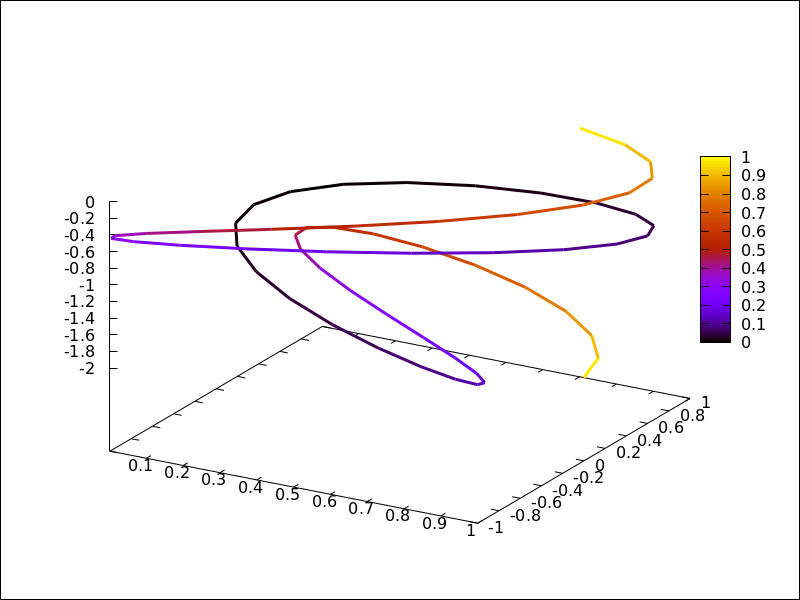
elevation_gridobject with coloring defined by the[f(x,y), x, y]model.(%i1) m: apply( matrix, makelist(makelist(cos(i^2/80-k/30),k,1,30),i,1,20)) $ (%i2) draw3d( enhanced3d = [cos(x*y*10),x,y], elevation_grid(m,-1,-1,2,2), xlabel = "x", ylabel = "y");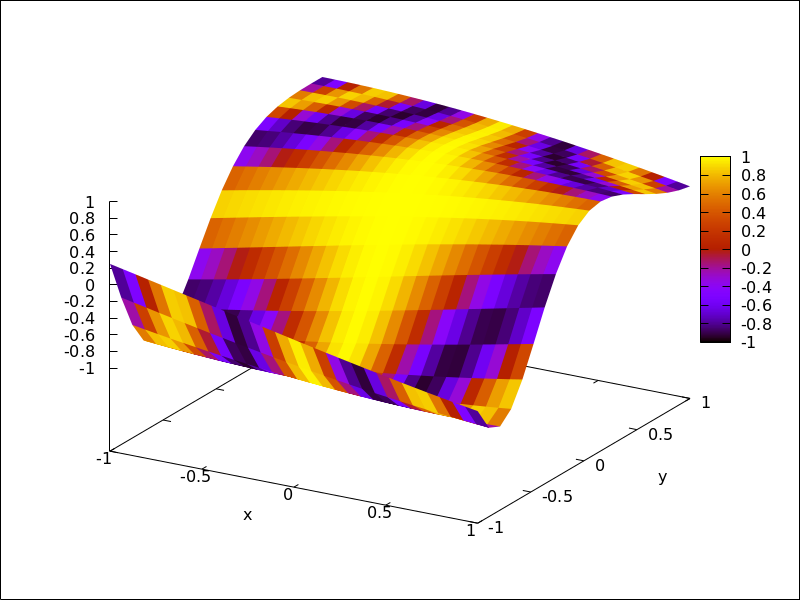
tubeobject with coloring defined by the[f(x,y,z), x, y, z]model.(%i1) draw3d( enhanced3d = [cos(x-y),x,y,z], palette = gray, xu_grid = 50, tube(cos(a), a, 0, 1, a, 0, 4*%pi) )$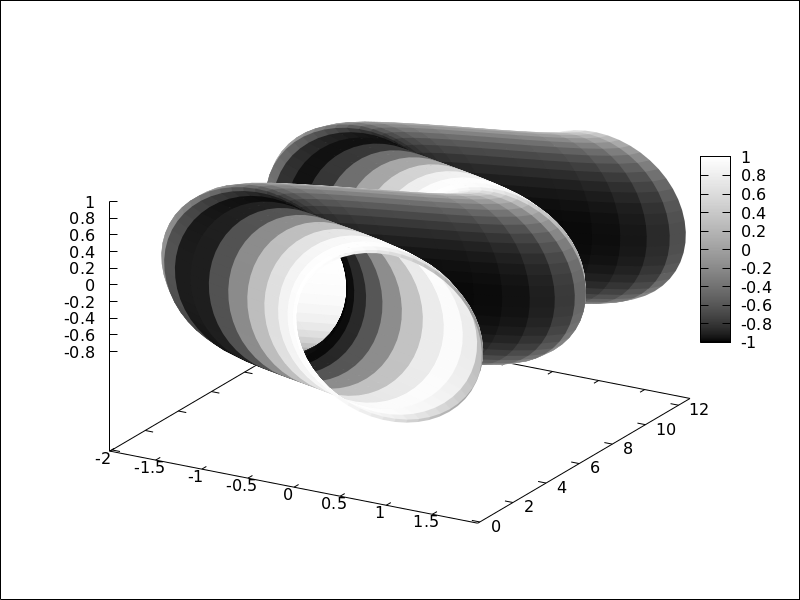
tubeobject with coloring defined by the[f(u), u]model. Here,enhanced3d = -awould be the shortcut forenhanced3d = [-foo,foo].(%i1) draw3d( capping = [true, false], palette = [26,15,-2], enhanced3d = [-foo, foo], tube(a, a, a^2, 1, a, -2, 2) )$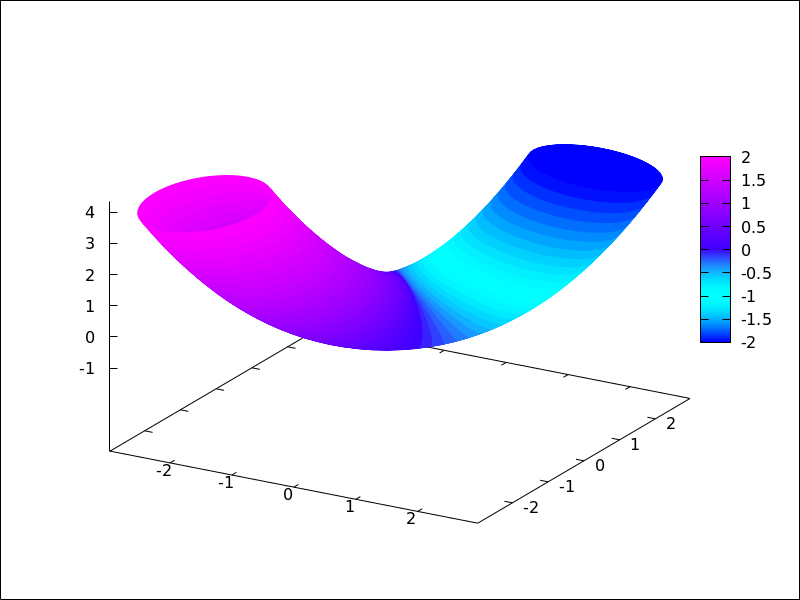
implicitandpointsobjects with coloring defined by the[f(x,y,z), x, y, z]model.(%i1) draw3d( enhanced3d = [x-y,x,y,z], implicit((x^2+y^2+z^2-1)*(x^2+(y-1.5)^2+z^2-0.5)=0.015, x,-1,1,y,-1.2,2.3,z,-1,1)) $ (%i2) m: makelist([random(1.0),random(1.0),random(1.0)],k,1,2000)$
(%i3) draw3d( point_type = filled_circle, point_size = 2, enhanced3d = [u+v-w,u,v,w], points(m) ) $
When points have a chronological nature, model
[f(k), k]is also valid, beingkan ordering parameter.(%i1) m:makelist([random(1.0), random(1.0), random(1.0)],k,1,5)$ (%i2) draw3d( enhanced3d = [sin(j), j], point_size = 3, point_type = filled_circle, points_joined = true, points(m)) $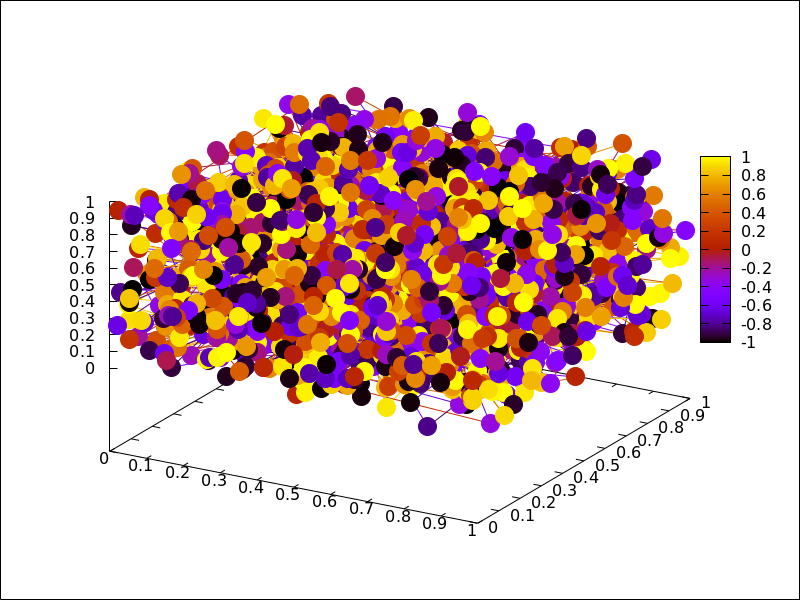 Categories: Package draw ·
Categories: Package draw ·
- Graphic option: error_type ¶
Default value:
yDepending on its value, which can be
x,y, orxy, graphic objecterrorswill draw points with horizontal, vertical, or both, error bars. Whenerror_type=boxes, boxes will be drawn instead of crosses.See also
errors.
- Graphic option: file_name ¶
Default value:
"maxima_out"This is the name of the file where terminals
png,jpg,gif,eps,eps_color,pdf,pdfcairoandsvgwill save the graphic.Since this is a global graphics option, its position in the scene description does not matter. It can be also used as an argument of function
draw.Example:
(%i1) draw2d(file_name = "myfile", explicit(x^2,x,-1,1), terminal = 'png)$See also
terminal,dimensions_draw.Categories: Package draw ·
- Graphic option: fill_color ¶
Default value:
"red"fill_colorspecifies the color for filling polygons and 2dexplicitfunctions.See
colorto learn how colors are specified.Categories: Package draw ·
- Graphic option: fill_density ¶
Default value: 0
fill_densityis a number between 0 and 1 that specifies the intensity of thefill_colorinbarsobjects.See
barsfor examples.
- Graphic option: filled_func ¶
Default value:
falseOption
filled_funccontrols how regions limited by functions should be filled. Whenfilled_funcistrue, the region bounded by the function defined with objectexplicitand the bottom of the graphic window is filled withfill_color. Whenfilled_funccontains a function expression, then the region bounded by this function and the function defined with objectexplicitwill be filled. By default, explicit functions are not filled.A useful special case is
filled_func=0, which generates the region bond by the horizontal axis and the explicit function.This option affects only the 2d graphic object
explicit.Example:
Region bounded by an
explicitobject and the bottom of the graphic window.(%i1) draw2d(fill_color = red, filled_func = true, explicit(sin(x),x,0,10) )$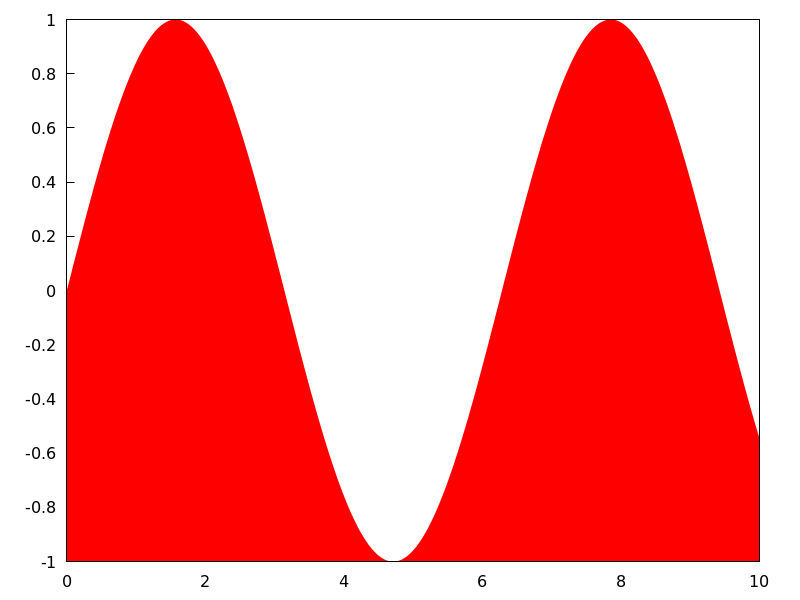
Region bounded by an
explicitobject and the function defined by optionfilled_func. Note that the variable infilled_funcmust be the same as that used inexplicit.(%i1) draw2d(fill_color = grey, filled_func = sin(x), explicit(-sin(x),x,0,%pi));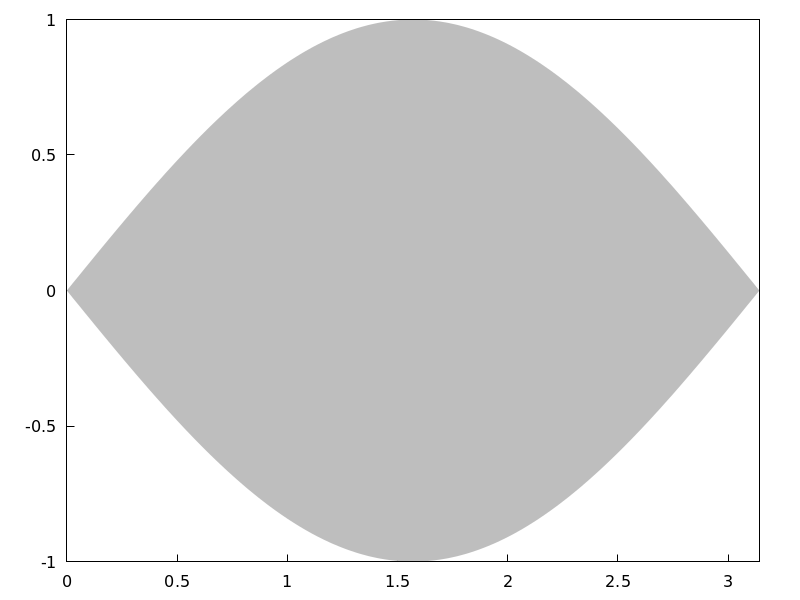
See also
fill_colorandexplicit.Categories: Package draw ·
- Graphic option: font ¶
Default value:
""(empty string)This option can be used to set the font face to be used by the terminal. Only one font face and size can be used throughout the plot.
Since this is a global graphics option, its position in the scene description does not matter.
See also
font_size.Gnuplot doesn’t handle fonts by itself, it leaves this task to the support libraries of the different terminals, each one with its own philosophy about it. A brief summary follows:
- x11:
Uses the normal x11 font server mechanism.
Example:
(%i1) draw2d(font = "Arial", font_size = 20, label(["Arial font, size 20",1,1]))$ - windows: The windows terminal doesn’t support changing of fonts from inside the plot. Once the plot has been generated, the font can be changed right-clicking on the menu of the graph window.
- png, jpeg, gif:
The libgd library uses the font path stored in the environment
variable
GDFONTPATH; in this case, it is only necessary to set optionfontto the font’s name. It is also possible to give the complete path to the font file.Examples:
Option
fontcan be given the complete path to the font file:(%i1) path: "/usr/share/fonts/truetype/freefont/" $ (%i2) file: "FreeSerifBoldItalic.ttf" $ (%i3) draw2d( font = concat(path, file), font_size = 20, color = red, label(["FreeSerifBoldItalic font, size 20",1,1]), terminal = png)$If environment variable
GDFONTPATHis set to the path where font files are allocated, it is possible to set graphic optionfontto the name of the font.(%i1) draw2d( font = "FreeSerifBoldItalic", font_size = 20, color = red, label(["FreeSerifBoldItalic font, size 20",1,1]), terminal = png)$ - Postscript:
Standard Postscript fonts are:
"Times-Roman","Times-Italic","Times-Bold","Times-BoldItalic",
"Helvetica","Helvetica-Oblique","Helvetica-Bold",
"Helvetic-BoldOblique","Courier","Courier-Oblique","Courier-Bold",
and"Courier-BoldOblique".Example:
(%i1) draw2d( font = "Courier-Oblique", font_size = 15, label(["Courier-Oblique font, size 15",1,1]), terminal = eps)$ - pdf: Uses same fonts as Postscript.
- pdfcairo: Uses same fonts as wxt.
- wxt:
The pango library finds fonts via the
fontconfigutility. - aqua:
Default is
"Times-Roman".
The gnuplot documentation is an important source of information about terminals and fonts.
Categories: Package draw ·- x11:
Uses the normal x11 font server mechanism.
- Graphic option: font_size ¶
Default value: 10
This option can be used to set the font size to be used by the terminal. Only one font face and size can be used throughout the plot.
font_sizeis active only when optionfontis not equal to the empty string.Since this is a global graphics option, its position in the scene description does not matter.
See also
font.Categories: Package draw ·
- Graphic option: gnuplot_file_name ¶
Default value:
"maxout_xxx.gnuplot"with"xxx"being a number that is unique to each concurrently-running maxima process.This is the name of the file with the necessary commands to be processed by Gnuplot.
Since this is a global graphics option, its position in the scene description does not matter. It can be also used as an argument of function
draw.Example:
(%i1) draw2d( file_name = "my_file", gnuplot_file_name = "my_commands_for_gnuplot", data_file_name = "my_data_for_gnuplot", terminal = png, explicit(x^2,x,-1,1)) $See also
data_file_name.Categories: Package draw ·
- Graphic option: grid ¶
Default value:
falseIf
gridisnot false, a grid will be drawn on the xy plane. Ifgridis assigned true, one grid line per tick of each axis is drawn. Ifgridis assigned a listnx,nywith[nx,ny] > [0,0]insteadnxlines per tick of the x axis andnylines per tick of the y axis are drawn.Since this is a global graphics option, its position in the scene description does not matter.
Example:
(%i1) draw2d(grid = true, explicit(exp(u),u,-2,2))$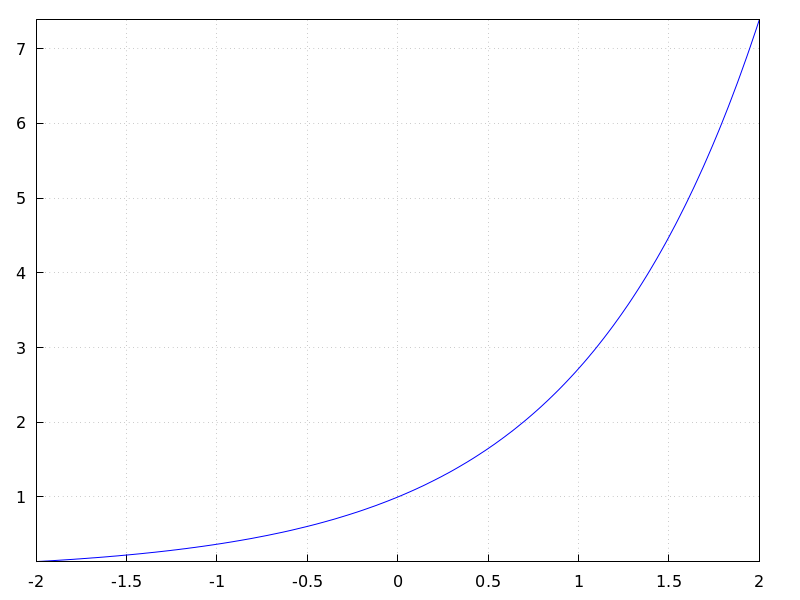
(%i1) draw2d(grid = [2,2], explicit(sin(x),x,0,2*%pi))$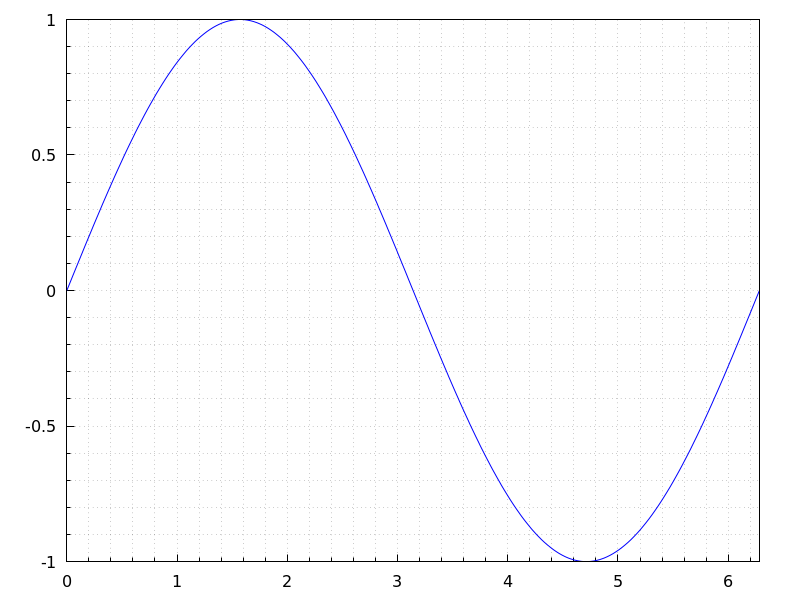 Categories: Package draw ·
Categories: Package draw ·
- Graphic option: head_angle ¶
Default value: 45
head_angleindicates the angle, in degrees, between the arrow heads and the segment.This option is relevant only for
vectorobjects.Example:
(%i1) draw2d(xrange = [0,10], yrange = [0,9], head_length = 0.7, head_angle = 10, vector([1,1],[0,6]), head_angle = 20, vector([2,1],[0,6]), head_angle = 30, vector([3,1],[0,6]), head_angle = 40, vector([4,1],[0,6]), head_angle = 60, vector([5,1],[0,6]), head_angle = 90, vector([6,1],[0,6]), head_angle = 120, vector([7,1],[0,6]), head_angle = 160, vector([8,1],[0,6]), head_angle = 180, vector([9,1],[0,6]) )$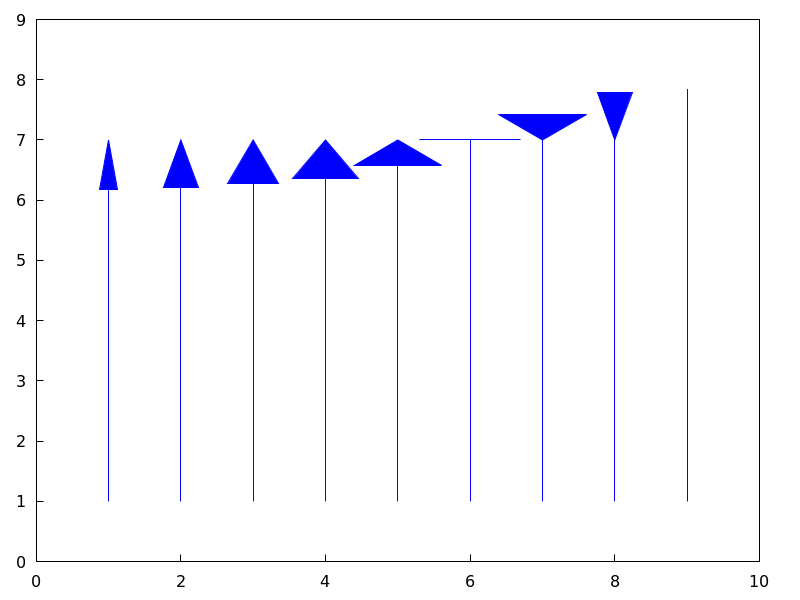
See also
head_both,head_length, andhead_type.Categories: Package draw ·
- Graphic option: head_both ¶
Default value:
falseIf
head_bothistrue, vectors are plotted with two arrow heads. Iffalse, only one arrow is plotted.This option is relevant only for
vectorobjects.Example:
(%i1) draw2d(xrange = [0,8], yrange = [0,8], head_length = 0.7, vector([1,1],[6,0]), head_both = true, vector([1,7],[6,0]) )$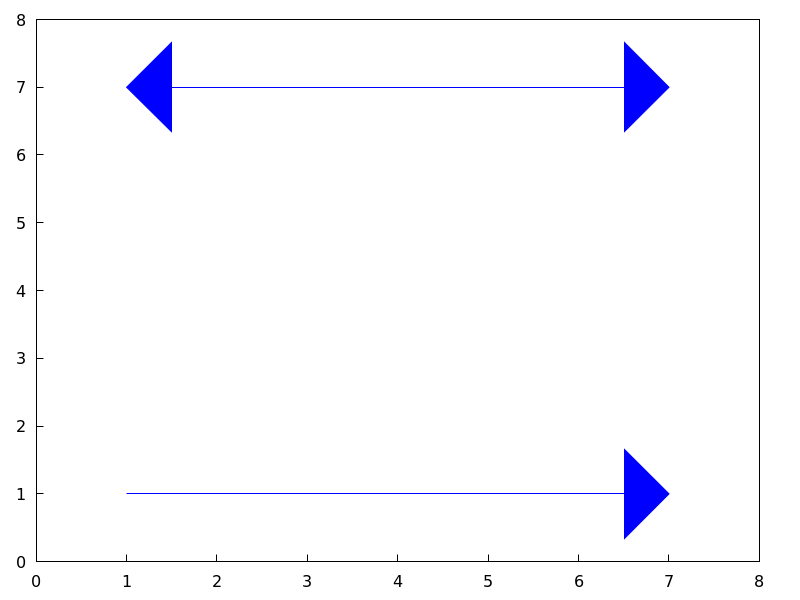
See also
head_length,head_angle, andhead_type.Categories: Package draw ·
- Graphic option: head_length ¶
Default value: 2
head_lengthindicates, in x-axis units, the length of arrow heads.This option is relevant only for
vectorobjects.Example:
(%i1) draw2d(xrange = [0,12], yrange = [0,8], vector([0,1],[5,5]), head_length = 1, vector([2,1],[5,5]), head_length = 0.5, vector([4,1],[5,5]), head_length = 0.25, vector([6,1],[5,5]))$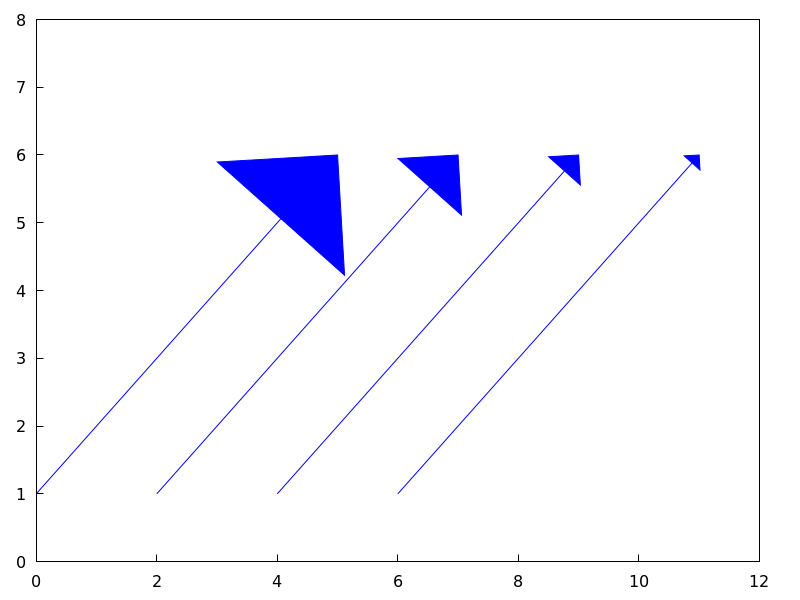
See also
head_both,head_angle, andhead_type.Categories: Package draw ·
- Graphic option: head_type ¶
Default value:
filledhead_typeis used to specify how arrow heads are plotted. Possible values are:filled(closed and filled arrow heads),empty(closed but not filled arrow heads), andnofilled(open arrow heads).This option is relevant only for
vectorobjects.Example:
(%i1) draw2d(xrange = [0,12], yrange = [0,10], head_length = 1, vector([0,1],[5,5]), /* default type */ head_type = 'empty, vector([3,1],[5,5]), head_type = 'nofilled, vector([6,1],[5,5]))$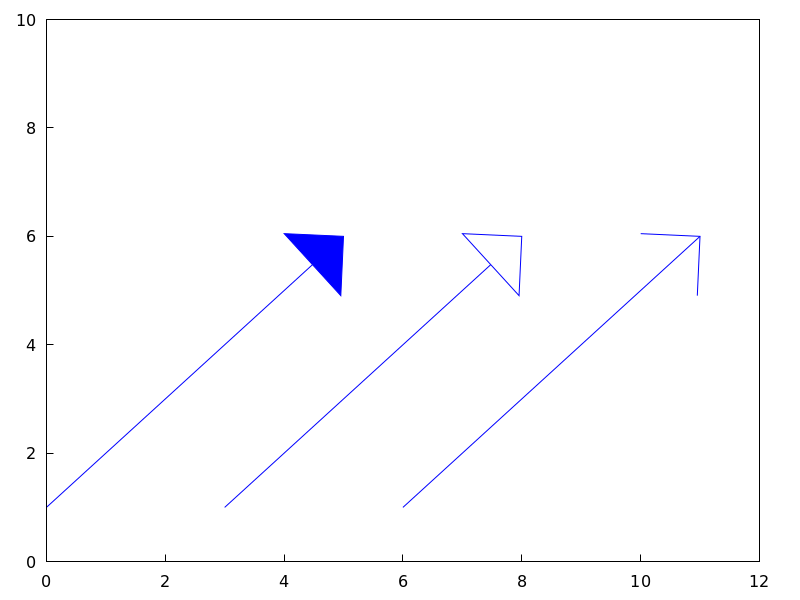
See also
head_both,head_angle, andhead_length.Categories: Package draw ·
- Graphic option: interpolate_color ¶
Default value:
falseThis option is relevant only when
enhanced3dis notfalse.When
interpolate_colorisfalse, surfaces are colored with homogeneous quadrangles. Whentrue, color transitions are smoothed by interpolation.interpolate_coloralso accepts a list of two numbers,[m,n]. For positive m and n, each quadrangle or triangle is interpolated m times and n times in the respective direction. For negative m and n, the interpolation frequency is chosen so that there will be at least |m| and |n| points drawn; you can consider this as a special gridding function. Zeros, i.e.interpolate_color=[0,0], will automatically choose an optimal number of interpolated surface points.Also,
interpolate_color=trueis equivalent tointerpolate_color=[0,0].Examples:
Color interpolation with explicit functions.
(%i1) draw3d( enhanced3d = sin(x*y), explicit(20*exp(-x^2-y^2)-10, x ,-3, 3, y, -3, 3)) $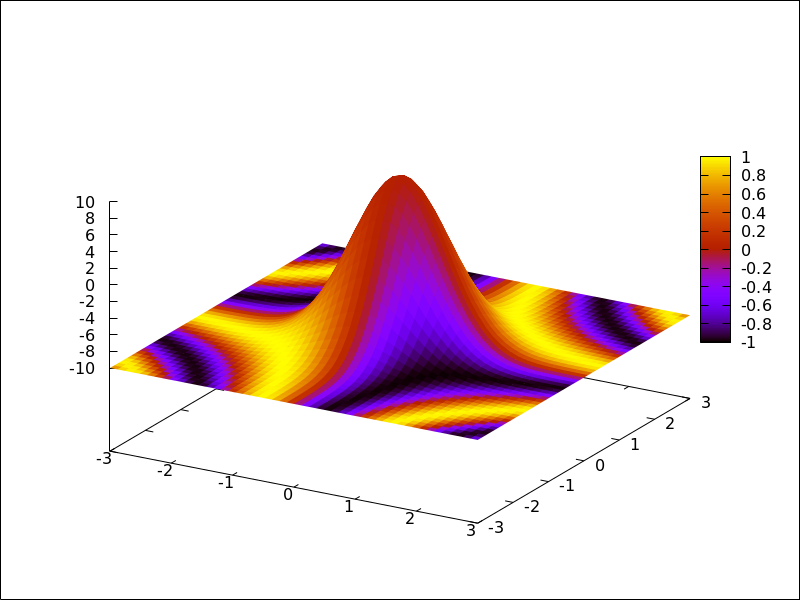
(%i2) draw3d( interpolate_color = true, enhanced3d = sin(x*y), explicit(20*exp(-x^2-y^2)-10, x ,-3, 3, y, -3, 3)) $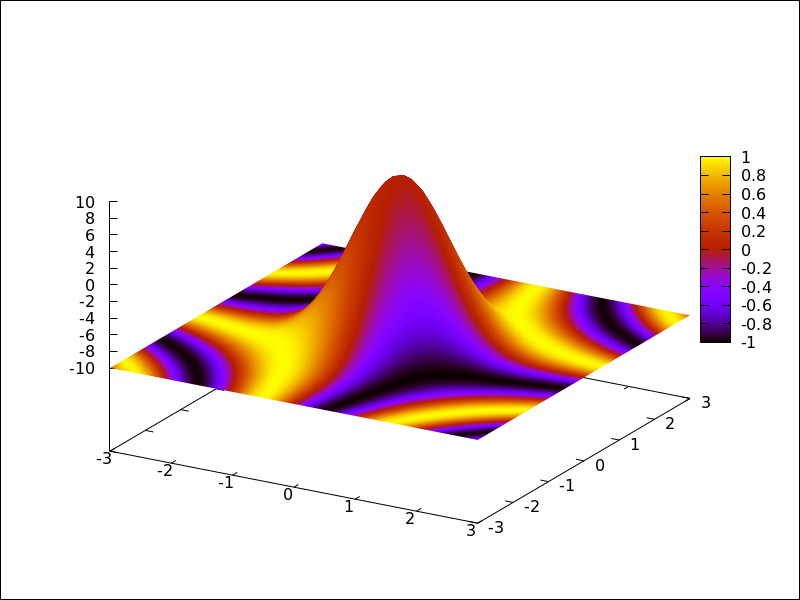
(%i3) draw3d( interpolate_color = [-10,0], enhanced3d = sin(x*y), explicit(20*exp(-x^2-y^2)-10, x ,-3, 3, y, -3, 3)) $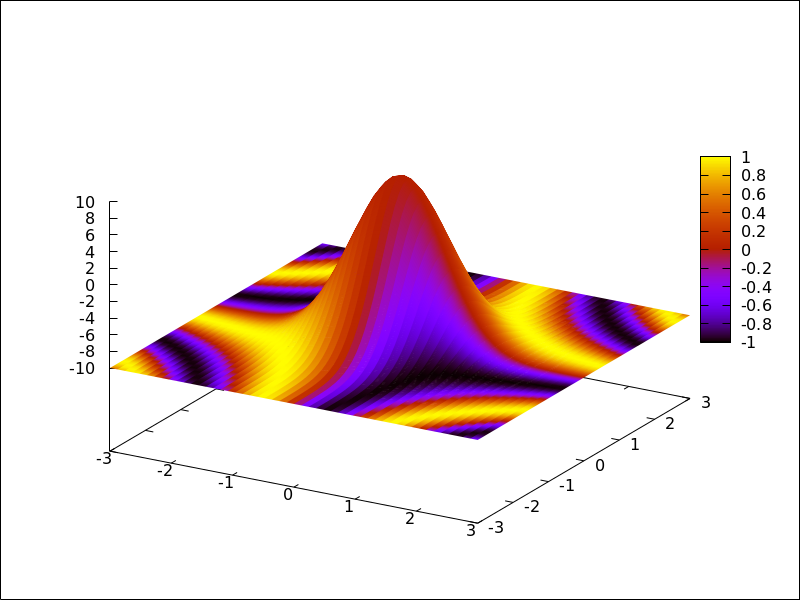
Color interpolation with the
meshgraphic object.Interpolating colors in parametric surfaces can give unexpected results.
(%i1) draw3d( enhanced3d = true, mesh([[1,1,3], [7,3,1],[12,-2,4],[15,0,5]], [[2,7,8], [4,3,1],[10,5,8], [12,7,1]], [[-2,11,10],[6,9,5],[6,15,1], [20,15,2]])) $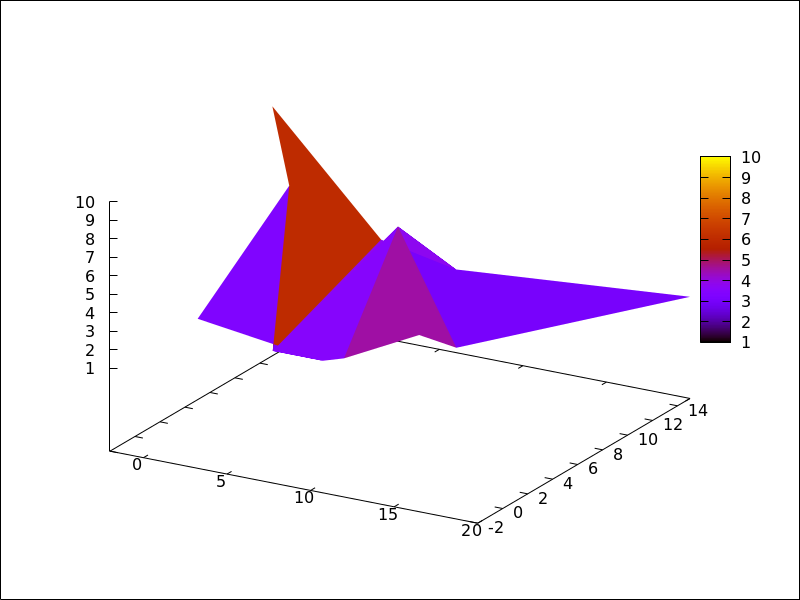
(%i2) draw3d( enhanced3d = true, interpolate_color = true, mesh([[1,1,3], [7,3,1],[12,-2,4],[15,0,5]], [[2,7,8], [4,3,1],[10,5,8], [12,7,1]], [[-2,11,10],[6,9,5],[6,15,1], [20,15,2]])) $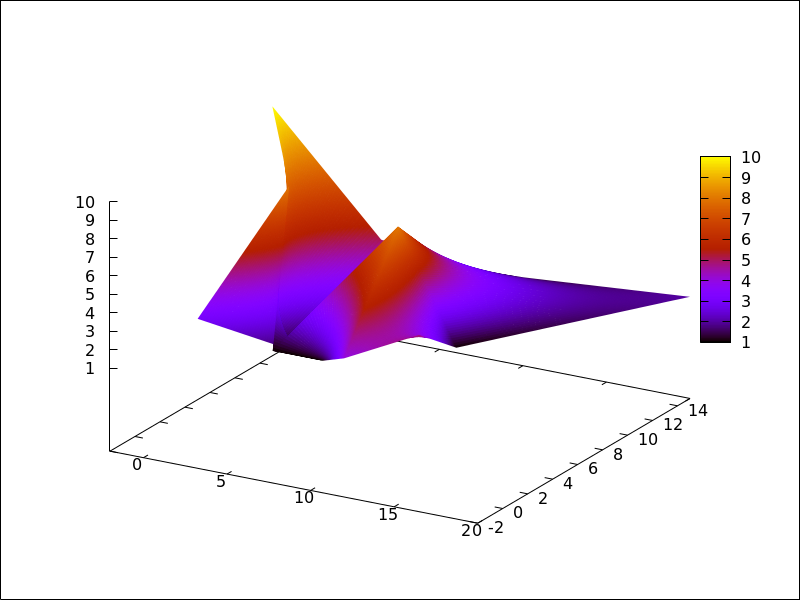
(%i3) draw3d( enhanced3d = true, interpolate_color = true, view=map, mesh([[1,1,3], [7,3,1],[12,-2,4],[15,0,5]], [[2,7,8], [4,3,1],[10,5,8], [12,7,1]], [[-2,11,10],[6,9,5],[6,15,1], [20,15,2]])) $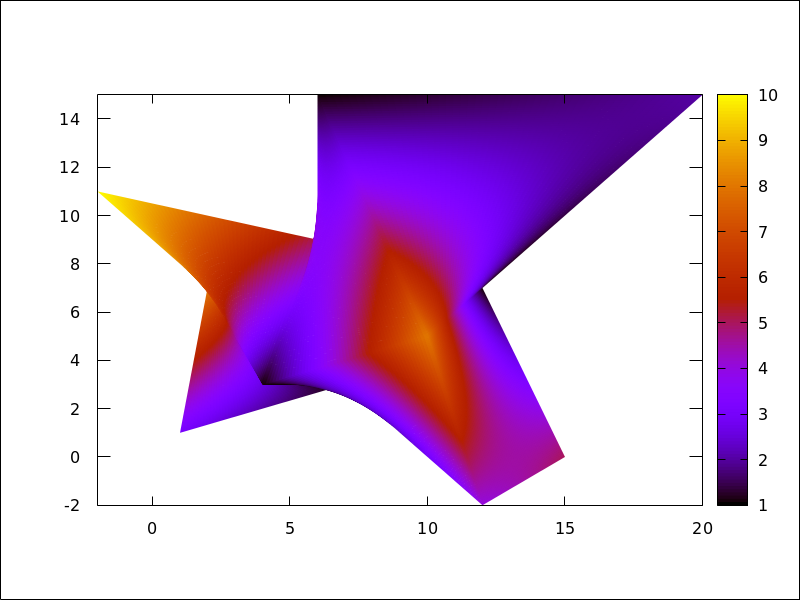
See also
enhanced3d.Categories: Package draw ·
- Graphic option: ip_grid ¶
Default value:
[50, 50]ip_gridsets the grid for the first sampling in implicit plots.This option is relevant only for
implicitobjects.Categories: Package draw ·
- Graphic option: ip_grid_in ¶
Default value:
[5, 5]ip_grid_insets the grid for the second sampling in implicit plots.This option is relevant only for
implicitobjects.Categories: Package draw ·
- Graphic option: key ¶
Default value:
""(empty string)keyis the name of a function in the legend. Ifkeyis an empty string, no key is assigned to the function.This option affects the following graphic objects:
-
gr2d:points,polygon,rectangle,ellipse,vector,explicit,implicit,parametricandpolar. -
gr3d:points,explicit,parametricandparametric_surface.
Example:
(%i1) draw2d(key = "Sinus", explicit(sin(x),x,0,10), key = "Cosinus", color = red, explicit(cos(x),x,0,10) )$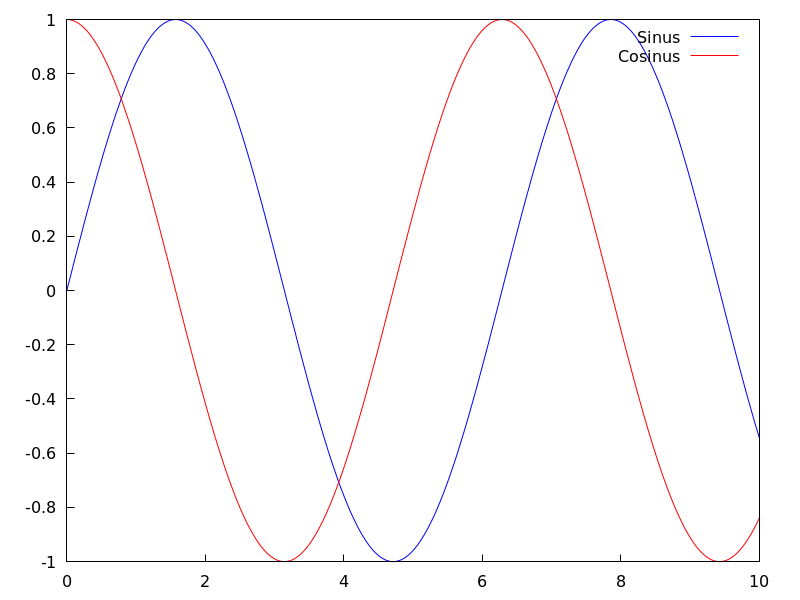 Categories: Package draw ·
Categories: Package draw ·-
- Graphic option: key_pos ¶
Default value:
""(empty string)key_posdefines at which position the legend will be drawn. Ifkeyis an empty string,"top_right"is used. Available position specifiers are:top_left,top_center,top_right,center_left,center,center_right,bottom_left,bottom_center, andbottom_right.Since this is a global graphics option, its position in the scene description does not matter.
Example:
(%i1) draw2d( key_pos = top_left, key = "x", explicit(x, x,0,10), color= red, key = "x squared", explicit(x^2,x,0,10))$ (%i3) draw3d( key_pos = center, key = "x", explicit(x+y,x,0,10,y,0,10), color= red, key = "x squared", explicit(x^2+y^2,x,0,10,y,0,10))$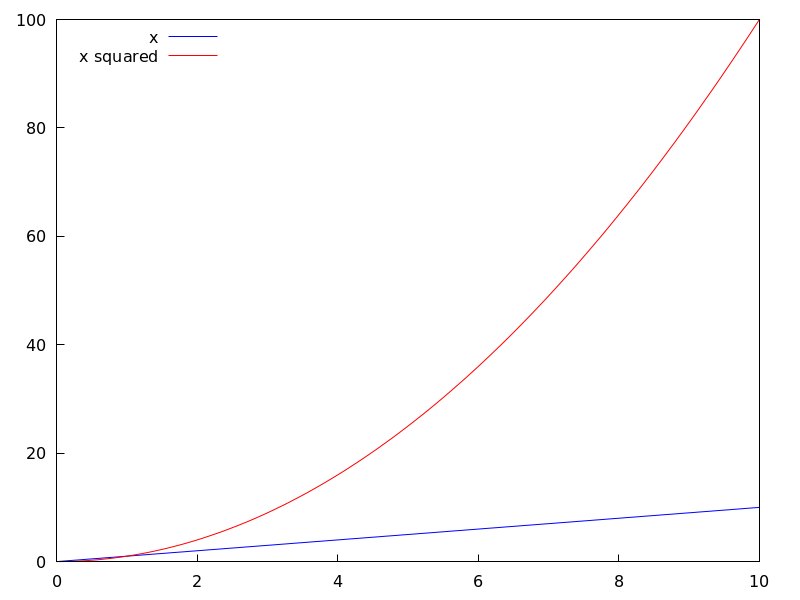 Categories: Package draw ·
Categories: Package draw ·
- Graphic option: label_alignment ¶
Default value:
centerlabel_alignmentis used to specify where to write labels with respect to the given coordinates. Possible values are:center,left, andright.This option is relevant only for
labelobjects.Example:
(%i1) draw2d(xrange = [0,10], yrange = [0,10], points_joined = true, points([[5,0],[5,10]]), color = blue, label(["Centered alignment (default)",5,2]), label_alignment = 'left, label(["Left alignment",5,5]), label_alignment = 'right, label(["Right alignment",5,8]))$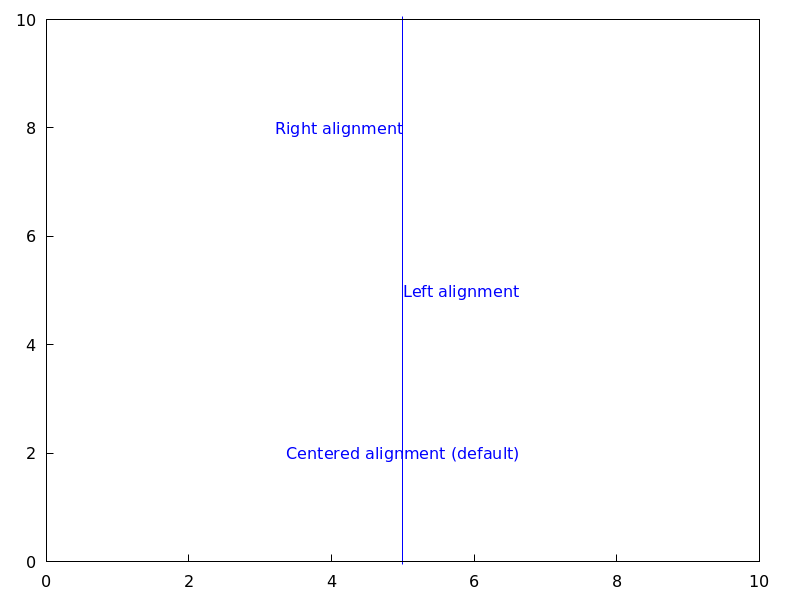
See also
label_orientation, andcolorCategories: Package draw ·
- Graphic option: label_orientation ¶
Default value:
horizontallabel_orientationis used to specify orientation of labels. Possible values are:horizontal, andvertical.This option is relevant only for
labelobjects.Example:
In this example, a dummy point is added to get an image. Package
drawneeds always data to draw an scene.(%i1) draw2d(xrange = [0,10], yrange = [0,10], point_size = 0, points([[5,5]]), color = navy, label(["Horizontal orientation (default)",5,2]), label_orientation = 'vertical, color = "#654321", label(["Vertical orientation",1,5]))$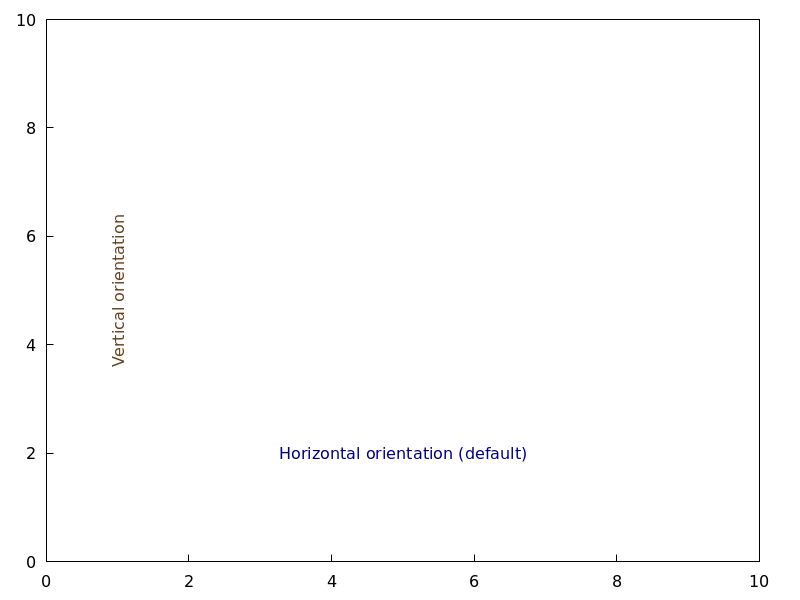
See also
label_alignmentandcolorCategories: Package draw ·
- Graphic option: line_type ¶
Default value:
solidline_typeindicates how lines are displayed; possible values aresolidanddots, both available in all terminals, anddashes,short_dashes,short_long_dashes,short_short_long_dashes, anddot_dash, which are not available inpng,jpg, andgifterminals.This option affects the following graphic objects:
-
gr2d:points,polygon,rectangle,ellipse,vector,explicit,implicit,parametricandpolar. -
gr3d:points,explicit,parametricandparametric_surface.
Example:
(%i1) draw2d(line_type = dots, explicit(1 + x^2,x,-1,1), line_type = solid, /* default */ explicit(2 + x^2,x,-1,1))$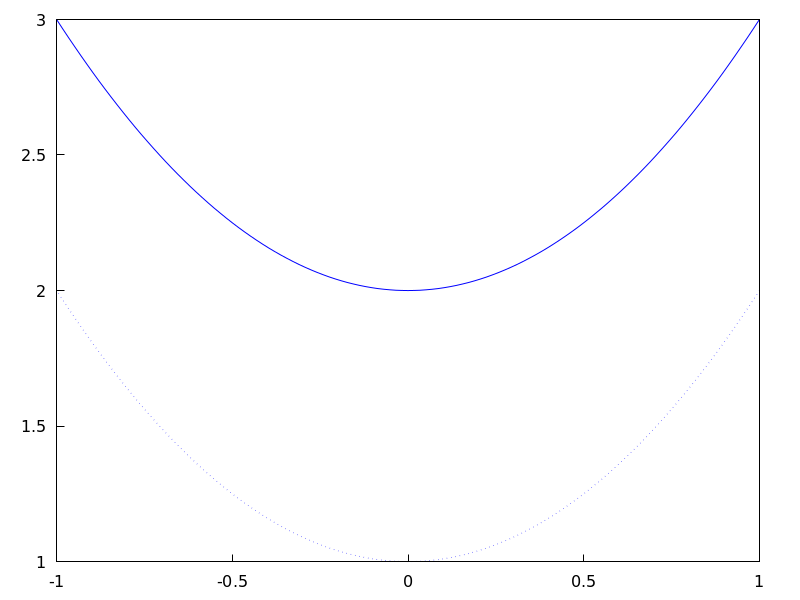
See also
line_width.Categories: Package draw ·-
- Graphic option: line_width ¶
Default value: 1
line_widthis the width of plotted lines. Its value must be a positive number.This option affects the following graphic objects:
-
gr2d:points,polygon,rectangle,ellipse,vector,explicit,implicit,parametricandpolar. -
gr3d:pointsandparametric.
Example:
(%i1) draw2d(explicit(x^2,x,-1,1), /* default width */ line_width = 5.5, explicit(1 + x^2,x,-1,1), line_width = 10, explicit(2 + x^2,x,-1,1))$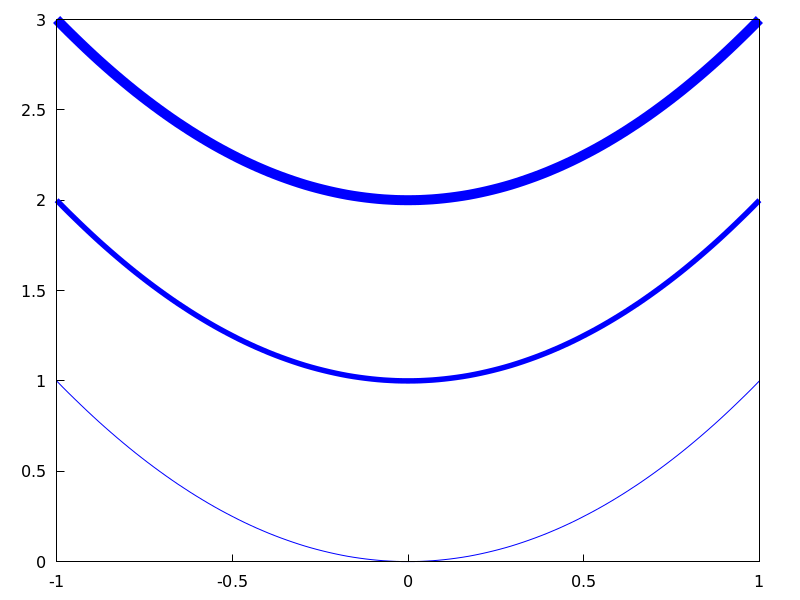
See also
line_type.Categories: Package draw ·-
- Graphic option: logcb ¶
Default value:
falseIf
logcbistrue, the tics in the colorbox will be drawn in the logarithmic scale.When
enhanced3dorcolorboxisfalse, optionlogcbhas no effect.Since this is a global graphics option, its position in the scene description does not matter.
Example:
(%i1) draw3d ( enhanced3d = true, color = green, logcb = true, logz = true, palette = [-15,24,-9], explicit(exp(x^2-y^2), x,-2,2,y,-2,2)) $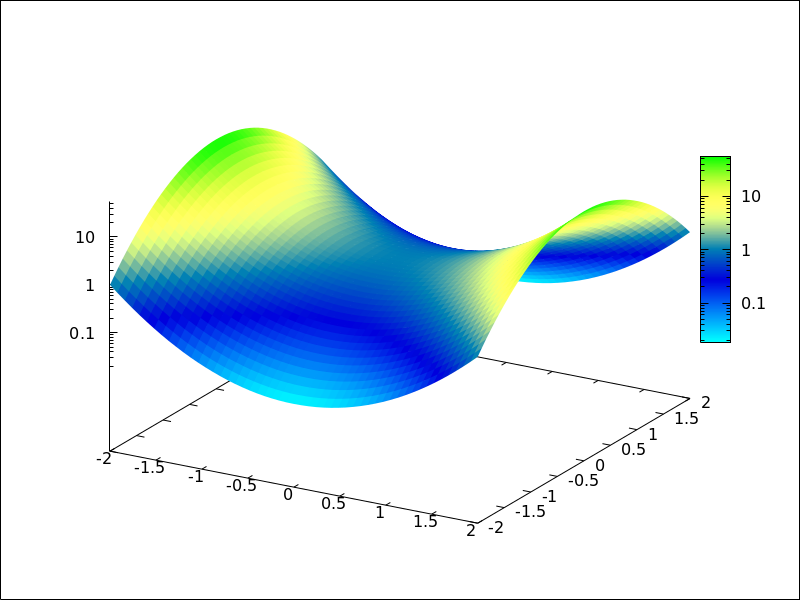
See also
enhanced3d,colorboxandcbrange.Categories: Package draw ·
- Graphic option: logx ¶
Default value:
falseIf
logxistrue, the x axis will be drawn in the logarithmic scale.Since this is a global graphics option, its position in the scene description does not matter, with the exception that it should be written before any 2D
explicitobject, so thatdrawcan produce a better plot.Example:
(%i1) draw2d(logx = true, explicit(log(x),x,0.01,5))$See also
logy,logx_secondary,logy_secondary, andlogz.Categories: Package draw ·
- Graphic option: logx_secondary ¶
Default value:
falseIf
logx_secondaryistrue, the secondary x axis will be drawn in the logarithmic scale.This option is relevant only for 2d scenes.
Since this is a global graphics option, its position in the scene description does not matter.
Example:
(%i1) draw2d( grid = true, key="x^2, linear scale", color=red, explicit(x^2,x,1,100), xaxis_secondary = true, xtics_secondary = true, logx_secondary = true, key = "x^2, logarithmic x scale", color = blue, explicit(x^2,x,1,100) )$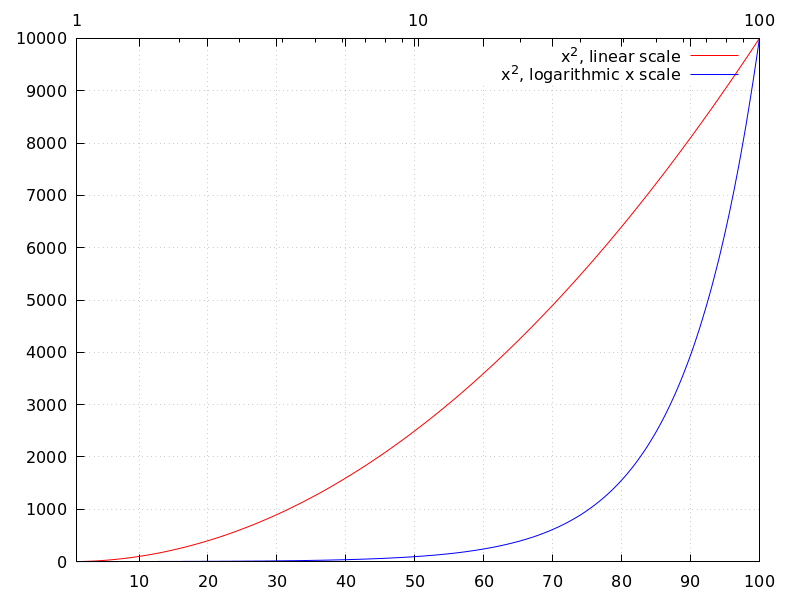
See also
logx_draw,logy_draw,logy_secondary, andlogz.Categories: Package draw ·
- Graphic option: logy ¶
Default value:
falseIf
logyistrue, the y axis will be drawn in the logarithmic scale.Since this is a global graphics option, its position in the scene description does not matter.
Example:
(%i1) draw2d(logy = true, explicit(exp(x),x,0,5))$See also
logx_draw,logx_secondary,logy_secondary, andlogz.Categories: Package draw ·
- Graphic option: logy_secondary ¶
Default value:
falseIf
logy_secondaryistrue, the secondary y axis will be drawn in the logarithmic scale.This option is relevant only for 2d scenes.
Since this is a global graphics option, its position in the scene description does not matter.
Example:
(%i1) draw2d( grid = true, key="x^2, linear scale", color=red, explicit(x^2,x,1,100), yaxis_secondary = true, ytics_secondary = true, logy_secondary = true, key = "x^2, logarithmic y scale", color = blue, explicit(x^2,x,1,100) )$See also
logx_draw,logy_draw,logx_secondary, andlogz.Categories: Package draw ·
- Graphic option: logz ¶
Default value:
falseIf
logzistrue, the z axis will be drawn in the logarithmic scale.Since this is a global graphics option, its position in the scene description does not matter.
Example:
(%i1) draw3d(logz = true, explicit(exp(u^2+v^2),u,-2,2,v,-2,2))$See also
logx_drawandlogy_draw.Categories: Package draw ·
- Graphic option: nticks ¶
Default value: 29
In 2d,
nticksgives the initial number of points used by the adaptive plotting routine for explicit objects. It is also the number of points that will be shown in parametric and polar curves.This option affects the following graphic objects:
-
gr2d:ellipse,explicit,parametricandpolar. -
gr3d:parametric.
See also
adapt_depthExample:
(%i1) draw2d(transparent = true, ellipse(0,0,4,2,0,180), nticks = 5, ellipse(0,0,4,2,180,180) )$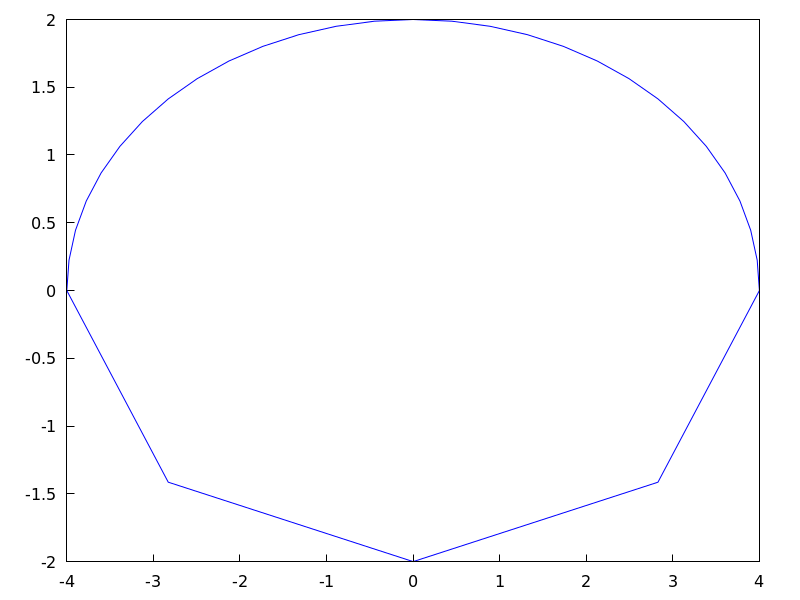 Categories: Package draw ·
Categories: Package draw ·-
- Graphic option: palette ¶
Default value:
colorpaletteindicates how to map gray levels onto color components. It works together with optionenhanced3din 3D graphics, who associates every point of a surfaces to a real number or gray level. It also works with gray images. Withpalette, levels are transformed into colors.There are two ways for defining these transformations.
First,
palettecan be a vector of length three with components ranging from -36 to +36; each value is an index for a formula mapping the levels onto red, green and blue colors, respectively:0: 0 1: 0.5 2: 1 3: x 4: x^2 5: x^3 6: x^4 7: sqrt(x) 8: sqrt(sqrt(x)) 9: sin(90x) 10: cos(90x) 11: |x-0.5| 12: (2x-1)^2 13: sin(180x) 14: |cos(180x)| 15: sin(360x) 16: cos(360x) 17: |sin(360x)| 18: |cos(360x)| 19: |sin(720x)| 20: |cos(720x)| 21: 3x 22: 3x-1 23: 3x-2 24: |3x-1| 25: |3x-2| 26: (3x-1)/2 27: (3x-2)/2 28: |(3x-1)/2| 29: |(3x-2)/2| 30: x/0.32-0.78125 31: 2*x-0.84 32: 4x;1;-2x+1.84;x/0.08-11.5 33: |2*x - 0.5| 34: 2*x 35: 2*x - 0.5 36: 2*x - 1
negative numbers mean negative colour component.
palette = grayandpalette = colorare short cuts forpalette = [3,3,3]andpalette = [7,5,15], respectively.Second,
palettecan be a user defined lookup table. In this case, the format for building a lookup table of lengthnispalette=[color_1, color_2, ..., color_n], wherecolor_iis a well formed color (see optioncolor) such thatcolor_1is assigned to the lowest gray level andcolor_nto the highest. The rest of colors are interpolated.Since this is a global graphics option, its position in the scene description does not matter.
Examples:
It works together with option
enhanced3din 3D graphics.(%i1) draw3d( enhanced3d = [z-x+2*y,x,y,z], palette = [32, -8, 17], explicit(20*exp(-x^2-y^2)-10,x,-3,3,y,-3,3))$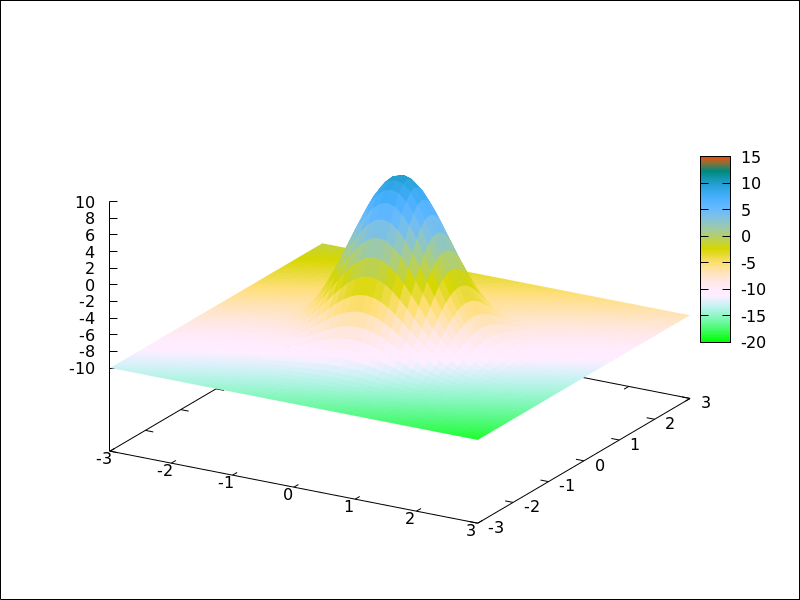
It also works with gray images.
(%i1) im: apply( 'matrix, makelist(makelist(random(200),i,1,30),i,1,30))$ (%i2) /* palette = color, default */ draw2d(image(im,0,0,30,30))$ (%i3) draw2d(palette = gray, image(im,0,0,30,30))$ (%i4) draw2d(palette = [15,20,-4], colorbox=false, image(im,0,0,30,30))$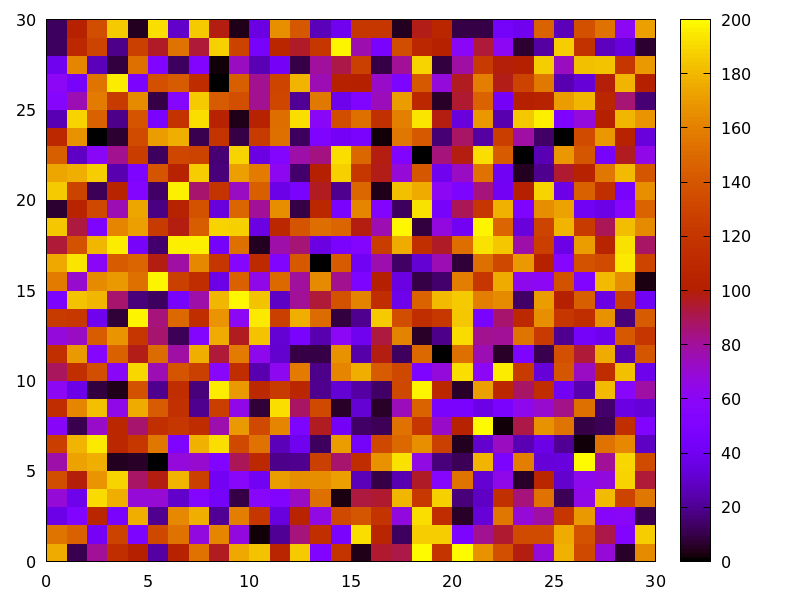
palettecan be a user defined lookup table. In this example, low values ofxare colored in red, and higher values in yellow.(%i1) draw3d( palette = [red, blue, yellow], enhanced3d = x, explicit(x^2+y^2,x,-1,1,y,-1,1)) $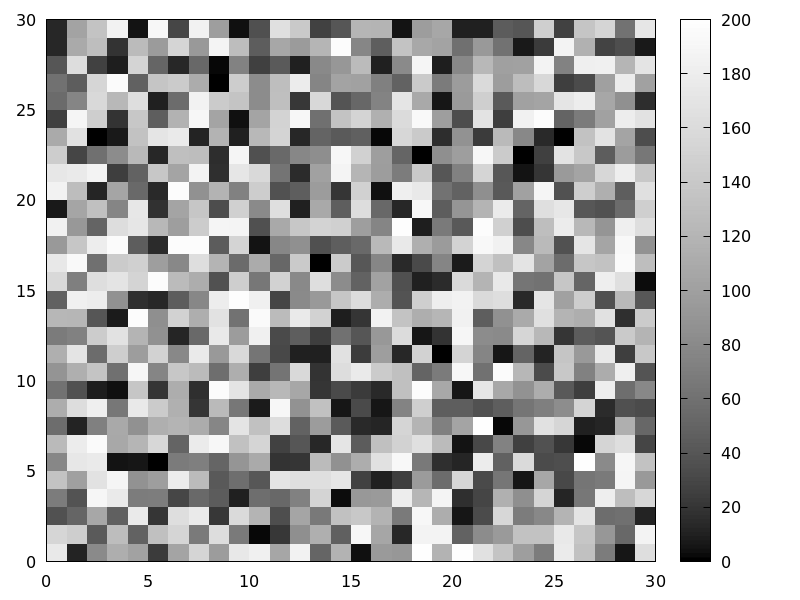
See also
colorboxandenhanced3d.Categories: Package draw ·
- Graphic option: point_size ¶
Default value: 1
point_sizesets the size for plotted points. It must be a non negative number.This option has no effect when graphic option
point_typeis set todot.This option affects the following graphic objects:
Example:
(%i1) draw2d(points(makelist([random(20),random(50)],k,1,10)), point_size = 5, points(makelist(k,k,1,20),makelist(random(30),k,1,20)))$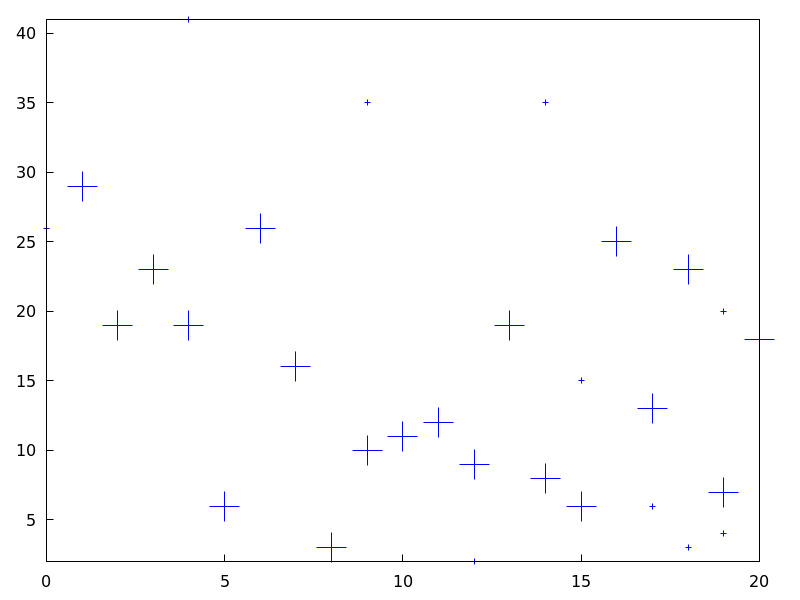 Categories: Package draw ·
Categories: Package draw ·
- Graphic option: point_type ¶
Default value: 1
point_typeindicates how isolated points are displayed; the value of this option can be any integer index greater or equal than -1, or the name of a point style:$none(-1),dot(0),plus(1),multiply(2),asterisk(3),square(4),filled_square(5),circle(6),filled_circle(7),up_triangle(8),filled_up_triangle(9),down_triangle(10),filled_down_triangle(11),diamant(12) andfilled_diamant(13).This option affects the following graphic objects:
Example:
(%i1) draw2d(xrange = [0,10], yrange = [0,10], point_size = 3, point_type = diamant, points([[1,1],[5,1],[9,1]]), point_type = filled_down_triangle, points([[1,2],[5,2],[9,2]]), point_type = asterisk, points([[1,3],[5,3],[9,3]]), point_type = filled_diamant, points([[1,4],[5,4],[9,4]]), point_type = 5, points([[1,5],[5,5],[9,5]]), point_type = 6, points([[1,6],[5,6],[9,6]]), point_type = filled_circle, points([[1,7],[5,7],[9,7]]), point_type = 8, points([[1,8],[5,8],[9,8]]), point_type = filled_diamant, points([[1,9],[5,9],[9,9]]) )$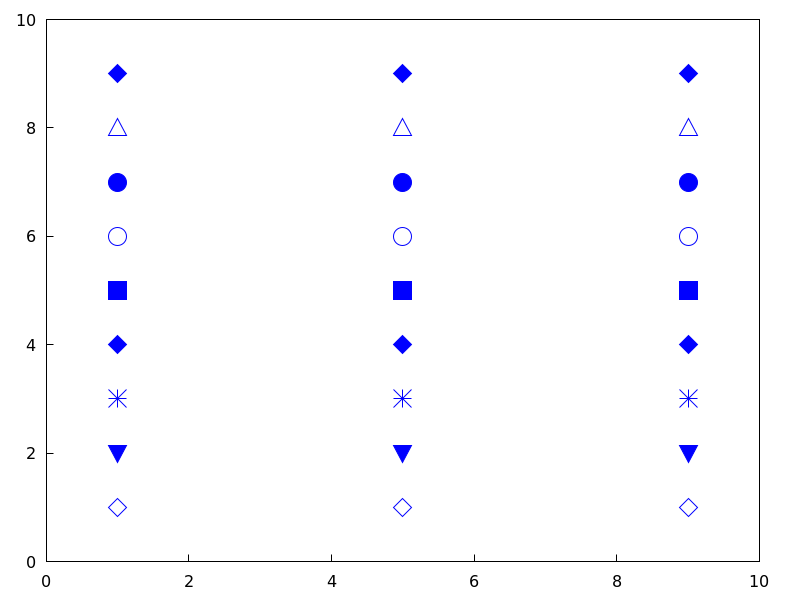 Categories: Package draw ·
Categories: Package draw ·
- Graphic option: points_joined ¶
Default value:
falseWhen
points_joinedistrue, points are joined by lines; whenfalse, isolated points are drawn. A third possible value for this graphic option isimpulses; in such case, vertical segments are drawn from points to the x-axis (2D) or to the xy-plane (3D).This option affects the following graphic objects:
Example:
(%i1) draw2d(xrange = [0,10], yrange = [0,4], point_size = 3, point_type = up_triangle, color = blue, points([[1,1],[5,1],[9,1]]), points_joined = true, point_type = square, line_type = dots, points([[1,2],[5,2],[9,2]]), point_type = circle, color = red, line_width = 7, points([[1,3],[5,3],[9,3]]) )$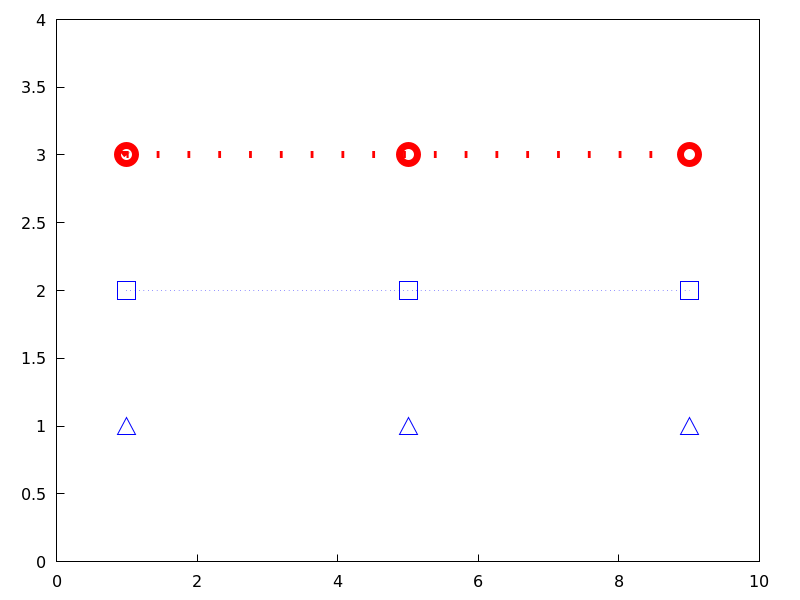 Categories: Package draw ·
Categories: Package draw ·
- Graphic option: proportional_axes ¶
Default value:
noneWhen
proportional_axesis equal toxyorxyz, the aspect ratio of the axis units will be set to 1:1 resulting in a 2D or 3D scene that will be drawn with axes proportional to their relative lengths.Since this is a global graphics option, its position in the scene description does not matter.
This option works with Gnuplot version 4.2.6 or greater.
Examples:
Single 2D plot.
(%i1) draw2d( ellipse(0,0,1,1,0,360), transparent=true, color = blue, line_width = 4, ellipse(0,0,2,1/2,0,360), proportional_axes = 'xy) $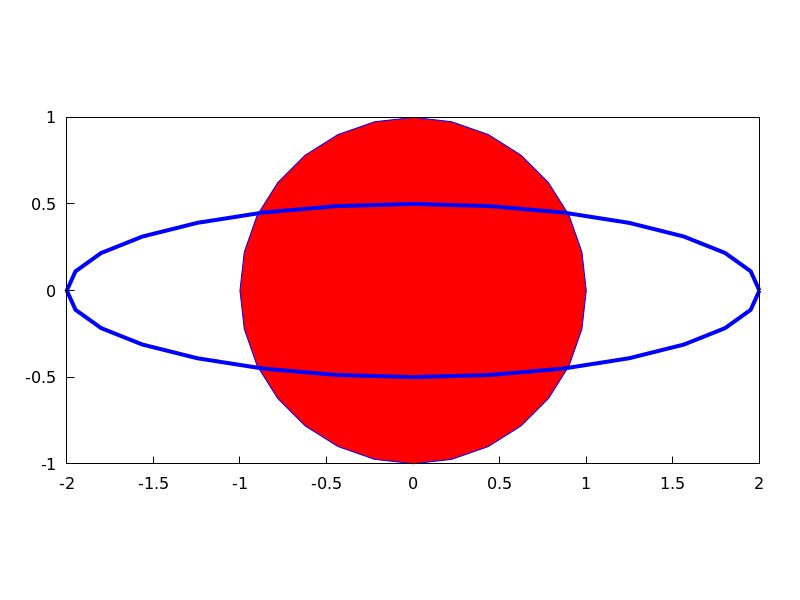
Multiplot.
(%i1) draw( terminal = wxt, gr2d(proportional_axes = 'xy, explicit(x^2,x,0,1)), gr2d(explicit(x^2,x,0,1), xrange = [0,1], yrange = [0,2], proportional_axes='xy), gr2d(explicit(x^2,x,0,1)))$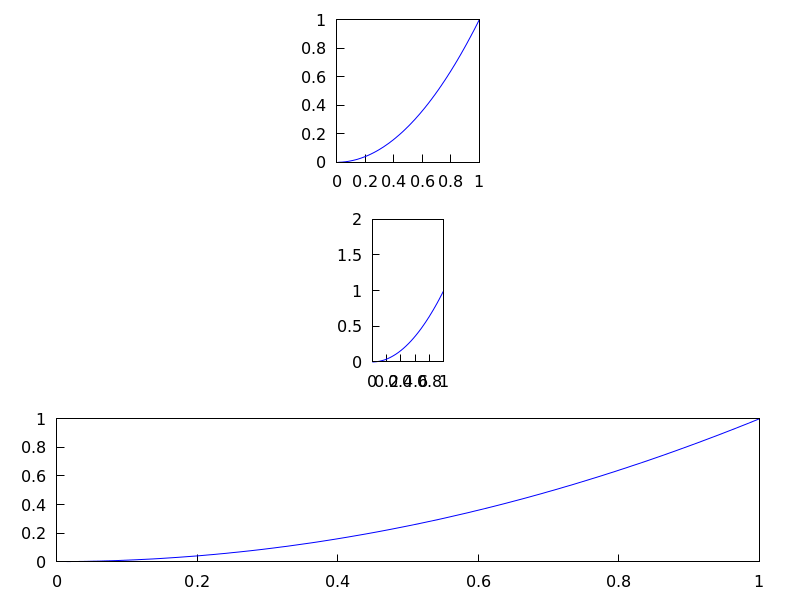 Categories: Package draw ·
Categories: Package draw ·
- Graphic option: surface_hide ¶
Default value:
falseIf
surface_hideistrue, hidden parts are not plotted in 3d surfaces.Since this is a global graphics option, its position in the scene description does not matter.
Example:
(%i1) draw(columns=2, gr3d(explicit(exp(sin(x)+cos(x^2)),x,-3,3,y,-3,3)), gr3d(surface_hide = true, explicit(exp(sin(x)+cos(x^2)),x,-3,3,y,-3,3)) )$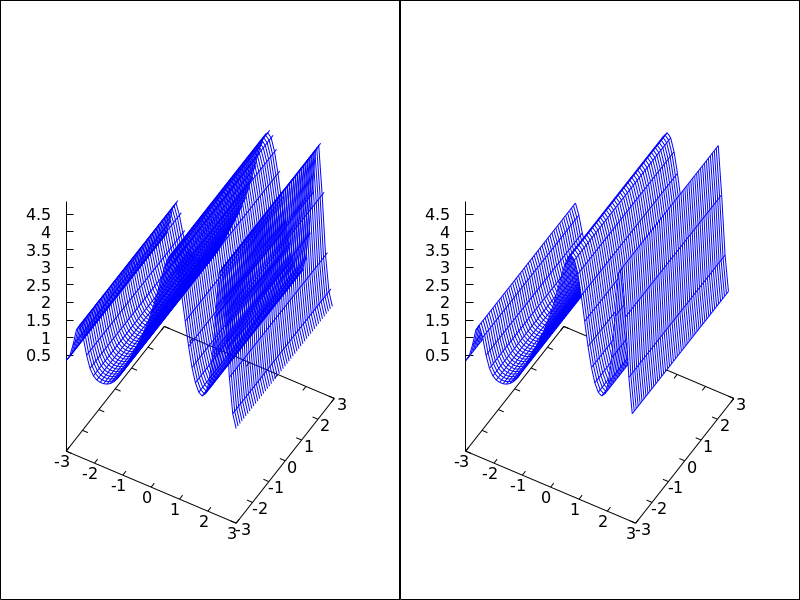 Categories: Package draw ·
Categories: Package draw ·
- Graphic option: terminal ¶
Default value:
screenSelects the terminal to be used by Gnuplot; possible values are:
screen(default),png,pngcairo,jpg,gif,eps,eps_color,epslatex,epslatex_standalone,svg,canvas,dumb,dumb_file,pdf,pdfcairo,wxt,animated_gif,multipage_pdfcairo,multipage_pdf,multipage_eps,multipage_eps_color, andaquaterm.Terminals
screen,wxt,windowsandaquatermcan be also defined as a list with two elements: the name of the terminal itself and a non negative integer number. In this form, multiple windows can be opened at the same time, each with its corresponding number. This feature does not work in Windows platforms.Since this is a global graphics option, its position in the scene description does not matter. It can be also used as an argument of function
draw.N.B. pdfcairo requires Gnuplot 4.3 or newer.
pdfrequires Gnuplot to be compiled with the option--enable-pdfand libpdf must be installed. The pdf library is available from: http://www.pdflib.com/en/download/pdflib-family/pdflib-lite/Examples:
(%i1) /* screen terminal (default) */ draw2d(explicit(x^2,x,-1,1))$ (%i2) /* png file */ draw2d(terminal = 'png, explicit(x^2,x,-1,1))$ (%i3) /* jpg file */ draw2d(terminal = 'jpg, dimensions = [300,300], explicit(x^2,x,-1,1))$ (%i4) /* eps file */ draw2d(file_name = "myfile", explicit(x^2,x,-1,1), terminal = 'eps)$ (%i5) /* pdf file */ draw2d(file_name = "mypdf", dimensions = 100*[12.0,8.0], explicit(x^2,x,-1,1), terminal = 'pdf)$ (%i6) /* wxwidgets window */ draw2d(explicit(x^2,x,-1,1), terminal = 'wxt)$Multiple windows.
(%i1) draw2d(explicit(x^5,x,-2,2), terminal=[screen, 3])$ (%i2) draw2d(explicit(x^2,x,-2,2), terminal=[screen, 0])$
An animated gif file.
(%i1) draw( delay = 100, file_name = "zzz", terminal = 'animated_gif, gr2d(explicit(x^2,x,-1,1)), gr2d(explicit(x^3,x,-1,1)), gr2d(explicit(x^4,x,-1,1))); End of animation sequence (%o1) [gr2d(explicit), gr2d(explicit), gr2d(explicit)]Option
delayis only active in animated gif’s; it is ignored in any other case.Multipage output in eps format.
(%i1) draw( file_name = "parabol", terminal = multipage_eps, dimensions = 100*[10,10], gr2d(explicit(x^2,x,-1,1)), gr3d(explicit(x^2+y^2,x,-1,1,y,-1,1))) $See also
file_name,dimensions_drawanddelay.Categories: Package draw ·
- Graphic option: title ¶
Default value:
""(empty string)Option
title, a string, is the main title for the scene. By default, no title is written.Since this is a global graphics option, its position in the scene description does not matter.
Example:
(%i1) draw2d(explicit(exp(u),u,-2,2), title = "Exponential function")$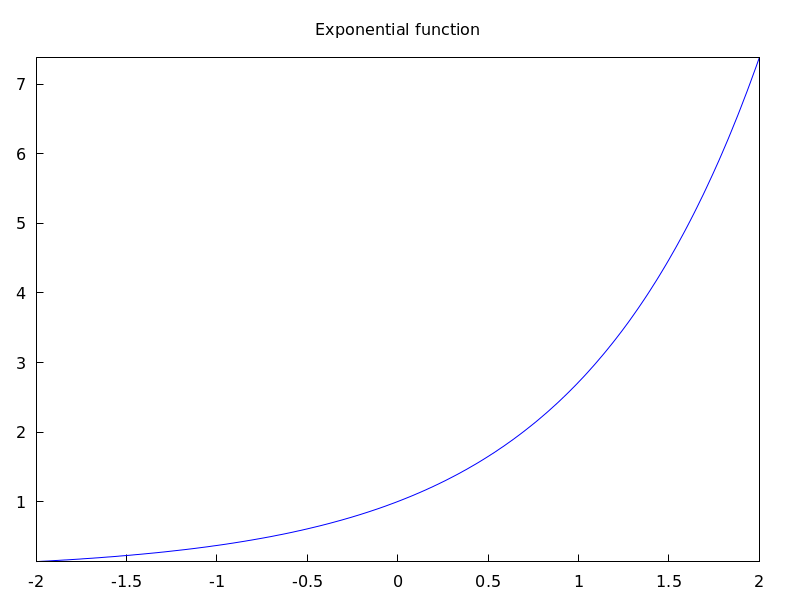 Categories: Package draw ·
Categories: Package draw ·
- Graphic option: transform ¶
Default value:
noneIf
transformisnone, the space is not transformed and graphic objects are drawn as defined. When a space transformation is desired, a list must be assigned to optiontransform. In case of a 2D scene, the list takes the form[f1(x,y), f2(x,y), x, y]. In case of a 3D scene, the list is of the form[f1(x,y,z), f2(x,y,z), f3(x,y,z), x, y, z].The names of the variables defined in the lists may be different to those used in the definitions of the graphic objects.
Examples:
Rotation in 2D.
(%i1) th : %pi / 4$ (%i2) draw2d( color = "#e245f0", proportional_axes = 'xy, line_width = 8, triangle([3,2],[7,2],[5,5]), border = false, fill_color = yellow, transform = [cos(th)*x - sin(th)*y, sin(th)*x + cos(th)*y, x, y], triangle([3,2],[7,2],[5,5]) )$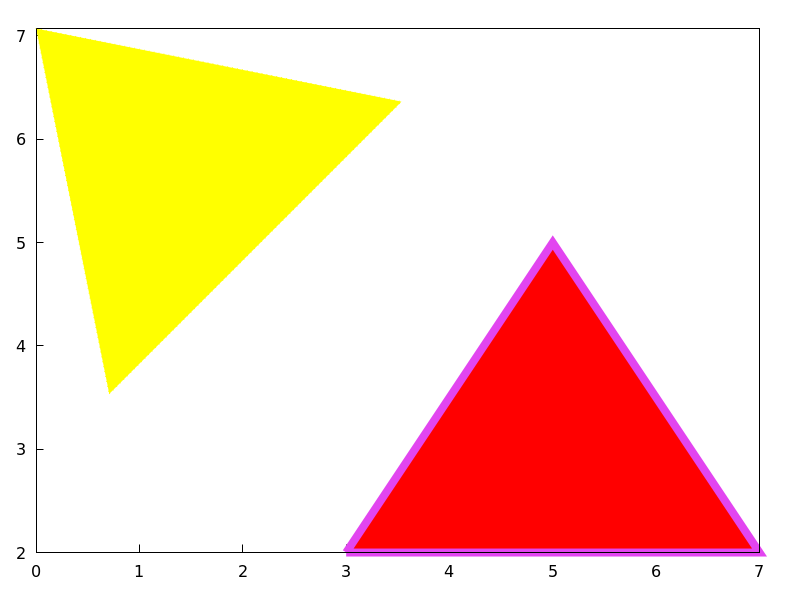
Translation in 3D.
(%i1) draw3d( color = "#a02c00", explicit(20*exp(-x^2-y^2)-10,x,-3,3,y,-3,3), transform = [x+10,y+10,z+10,x,y,z], color = blue, explicit(20*exp(-x^2-y^2)-10,x,-3,3,y,-3,3) )$Categories: Package draw ·
- Graphic option: transparent ¶
Default value:
falseIf
transparentisfalse, interior regions of polygons are filled according tofill_color.This option affects the following graphic objects:
Example:
(%i1) draw2d(polygon([[3,2],[7,2],[5,5]]), transparent = true, color = blue, polygon([[5,2],[9,2],[7,5]]) )$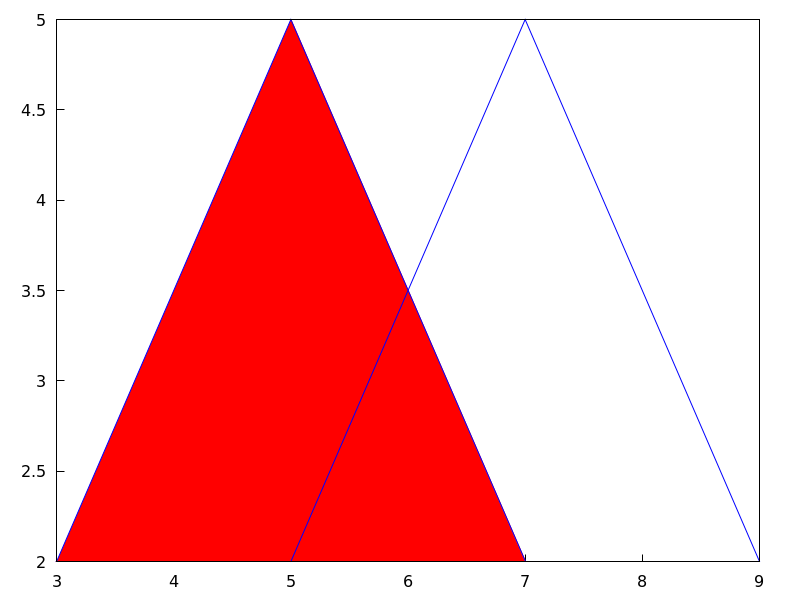 Categories: Package draw ·
Categories: Package draw ·
- Graphic option: unit_vectors ¶
Default value:
falseIf
unit_vectorsistrue, vectors are plotted with module 1. This is useful for plotting vector fields. Ifunit_vectorsisfalse, vectors are plotted with its original length.This option is relevant only for
vectorobjects.Example:
(%i1) draw2d(xrange = [-1,6], yrange = [-1,6], head_length = 0.1, vector([0,0],[5,2]), unit_vectors = true, color = red, vector([0,3],[5,2]))$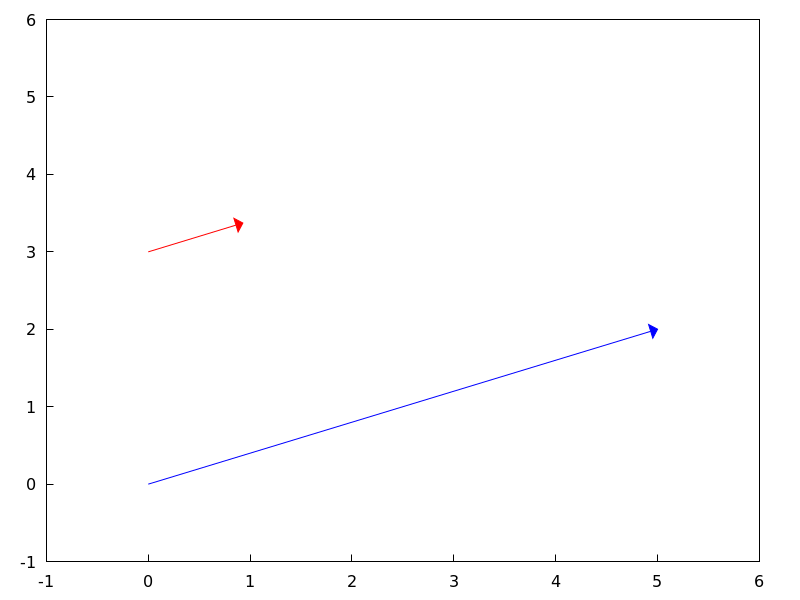 Categories: Package draw ·
Categories: Package draw ·
- Graphic option: user_preamble ¶
Default value:
""(empty string)Expert Gnuplot users can make use of this option to fine tune Gnuplot’s behaviour by writing settings to be sent before the
plotorsplotcommand.The value of this option must be a string or a list of strings (one per line).
Since this is a global graphics option, its position in the scene description does not matter.
Example:
Tell Gnuplot to draw axes and grid on top of graphics objects,
(%i1) draw2d( xaxis =true, xaxis_type=solid, yaxis =true, yaxis_type=solid, user_preamble="set grid front", region(x^2+y^2<1 ,x,-1.5,1.5,y,-1.5,1.5))$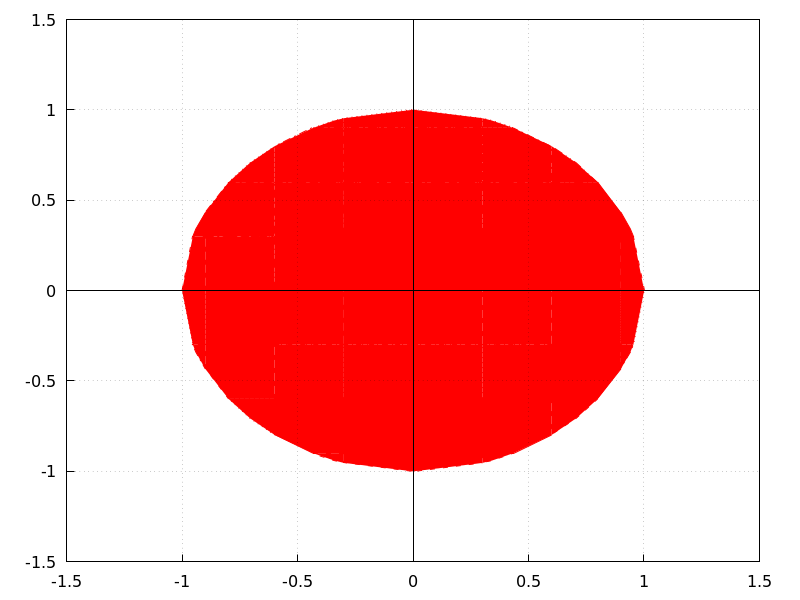
Tell gnuplot to draw all contour lines in black
(%i1) draw3d( contour=both, surface_hide=true,enhanced3d=true,wired_surface=true, contour_levels=10, user_preamble="set for [i=1:8] linetype i dashtype i linecolor 0", explicit(sin(x)*cos(y),x,1,10,y,1,10) );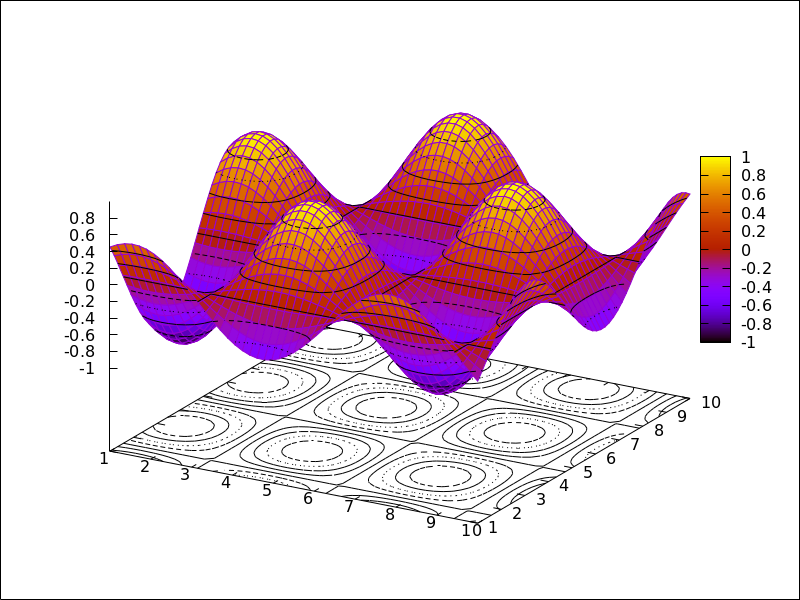 Categories: Package draw ·
Categories: Package draw ·
- Graphic option: view ¶
Default value:
[60,30]A pair of angles, measured in degrees, indicating the view direction in a 3D scene. The first angle is the vertical rotation around the x axis, in the range \([0, 360]\). The second one is the horizontal rotation around the z axis, in the range \([0, 360]\).
If option
viewis given the valuemap, the view direction is set to be perpendicular to the xy-plane.Since this is a global graphics option, its position in the scene description does not matter.
Example:
(%i1) draw3d(view = [170, 50], enhanced3d = true, explicit(sin(x^2+y^2),x,-2,2,y,-2,2) )$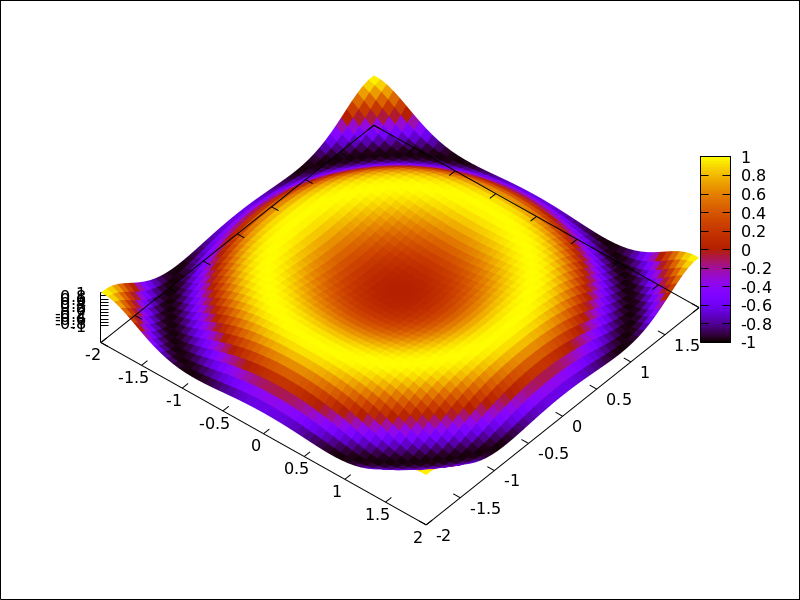
(%i2) draw3d(view = map, enhanced3d = true, explicit(sin(x^2+y^2),x,-2,2,y,-2,2) )$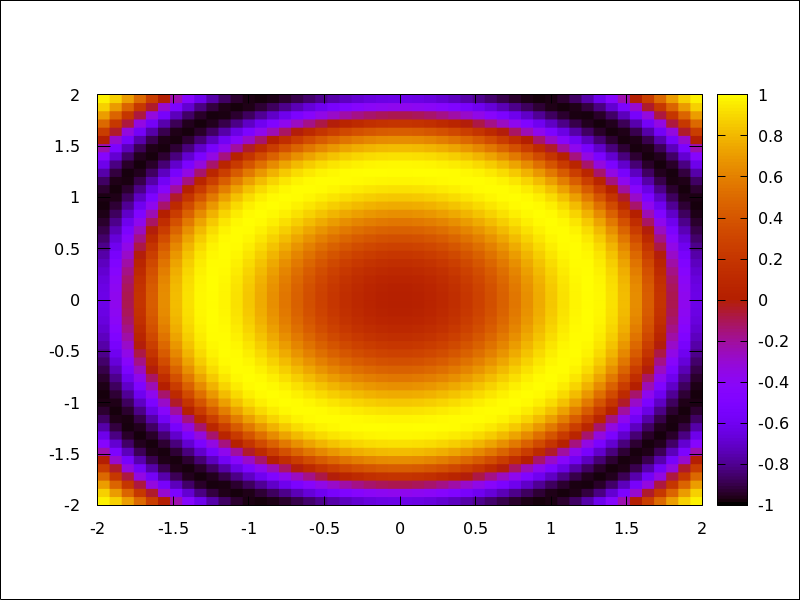 Categories: Package draw ·
Categories: Package draw ·
- Graphic option: wired_surface ¶
Default value:
falseIndicates whether 3D surfaces in
enhanced3dmode show the grid joining the points or not.Since this is a global graphics option, its position in the scene description does not matter.
Example:
(%i1) draw3d( enhanced3d = [sin(x),x,y], wired_surface = true, explicit(x^2+y^2,x,-1,1,y,-1,1)) $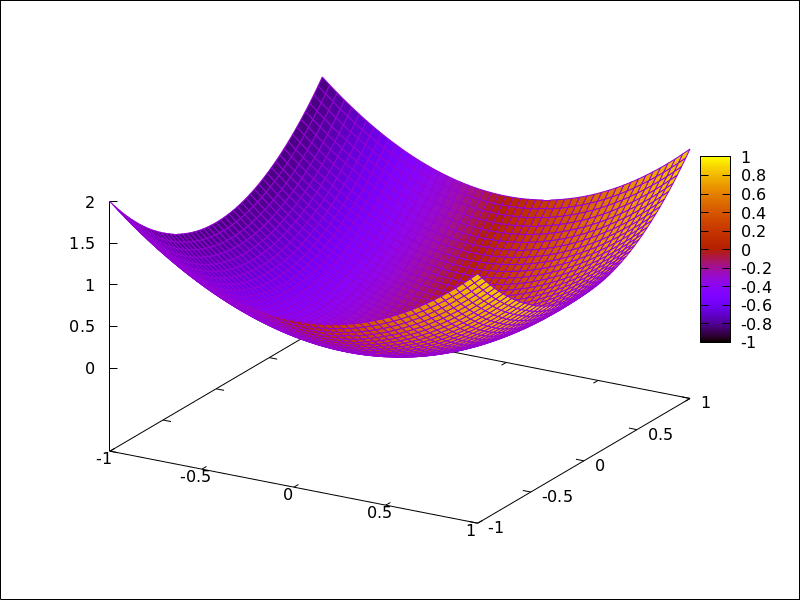 Categories: Package draw ·
Categories: Package draw ·
- Graphic option: x_voxel ¶
Default value: 10
x_voxelis the number of voxels in the x direction to be used by the marching cubes algorithm implemented by the 3dimplicitobject. It is also used by graphic objectregion.Categories: Package draw ·
- Graphic option: xaxis ¶
Default value:
falseIf
xaxisistrue, the x axis is drawn.Since this is a global graphics option, its position in the scene description does not matter.
Example:
(%i1) draw2d(explicit(x^3,x,-1,1), xaxis = true, xaxis_color = blue)$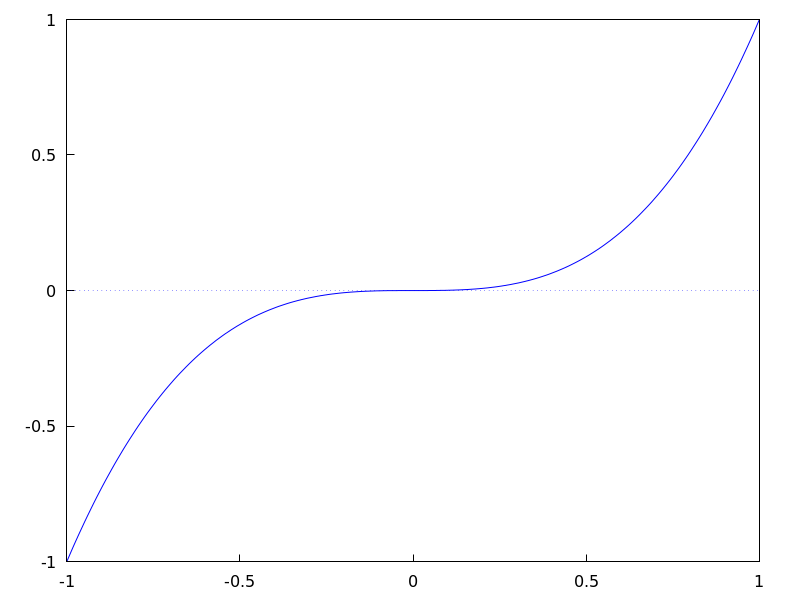
See also
xaxis_width,xaxis_typeandxaxis_color.Categories: Package draw ·
- Graphic option: xaxis_color ¶
Default value:
"black"xaxis_colorspecifies the color for the x axis. Seecolorto know how colors are defined.Since this is a global graphics option, its position in the scene description does not matter.
Example:
(%i1) draw2d(explicit(x^3,x,-1,1), xaxis = true, xaxis_color = red)$See also
xaxis,xaxis_widthandxaxis_type.Categories: Package draw ·
- Graphic option: xaxis_secondary ¶
Default value:
falseIf
xaxis_secondaryistrue, function values can be plotted with respect to the second x axis, which will be drawn on top of the scene.Note that this is a local graphics option which only affects to 2d plots.
Example:
(%i1) draw2d( key = "Bottom x-axis", explicit(x+1,x,1,2), color = red, key = "Above x-axis", xtics_secondary = true, xaxis_secondary = true, explicit(x^2,x,-1,1)) $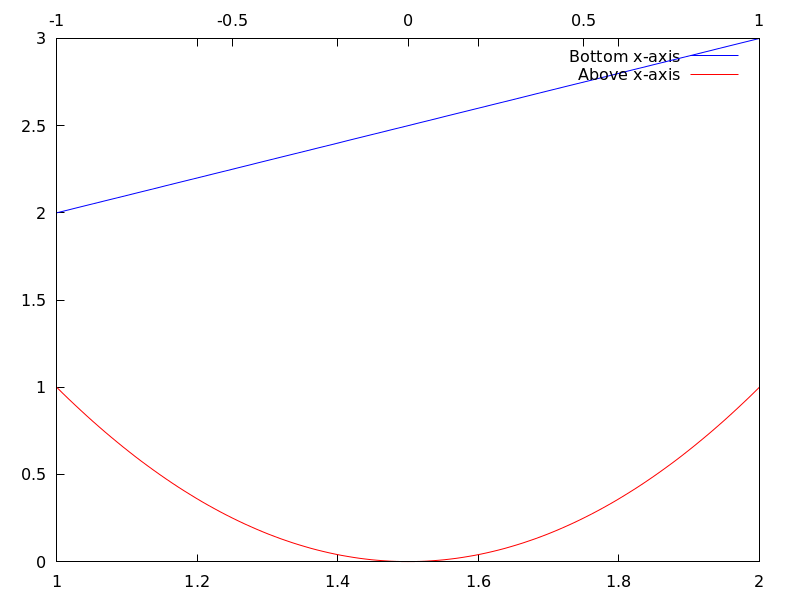
See also
xrange_secondary,xtics_secondary,xtics_rotate_secondary,xtics_axis_secondaryandxaxis_secondary.Categories: Package draw ·
- Graphic option: xaxis_type ¶
Default value:
dotsxaxis_typeindicates how the x axis is displayed; possible values aresolidanddotsSince this is a global graphics option, its position in the scene description does not matter.
Example:
(%i1) draw2d(explicit(x^3,x,-1,1), xaxis = true, xaxis_type = solid)$See also
xaxis,xaxis_widthandxaxis_color.Categories: Package draw ·
- Graphic option: xaxis_width ¶
Default value: 1
xaxis_widthis the width of the x axis. Its value must be a positive number.Since this is a global graphics option, its position in the scene description does not matter.
Example:
(%i1) draw2d(explicit(x^3,x,-1,1), xaxis = true, xaxis_width = 3)$See also
xaxis,xaxis_typeandxaxis_color.Categories: Package draw ·
- Graphic option: xlabel ¶
Default value:
""Option
xlabel, a string, is the label for the x axis. By default, the axis is labeled with string"x".Since this is a global graphics option, its position in the scene description does not matter.
Example:
(%i1) draw2d(xlabel = "Time", explicit(exp(u),u,-2,2), ylabel = "Population")$See also
xlabel_secondary,ylabel,ylabel_secondaryandzlabel_draw.Categories: Package draw ·
- Graphic option: xlabel_secondary ¶
Default value:
""(empty string)Option
xlabel_secondary, a string, is the label for the secondary x axis. By default, no label is written.Since this is a global graphics option, its position in the scene description does not matter.
Example:
(%i1) draw2d( xaxis_secondary=true,yaxis_secondary=true, xtics_secondary=true,ytics_secondary=true, xlabel_secondary="t[s]", ylabel_secondary="U[V]", explicit(sin(t),t,0,10) )$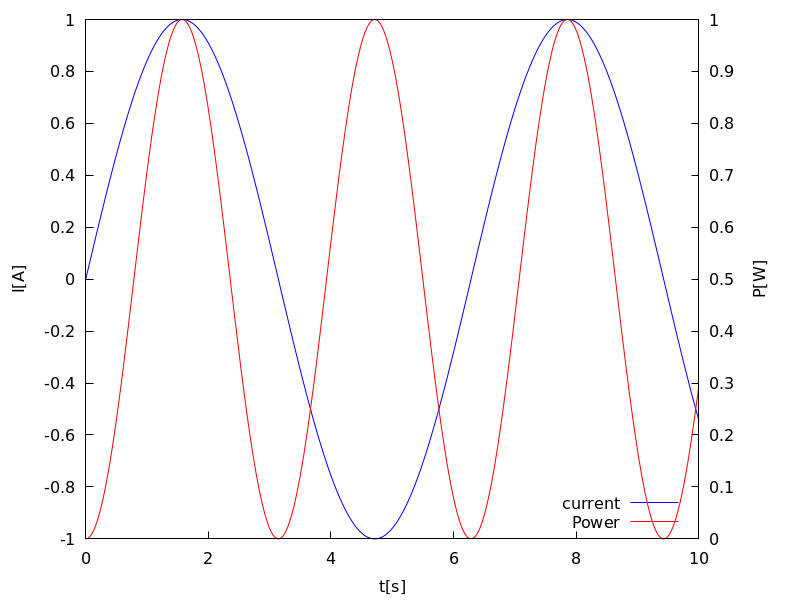
See also
xlabel_draw,ylabel_draw,ylabel_secondaryandzlabel_draw.Categories: Package draw ·
- Graphic option: xrange ¶
Default value:
autoIf
xrangeisauto, the range for the x coordinate is computed automatically.If the user wants a specific interval for x, it must be given as a Maxima list, as in
xrange=[-2, 3].Since this is a global graphics option, its position in the scene description does not matter.
Example:
(%i1) draw2d(xrange = [-3,5], explicit(x^2,x,-1,1))$Categories: Package draw ·
- Graphic option: xrange_secondary ¶
Default value:
autoIf
xrange_secondaryisauto, the range for the second x axis is computed automatically.If the user wants a specific interval for the second x axis, it must be given as a Maxima list, as in
xrange_secondary=[-2, 3].Since this is a global graphics option, its position in the scene description does not matter.
See also
xrange,yrange,zrangeandyrange_secondary.Categories: Package draw ·
- Graphic option: xtics ¶
Default value:
trueThis graphic option controls the way tic marks are drawn on the x axis.
- When option
xticsis bounded to symbol true, tic marks are drawn automatically. - When option
xticsis bounded to symbol false, tic marks are not drawn. - When option
xticsis bounded to a positive number, this is the distance between two consecutive tic marks. - When option
xticsis bounded to a list of length three of the form[start,incr,end], tic marks are plotted fromstarttoendat intervals of lengthincr. - When option
xticsis bounded to a set of numbers of the form{n1, n2, ...}, tic marks are plotted at valuesn1,n2, ... - When option
xticsis bounded to a set of pairs of the form{["label1", n1], ["label2", n2], ...}, tic marks corresponding to valuesn1,n2, ... are labeled with"label1","label2", ..., respectively.
Since this is a global graphics option, its position in the scene description does not matter.
Examples:
Disable tics.
(%i1) draw2d(xtics = 'false, explicit(x^3,x,-1,1) )$Tics every 1/4 units.
(%i1) draw2d(xtics = 1/4, explicit(x^3,x,-1,1) )$Tics from -3/4 to 3/4 in steps of 1/8.
(%i1) draw2d(xtics = [-3/4,1/8,3/4], explicit(x^3,x,-1,1) )$Tics at points -1/2, -1/4 and 3/4.
(%i1) draw2d(xtics = {-1/2,-1/4,3/4}, explicit(x^3,x,-1,1) )$Labeled tics.
(%i1) draw2d(xtics = {["High",0.75],["Medium",0],["Low",-0.75]}, explicit(x^3,x,-1,1) )$See also
ytics_draw, andztics_draw.Categories: Package draw ·- When option
- Graphic option: xtics_axis ¶
Default value:
falseIf
xtics_axisistrue, tic marks and their labels are plotted just along the x axis, if it isfalsetics are plotted on the border.Since this is a global graphics option, its position in the scene description does not matter.
Categories: Package draw ·
- Graphic option: xtics_rotate ¶
Default value:
falseIf
xtics_rotateistrue, tic marks on the x axis are rotated 90 degrees.Since this is a global graphics option, its position in the scene description does not matter.
Categories: Package draw ·
- Graphic option: xtics_rotate_secondary ¶
Default value:
falseIf
xtics_rotate_secondaryistrue, tic marks on the secondary x axis are rotated 90 degrees.Since this is a global graphics option, its position in the scene description does not matter.
Categories: Package draw ·
- Graphic option: xtics_secondary ¶
Default value:
autoThis graphic option controls the way tic marks are drawn on the second x axis.
See
xtics_drawfor a complete description.Categories: Package draw ·
- Graphic option: xtics_secondary_axis ¶
Default value:
falseIf
xtics_secondary_axisistrue, tic marks and their labels are plotted just along the secondary x axis, if it isfalsetics are plotted on the border.Since this is a global graphics option, its position in the scene description does not matter.
Categories: Package draw ·
- Graphic option: xu_grid ¶
Default value: 30
xu_gridis the number of coordinates of the first variable (xin explicit anduin parametric 3d surfaces) to build the grid of sample points.This option affects the following graphic objects:
-
gr3d:explicitandparametric_surface.
Example:
(%i1) draw3d(xu_grid = 10, yv_grid = 50, explicit(x^2+y^2,x,-3,3,y,-3,3) )$See also
yv_grid.Categories: Package draw ·-
- Graphic option: xy_file ¶
Default value:
""(empty string)xy_fileis the name of the file where the coordinates will be saved after clicking with the mouse button and hitting the ’x’ key. By default, no coordinates are saved.Since this is a global graphics option, its position in the scene description does not matter.
Categories: Package draw ·
- Graphic option: xyplane ¶
Default value:
falseAllocates the xy-plane in 3D scenes. When
xyplaneisfalse, the xy-plane is placed automatically; when it is a real number, the xy-plane intersects the z-axis at this level. This option has no effect in 2D scenes.Since this is a global graphics option, its position in the scene description does not matter.
Example:
(%i1) draw3d(xyplane = %e-2, explicit(x^2+y^2,x,-1,1,y,-1,1))$Categories: Package draw ·
- Graphic option: y_voxel ¶
Default value: 10
y_voxelis the number of voxels in the y direction to be used by the marching cubes algorithm implemented by the 3dimplicitobject. It is also used by graphic objectregion.Categories: Package draw ·
- Graphic option: yaxis ¶
Default value:
falseIf
yaxisistrue, the y axis is drawn.Since this is a global graphics option, its position in the scene description does not matter.
Example:
(%i1) draw2d(explicit(x^3,x,-1,1), yaxis = true, yaxis_color = blue)$See also
yaxis_width,yaxis_typeandyaxis_color.Categories: Package draw ·
- Graphic option: yaxis_color ¶
Default value:
"black"yaxis_colorspecifies the color for the y axis. Seecolorto know how colors are defined.Since this is a global graphics option, its position in the scene description does not matter.
Example:
(%i1) draw2d(explicit(x^3,x,-1,1), yaxis = true, yaxis_color = red)$See also
yaxis,yaxis_widthandyaxis_type.Categories: Package draw ·
- Graphic option: yaxis_secondary ¶
Default value:
falseIf
yaxis_secondaryistrue, function values can be plotted with respect to the second y axis, which will be drawn on the right side of the scene.Note that this is a local graphics option which only affects to 2d plots.
Example:
(%i1) draw2d( explicit(sin(x),x,0,10), yaxis_secondary = true, ytics_secondary = true, color = blue, explicit(100*sin(x+0.1)+2,x,0,10));See also
yrange_secondary,ytics_secondary,ytics_rotate_secondaryandytics_axis_secondaryCategories: Package draw ·
- Graphic option: yaxis_type ¶
Default value:
dotsyaxis_typeindicates how the y axis is displayed; possible values aresolidanddots.Since this is a global graphics option, its position in the scene description does not matter.
Example:
(%i1) draw2d(explicit(x^3,x,-1,1), yaxis = true, yaxis_type = solid)$See also
yaxis,yaxis_widthandyaxis_color.Categories: Package draw ·
- Graphic option: yaxis_width ¶
Default value: 1
yaxis_widthis the width of the y axis. Its value must be a positive number.Since this is a global graphics option, its position in the scene description does not matter.
Example:
(%i1) draw2d(explicit(x^3,x,-1,1), yaxis = true, yaxis_width = 3)$See also
yaxis,yaxis_typeandyaxis_color.Categories: Package draw ·
- Graphic option: ylabel ¶
Default value:
""Option
ylabel, a string, is the label for the y axis. By default, the axis is labeled with string"y".Since this is a global graphics option, its position in the scene description does not matter.
Example:
(%i1) draw2d(xlabel = "Time", ylabel = "Population", explicit(exp(u),u,-2,2) )$See also
xlabel_draw,xlabel_secondary,ylabel_secondary, andzlabel_draw.Categories: Package draw ·
- Graphic option: ylabel_secondary ¶
Default value:
""(empty string)Option
ylabel_secondary, a string, is the label for the secondary y axis. By default, no label is written.Since this is a global graphics option, its position in the scene description does not matter.
Example:
(%i1) draw2d( key_pos=bottom_right, key="current", xlabel="t[s]", ylabel="I[A]",ylabel_secondary="P[W]", explicit(sin(t),t,0,10), yaxis_secondary=true, ytics_secondary=true, color=red,key="Power", explicit((sin(t))^2,t,0,10) )$See also
xlabel_draw,xlabel_secondary,ylabel_drawandzlabel_draw.Categories: Package draw ·
- Graphic option: yrange ¶
Default value:
autoIf
yrangeisauto, the range for the y coordinate is computed automatically.If the user wants a specific interval for y, it must be given as a Maxima list, as in
yrange=[-2, 3].Since this is a global graphics option, its position in the scene description does not matter.
Example:
(%i1) draw2d(yrange = [-2,3], explicit(x^2,x,-1,1), xrange = [-3,3])$See also
xrange,yrange_secondaryandzrange.Categories: Package draw ·
- Graphic option: yrange_secondary ¶
Default value:
autoIf
yrange_secondaryisauto, the range for the second y axis is computed automatically.If the user wants a specific interval for the second y axis, it must be given as a Maxima list, as in
yrange_secondary=[-2, 3].Since this is a global graphics option, its position in the scene description does not matter.
Example:
(%i1) draw2d( explicit(sin(x),x,0,10), yaxis_secondary = true, ytics_secondary = true, yrange = [-3, 3], yrange_secondary = [-20, 20], color = blue, explicit(100*sin(x+0.1)+2,x,0,10)) $See also
xrange,yrangeandzrange.Categories: Package draw ·
- Graphic option: ytics ¶
Default value:
trueThis graphic option controls the way tic marks are drawn on the y axis.
See
xticsfor a complete description.Categories: Package draw ·
- Graphic option: ytics_axis ¶
Default value:
falseIf
ytics_axisistrue, tic marks and their labels are plotted just along the y axis, if it isfalsetics are plotted on the border.Since this is a global graphics option, its position in the scene description does not matter.
Categories: Package draw ·
- Graphic option: ytics_rotate ¶
Default value:
falseIf
ytics_rotateistrue, tic marks on the y axis are rotated 90 degrees.Since this is a global graphics option, its position in the scene description does not matter.
Categories: Package draw ·
- Graphic option: ytics_rotate_secondary ¶
Default value:
falseIf
ytics_rotate_secondaryistrue, tic marks on the secondary y axis are rotated 90 degrees.Since this is a global graphics option, its position in the scene description does not matter.
Categories: Package draw ·
- Graphic option: ytics_secondary ¶
Default value:
autoThis graphic option controls the way tic marks are drawn on the second y axis.
See
xticsfor a complete description.Categories: Package draw ·
- Graphic option: ytics_secondary_axis ¶
Default value:
falseIf
ytics_secondary_axisistrue, tic marks and their labels are plotted just along the secondary y axis, if it isfalsetics are plotted on the border.Since this is a global graphics option, its position in the scene description does not matter.
Categories: Package draw ·
- Graphic option: yv_grid ¶
Default value: 30
yv_gridis the number of coordinates of the second variable (yin explicit andvin parametric 3d surfaces) to build the grid of sample points.This option affects the following graphic objects:
-
gr3d:explicitandparametric_surface.
Example:
(%i1) draw3d(xu_grid = 10, yv_grid = 50, explicit(x^2+y^2,x,-3,3,y,-3,3) )$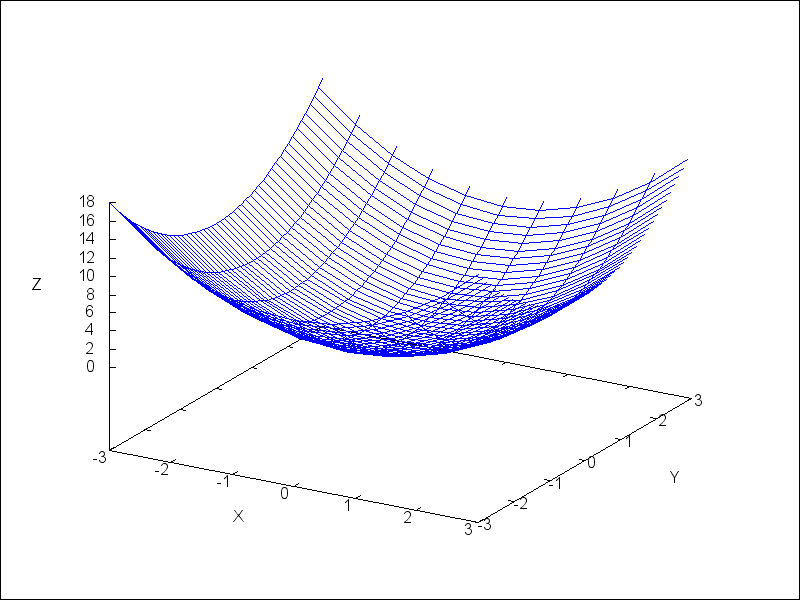
See also
xu_grid.Categories: Package draw ·-
- Graphic option: z_voxel ¶
Default value: 10
z_voxelis the number of voxels in the z direction to be used by the marching cubes algorithm implemented by the 3dimplicitobject.Categories: Package draw ·
- Graphic option: zaxis ¶
Default value:
falseIf
zaxisistrue, the z axis is drawn in 3D plots. This option has no effect in 2D scenes.Since this is a global graphics option, its position in the scene description does not matter.
Example:
(%i1) draw3d(explicit(x^2+y^2,x,-1,1,y,-1,1), zaxis = true, zaxis_type = solid, zaxis_color = blue)$See also
zaxis_width,zaxis_typeandzaxis_color.Categories: Package draw ·
- Graphic option: zaxis_color ¶
Default value:
"black"zaxis_colorspecifies the color for the z axis. Seecolorto know how colors are defined. This option has no effect in 2D scenes.Since this is a global graphics option, its position in the scene description does not matter.
Example:
(%i1) draw3d(explicit(x^2+y^2,x,-1,1,y,-1,1), zaxis = true, zaxis_type = solid, zaxis_color = red)$See also
zaxis,zaxis_widthandzaxis_type.Categories: Package draw ·
- Graphic option: zaxis_type ¶
Default value:
dotszaxis_typeindicates how the z axis is displayed; possible values aresolidanddots. This option has no effect in 2D scenes.Since this is a global graphics option, its position in the scene description does not matter.
Example:
(%i1) draw3d(explicit(x^2+y^2,x,-1,1,y,-1,1), zaxis = true, zaxis_type = solid)$See also
zaxis,zaxis_widthandzaxis_color.Categories: Package draw ·
- Graphic option: zaxis_width ¶
Default value: 1
zaxis_widthis the width of the z axis. Its value must be a positive number. This option has no effect in 2D scenes.Since this is a global graphics option, its position in the scene description does not matter.
Example:
(%i1) draw3d(explicit(x^2+y^2,x,-1,1,y,-1,1), zaxis = true, zaxis_type = solid, zaxis_width = 3)$See also
zaxis,zaxis_typeandzaxis_color.Categories: Package draw ·
- Graphic option: zlabel ¶
Default value:
""Option
zlabel, a string, is the label for the z axis. By default, the axis is labeled with string"z".Since this is a global graphics option, its position in the scene description does not matter.
Example:
(%i1) draw3d(zlabel = "Z variable", ylabel = "Y variable", explicit(sin(x^2+y^2),x,-2,2,y,-2,2), xlabel = "X variable" )$See also
xlabel_draw,ylabel_draw, andzlabel_rotate.Categories: Package draw ·
- Graphic option: zlabel_rotate ¶
Default value:
"auto"This graphics option allows to choose if the z axis label of 3d plots is drawn horizontal (
false), vertical (true) or if maxima automatically chooses an orientation based on the length of the label (auto).Since this is a global graphics option, its position in the scene description does not matter.
Example:
(%i1) draw3d( explicit(sin(x)*sin(y),x,0,10,y,0,10), zlabel_rotate=false )$See also
zlabel_draw.Categories: Package draw ·
- Graphic option: zrange ¶
Default value:
autoIf
zrangeisauto, the range for the z coordinate is computed automatically.If the user wants a specific interval for z, it must be given as a Maxima list, as in
zrange=[-2, 3].Since this is a global graphics option, its position in the scene description does not matter.
Example:
(%i1) draw3d(yrange = [-3,3], zrange = [-2,5], explicit(x^2+y^2,x,-1,1,y,-1,1), xrange = [-3,3])$Categories: Package draw ·
- Graphic option: ztics ¶
Default value:
trueThis graphic option controls the way tic marks are drawn on the z axis.
See
xtics_drawfor a complete description.Categories: Package draw ·
- Graphic option: ztics_axis ¶
Default value:
falseIf
ztics_axisistrue, tic marks and their labels are plotted just along the z axis, if it isfalsetics are plotted on the border.Since this is a global graphics option, its position in the scene description does not matter.
Categories: Package draw ·
- Graphic option: ztics_rotate ¶
Default value:
falseIf
ztics_rotateistrue, tic marks on the z axis are rotated 90 degrees.Since this is a global graphics option, its position in the scene description does not matter.
Categories: Package draw ·
53.2.4 Graphics objects
- Graphic object: bars ([x1,h1,w1], [x2,h2,w2, ...]) ¶
Draws vertical bars in 2D.
2D
bars ([x1,h1,w1], [x2,h2,w2, ...])draws bars centered at values x1, x2, ... with heights h1, h2, ... and widths w1, w2, ...This object is affected by the following graphic options:
key,fill_color,fill_densityandline_width.Example:
(%i1) draw2d( key = "Group A", fill_color = blue, fill_density = 0.2, bars([0.8,5,0.4],[1.8,7,0.4],[2.8,-4,0.4]), key = "Group B", fill_color = red, fill_density = 0.6, line_width = 4, bars([1.2,4,0.4],[2.2,-2,0.4],[3.2,5,0.4]), xaxis = true);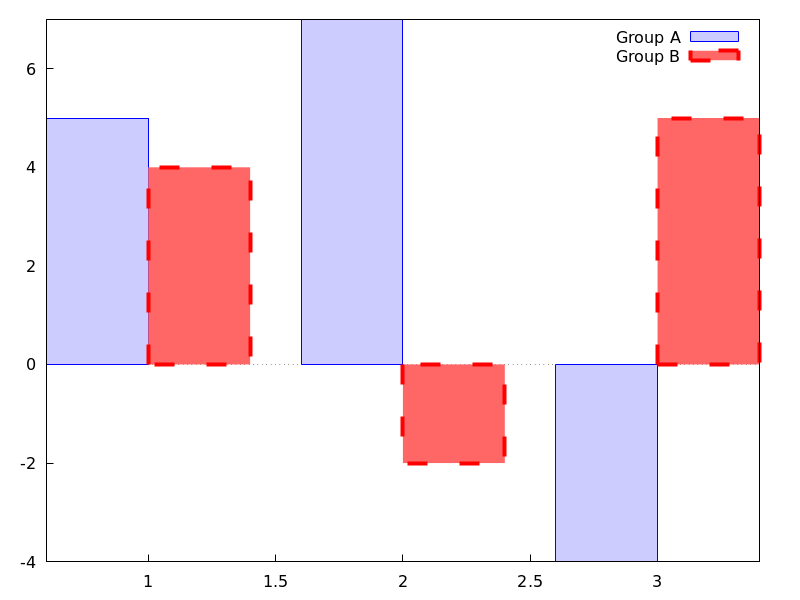 Categories: Package draw ·
Categories: Package draw ·
- Graphic object: cylindrical (radius, z, minz, maxz, azi, minazi, maxazi) ¶
Draws 3D functions defined in cylindrical coordinates.
3D
cylindrical(radius, z, minz, maxz, azi, minazi, maxazi)plots the functionradius(z, azi)defined in cylindrical coordinates, with variable z taking values from minz to maxz and azimuth azi taking values from minazi to maxazi.This object is affected by the following graphic options:
xu_grid,yv_grid,line_type,key,wired_surface,enhanced3dandcolorExample:
(%i1) draw3d(cylindrical(1,z,-2,2,az,0,2*%pi))$
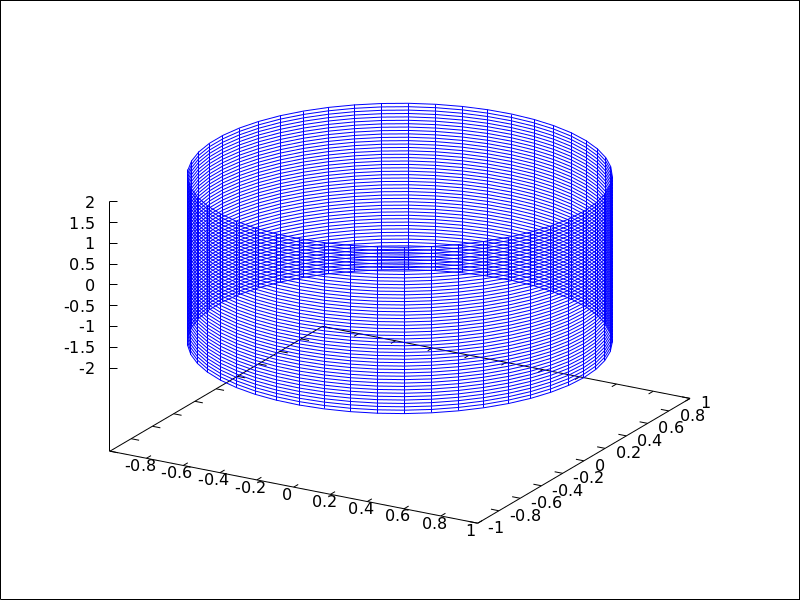 Categories: Package draw ·
Categories: Package draw ·
- Graphic object: elevation_grid (mat,x0,y0,width,height) ¶
Draws matrix mat in 3D space. z values are taken from mat, the abscissas range from x0 to x0 + width and ordinates from y0 to y0 + height. Element \(a(1,1)\) is projected on point \((x0,y0+height)\), \(a(1,n)\) on \((x0+width,y0+height)\), \(a(m,1)\) on \((x0,y0)\), and \(a(m,n)\) on \((x0+width,y0)\).
This object is affected by the following graphic options:
line_type,,line_widthkey,wired_surface,enhanced3dandcolorIn older versions of Maxima,
elevation_gridwas calledmesh. See alsomesh.Example:
(%i1) m: apply( matrix, makelist(makelist(random(10.0),k,1,30),i,1,20)) $ (%i2) draw3d( color = blue, elevation_grid(m,0,0,3,2), xlabel = "x", ylabel = "y", surface_hide = true);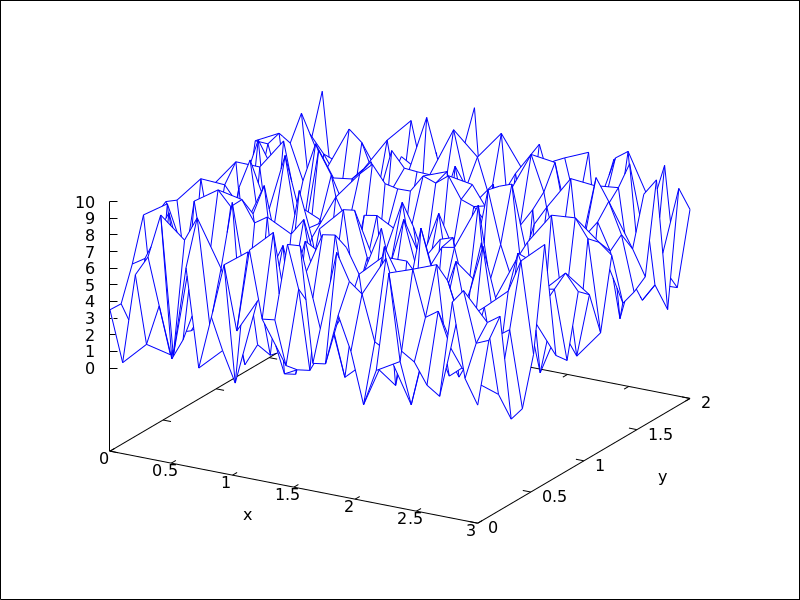 Categories: Package draw ·
Categories: Package draw ·
- Graphic object: ellipse (xc, yc, a, b, ang1, ang2) ¶
Draws ellipses and circles in 2D.
2D
ellipse (xc, yc, a, b, ang1, ang2)plots an ellipse centered at[xc, yc]with horizontal and vertical semi axis a and b, respectively, starting at angle ang1 with an amplitude equal to angle ang2.This object is affected by the following graphic options:
nticks,transparent,fill_color,fill_density,border,line_width,line_type,keyandcolorExample:
(%i1) draw2d(transparent = false, fill_color = red, color = gray30, transparent = false, line_width = 5, ellipse(0,6,3,2,270,-270), /* center (x,y), a, b, start & end in degrees */ transparent = true, color = blue, line_width = 3, ellipse(2.5,6,2,3,30,-90), xrange = [-3,6], yrange = [2,9] )$ Categories: Package draw ·
Categories: Package draw ·
- Graphic object: errors ([x1, x2, …], [y1, y2, …]) ¶
Draws points with error bars, horizontally, vertically or both, depending on the value of option
error_type.2D
If
error_type = x, arguments toerrorsmust be of the form[x, y, xdelta]or[x, y, xlow, xhigh]. Iferror_type = y, arguments must be of the form[x, y, ydelta]or[x, y, ylow, yhigh]. Iferror_type = xyorerror_type = boxes, arguments toerrorsmust be of the form[x, y, xdelta, ydelta]or[x, y, xlow, xhigh, ylow, yhigh].See also
error_type.This object is affected by the following graphic options:
error_type,points_joined,line_width,key,line_type,colorfill_density,xaxis_secondaryandyaxis_secondary.Option
fill_densityis only relevant whenerror_type=boxes.Examples:
Horizontal error bars.
(%i1) draw2d( error_type = 'y, errors([[1,2,1], [3,5,3], [10,3,1], [17,6,2]]))$
Vertical and horizontal error bars.
(%i1) draw2d( error_type = 'xy, points_joined = true, color = blue, errors([[1,2,1,2], [3,5,2,1], [10,3,1,1], [17,6,1/2,2]]));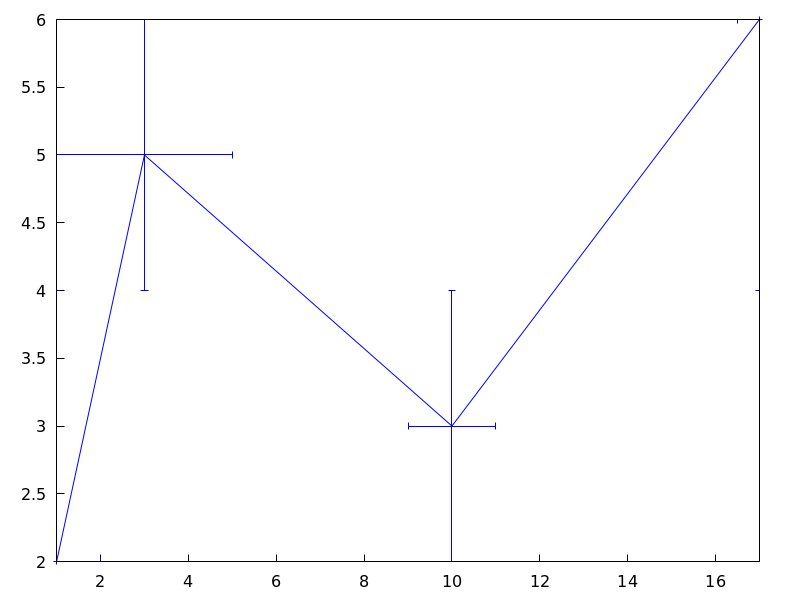 Categories: Package draw ·
Categories: Package draw ·
- Graphic object: explicit
explicit (expr,var,minval,maxval)
explicit (fcn,var,minval,maxval)
explicit (expr,var1,minval1,maxval1,var2,minval2,maxval2)
explicit (fcn,var1,minval1,maxval1,var2,minval2,maxval2) ¶ -
Draws explicit functions in 2D and 3D.
2D
explicit(fcn,var,minval,maxval)plots explicit function fcn, with variable var taking values from minval to maxval.This object is affected by the following graphic options:
nticks,adapt_depth,draw_realpart,line_width,line_type,key,filled_func,fill_color,fill_density, andcolorExample:
(%i1) draw2d(line_width = 3, color = blue, explicit(x^2,x,-3,3) )$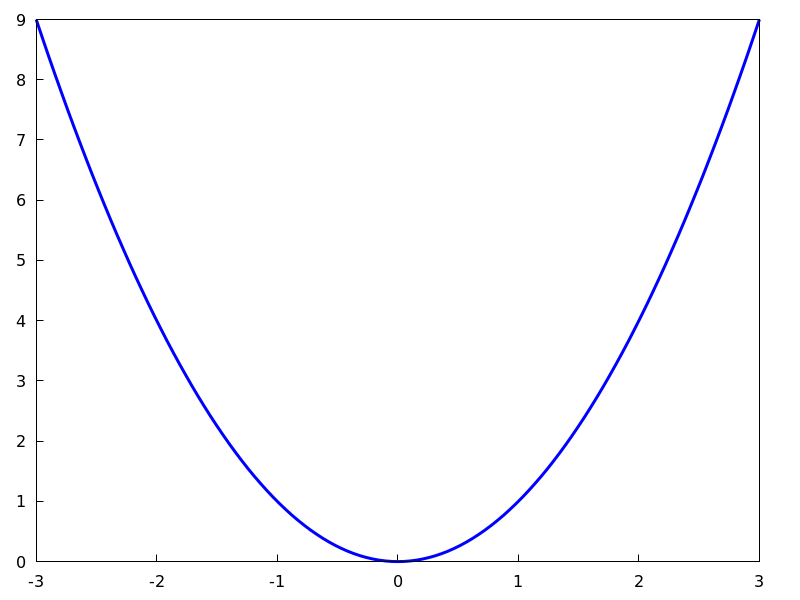
(%i2) draw2d(fill_color = brown, filled_func = true, explicit(x^2,x,-3,3) )$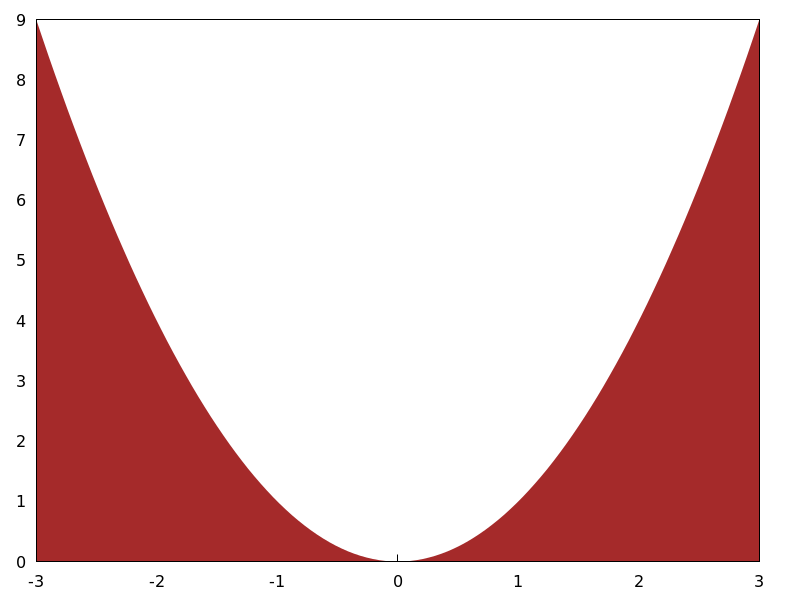
3D
explicit(fcn, var1, minval1, maxval1, var2, minval2, maxval2)plots the explicit function fcn, with variable var1 taking values from minval1 to maxval1 and variable var2 taking values from minval2 to maxval2.This object is affected by the following graphic options:
draw_realpart,xu_grid,yv_grid,line_type,line_width,key,wired_surface,enhanced3dandcolor.Example:
(%i1) draw3d(key = "Gauss", color = "#a02c00", explicit(20*exp(-x^2-y^2)-10,x,-3,3,y,-3,3), yv_grid = 10, color = blue, key = "Plane", explicit(x+y,x,-5,5,y,-5,5), surface_hide = true)$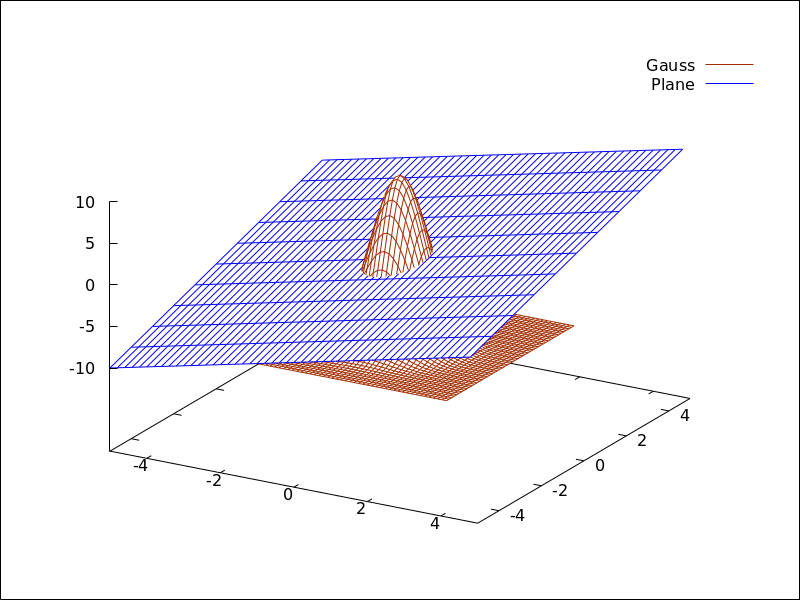
See also
filled_funcfor filled functions.Categories: Package draw ·
- Graphic object: image (im,x0,y0,width,height) ¶
Renders images in 2D.
2D
image (im,x0,y0,width,height)plots image im in the rectangular region from vertex(x0,y0)to(x0+width,y0+height)on the real plane. Argument im must be a matrix of real numbers, a matrix of vectors of length three or a picture object.If im is a matrix of real numbers or a levels picture object, pixel values are interpreted according to graphic option
palette, which is a vector of length three with components ranging from -36 to +36; each value is an index for a formula mapping the levels onto red, green and blue colors, respectively:0: 0 1: 0.5 2: 1 3: x 4: x^2 5: x^3 6: x^4 7: sqrt(x) 8: sqrt(sqrt(x)) 9: sin(90x) 10: cos(90x) 11: |x-0.5| 12: (2x-1)^2 13: sin(180x) 14: |cos(180x)| 15: sin(360x) 16: cos(360x) 17: |sin(360x)| 18: |cos(360x)| 19: |sin(720x)| 20: |cos(720x)| 21: 3x 22: 3x-1 23: 3x-2 24: |3x-1| 25: |3x-2| 26: (3x-1)/2 27: (3x-2)/2 28: |(3x-1)/2| 29: |(3x-2)/2| 30: x/0.32-0.78125 31: 2*x-0.84 32: 4x;1;-2x+1.84;x/0.08-11.5 33: |2*x - 0.5| 34: 2*x 35: 2*x - 0.5 36: 2*x - 1
negative numbers mean negative colour component.
palette = grayandpalette = colorare short cuts forpalette = [3,3,3]andpalette = [7,5,15], respectively.If im is a matrix of vectors of length three or an rgb picture object, they are interpreted as red, green and blue color components.
Examples:
If im is a matrix of real numbers, pixel values are interpreted according to graphic option
palette.(%i1) im: apply( 'matrix, makelist(makelist(random(200),i,1,30),i,1,30))$ (%i2) /* palette = color, default */ draw2d(image(im,0,0,30,30))$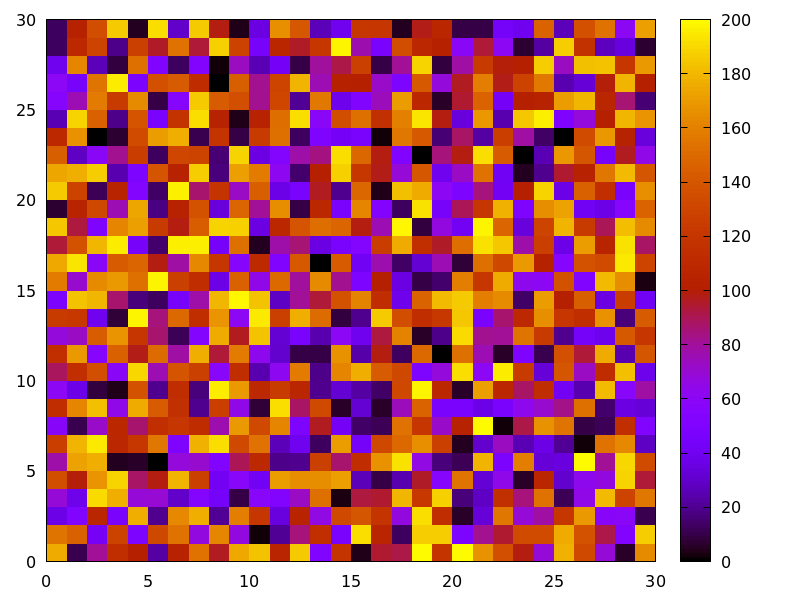
(%i3) draw2d(palette = gray, image(im,0,0,30,30))$
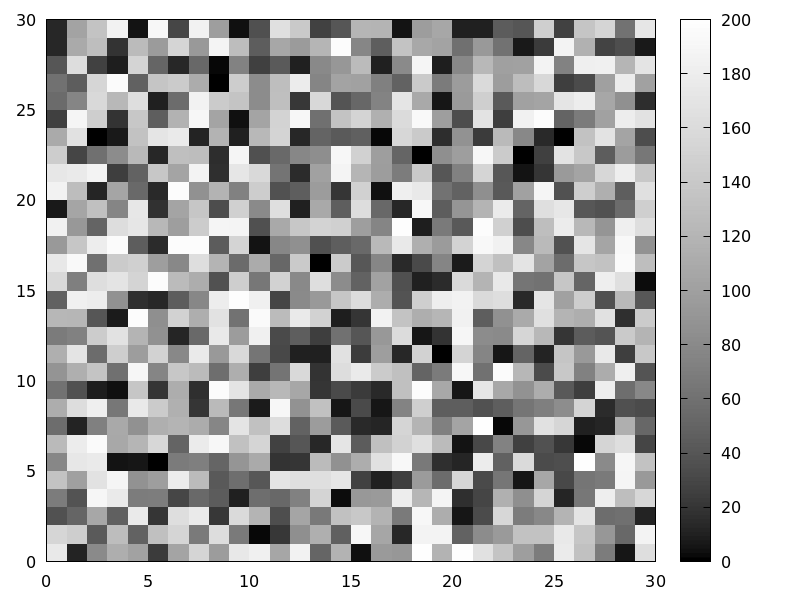
(%i4) draw2d(palette = [15,20,-4], colorbox=false, image(im,0,0,30,30))$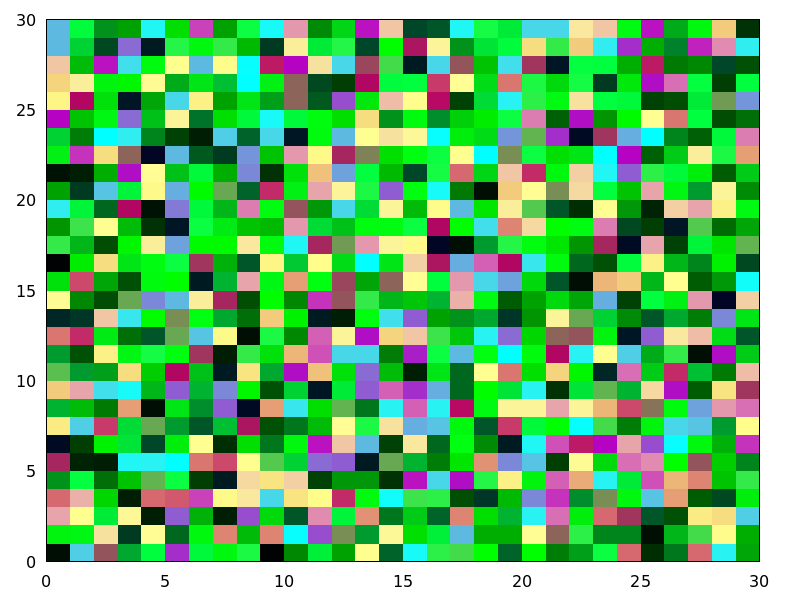
See also
colorbox.If im is a matrix of vectors of length three, they are interpreted as red, green and blue color components.
(%i1) im: apply( 'matrix, makelist( makelist([random(300), random(300), random(300)],i,1,30),i,1,30))$ (%i2) draw2d(image(im,0,0,30,30))$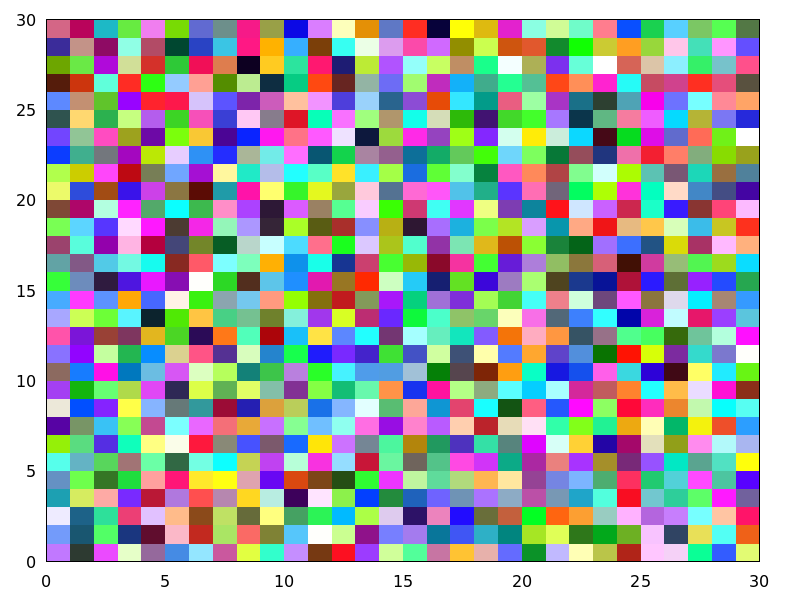
Package
drawautomatically loads packagepicture. In this example, a level picture object is built by hand and then rendered.(%i1) im: make_level_picture([45,87,2,134,204,16],3,2); (%o1) picture(level, 3, 2, {Array: #(45 87 2 134 204 16)}) (%i2) /* default color palette */ draw2d(image(im,0,0,30,30))$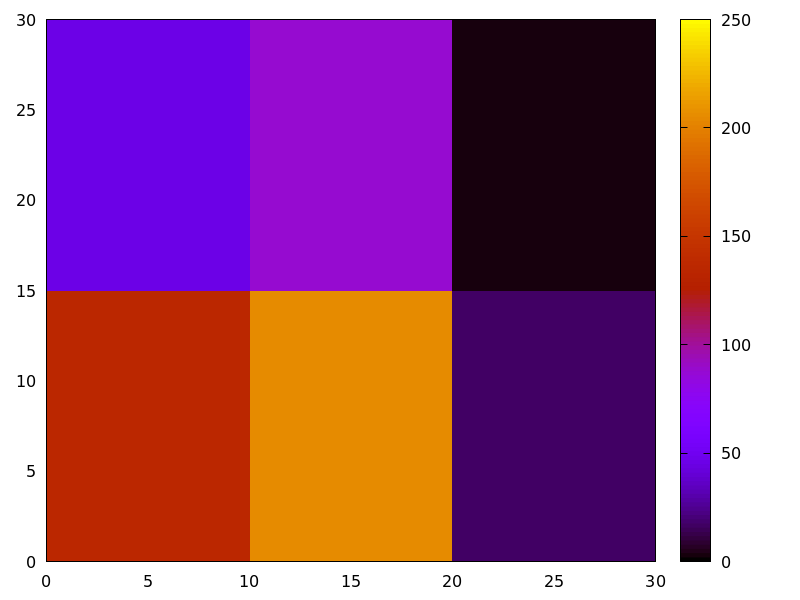
(%i3) /* gray palette */ draw2d(palette = gray, image(im,0,0,30,30))$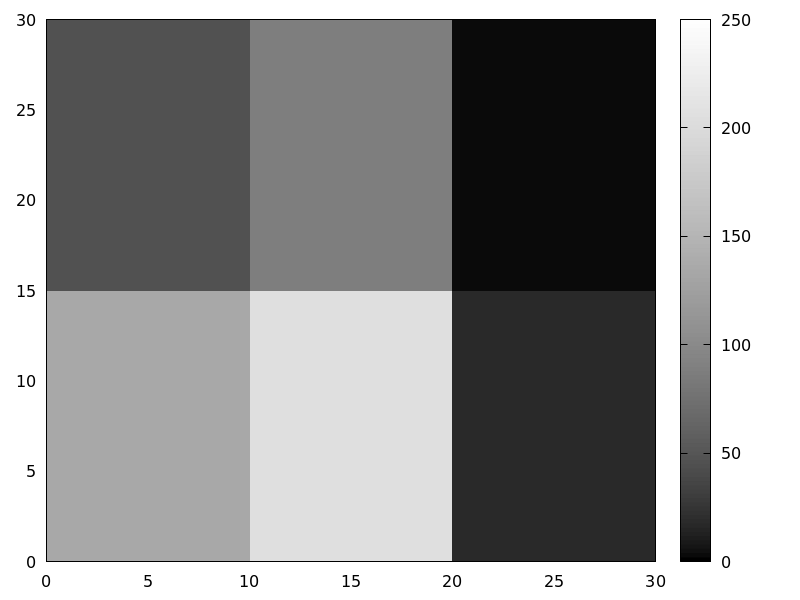
An xpm file is read and then rendered.
(%i1) im: read_xpm("myfile.xpm")$ (%i2) draw2d(image(im,0,0,10,7))$See also
make_level_picture,make_rgb_pictureandread_xpm.http://www.telefonica.net/web2/biomates/maxima/gpdraw/image
contains more elaborated examples.Categories: Package draw ·
- Graphic object: implicit
implicit (fcn,x,xmin,xmax,y,ymin,ymax)
implicit (fcn,x,xmin,xmax,y,ymin,ymax,z,zmin,zmax) ¶ -
Draws implicit functions in 2D and 3D.
2D
implicit(fcn,x,xmin,xmax,y,ymin,ymax)plots the implicit function defined by fcn, with variable x taking values from xmin to xmax, and variable y taking values from ymin to ymax.This object is affected by the following graphic options:
ip_grid,ip_grid_in,line_width,line_type,keyandcolor.Example:
(%i1) draw2d(grid = true, line_type = solid, key = "y^2=x^3-2*x+1", implicit(y^2=x^3-2*x+1, x, -4,4, y, -4,4), line_type = dots, key = "x^3+y^3 = 3*x*y^2-x-1", implicit(x^3+y^3 = 3*x*y^2-x-1, x,-4,4, y,-4,4), title = "Two implicit functions" )$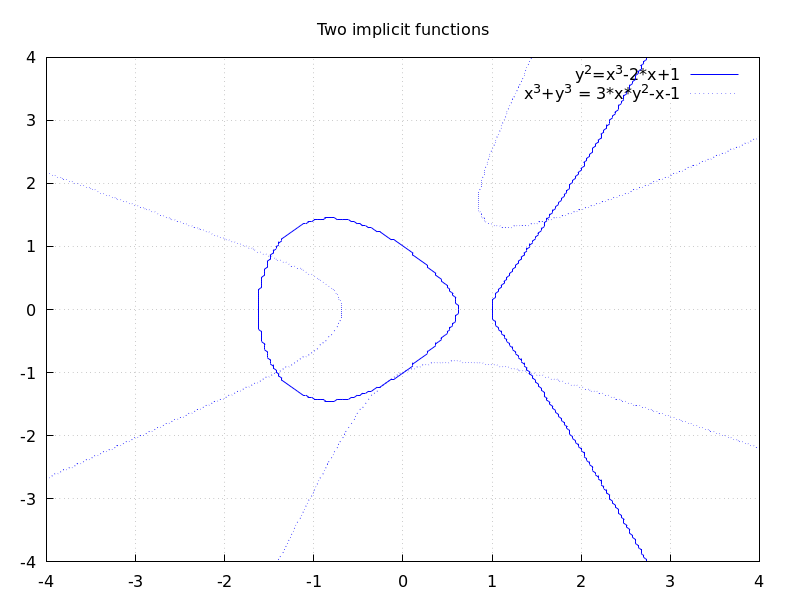
3D
implicit (fcn,x,xmin,xmax, y,ymin,ymax, z,zmin,zmax)plots the implicit surface defined by fcn, with variable x taking values from xmin to xmax, variable y taking values from ymin to ymax and variable z taking values from zmin to zmax. This object implements the marching cubes algorithm.This object is affected by the following graphic options:
x_voxel,y_voxel,z_voxel,line_width,line_type,key,wired_surface,enhanced3dandcolor.Example:
(%i1) draw3d( color=blue, implicit((x^2+y^2+z^2-1)*(x^2+(y-1.5)^2+z^2-0.5)=0.015, x,-1,1,y,-1.2,2.3,z,-1,1), surface_hide=true);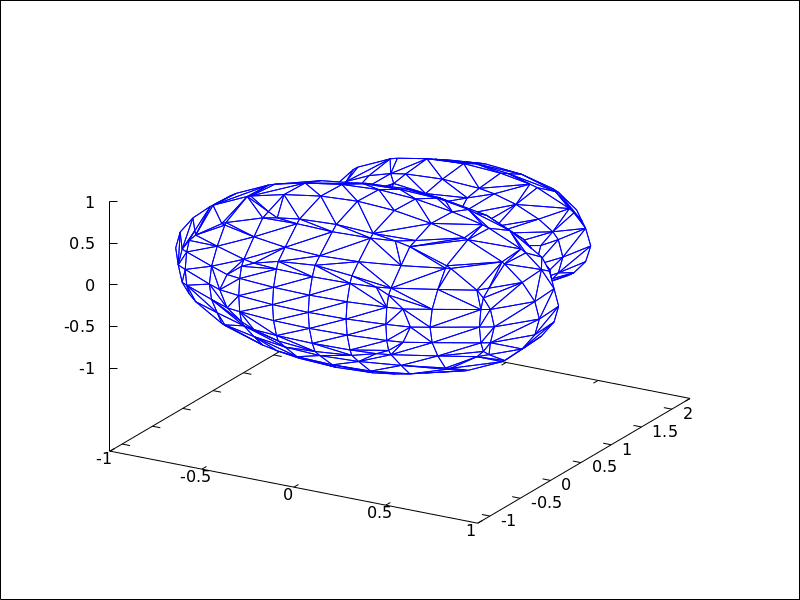 Categories: Package draw ·
Categories: Package draw ·
- Graphic object: label
label ([string,x,y],...)
label ([string,x,y,z],...) ¶ -
Writes labels in 2D and 3D.
Colored labels work only with Gnuplot 4.3 and up.
This object is affected by the following graphic options:
label_alignment,label_orientationandcolor.2D
label([string,x,y])writes the string at point[x,y].Example:
(%i1) draw2d(yrange = [0.1,1.4], color = red, label(["Label in red",0,0.3]), color = "#0000ff", label(["Label in blue",0,0.6]), color = light_blue, label(["Label in light-blue",0,0.9], ["Another light-blue",0,1.2]) )$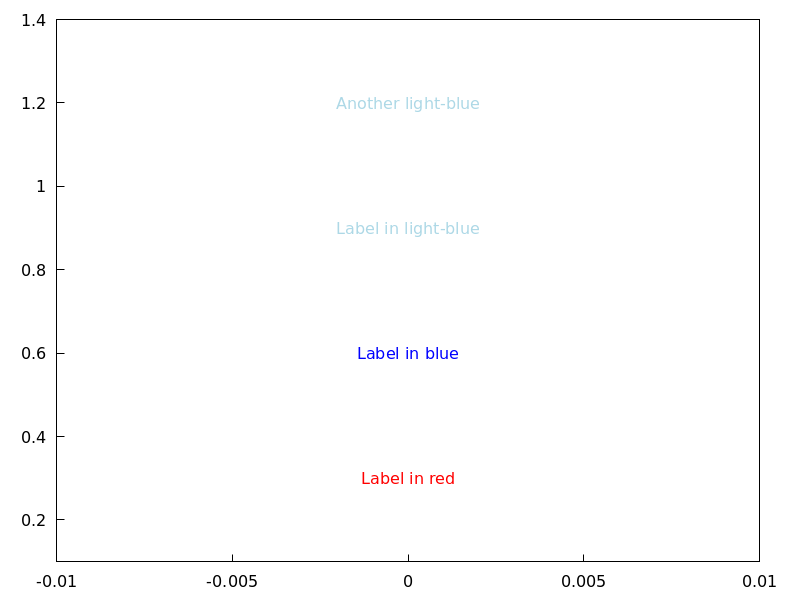
3D
label([string,x,y,z])writes the string at point[x,y,z].Example:
(%i1) draw3d(explicit(exp(sin(x)+cos(x^2)),x,-3,3,y,-3,3), color = red, label(["UP 1",-2,0,3], ["UP 2",1.5,0,4]), color = blue, label(["DOWN 1",2,0,-3]) )$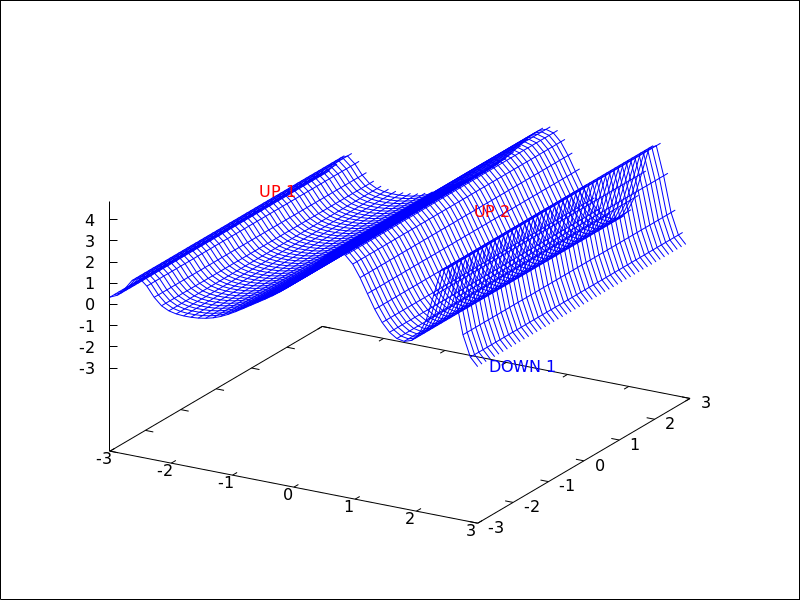 Categories: Package draw ·
Categories: Package draw ·
- Graphic object: mesh (row_1,row_2,...) ¶
Draws a quadrangular mesh in 3D.
3D
Argument row_i is a list of n 3D points of the form
[[x_i1,y_i1,z_i1], ...,[x_in,y_in,z_in]], and all rows are of equal length. All these points define an arbitrary surface in 3D and in some sense it’s a generalization of theelevation_gridobject.This object is affected by the following graphic options:
line_type,line_width,color,key,wired_surface,enhanced3dandtransform.Examples:
A simple example.
(%i1) draw3d( mesh([[1,1,3], [7,3,1],[12,-2,4],[15,0,5]], [[2,7,8], [4,3,1],[10,5,8], [12,7,1]], [[-2,11,10],[6,9,5],[6,15,1], [20,15,2]])) $
Plotting a triangle in 3D.
(%i1) draw3d( line_width = 2, mesh([[1,0,0],[0,1,0]], [[0,0,1],[0,0,1]])) $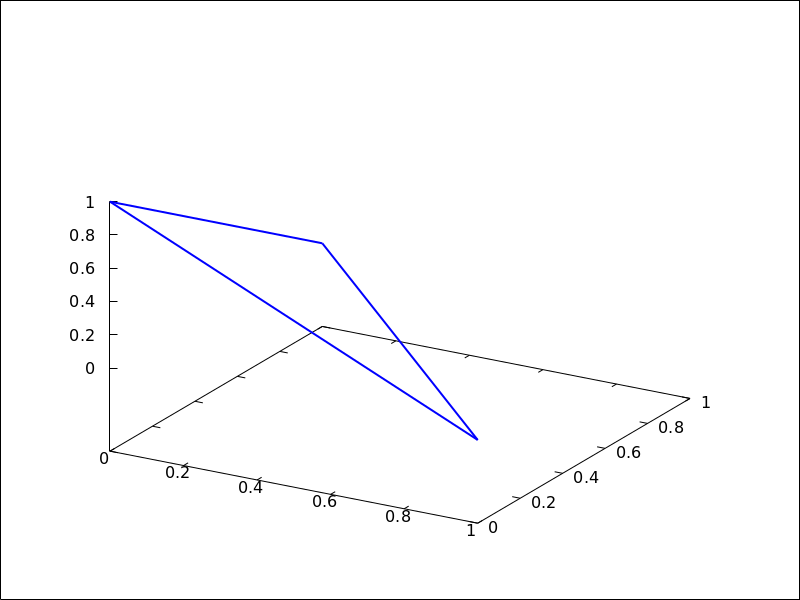
Two quadrilaterals.
(%i1) draw3d( surface_hide = true, line_width = 3, color = red, mesh([[0,0,0], [0,1,0]], [[2,0,2], [2,2,2]]), color = blue, mesh([[0,0,2], [0,1,2]], [[2,0,4], [2,2,4]])) $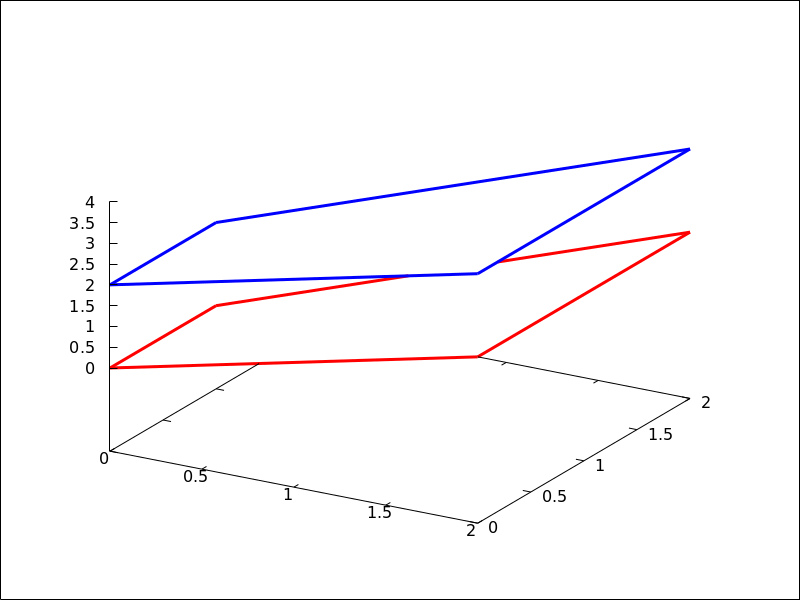 Categories: Package draw ·
Categories: Package draw ·
- Graphic object: parametric
parametric (xfun,yfun,par,parmin,parmax)
parametric (xfun,yfun,zfun,par,parmin,parmax) ¶ -
Draws parametric functions in 2D and 3D.
This object is affected by the following graphic options:
nticks,line_width,line_type,key,colorandenhanced3d.2D
The command
parametric(xfun, yfun, par, parmin, parmax)plots the parametric function[xfun, yfun], with parameter par taking values from parmin to parmax.Example:
(%i1) draw2d(explicit(exp(x),x,-1,3), color = red, key = "This is the parametric one!!", parametric(2*cos(rrr),rrr^2,rrr,0,2*%pi))$
3D
parametric(xfun, yfun, zfun, par, parmin, parmax)plots the parametric curve[xfun, yfun, zfun], with parameter par taking values from parmin to parmax.Example:
(%i1) draw3d(explicit(exp(sin(x)+cos(x^2)),x,-3,3,y,-3,3), color = royalblue, parametric(cos(5*u)^2,sin(7*u),u-2,u,0,2), color = turquoise, line_width = 2, parametric(t^2,sin(t),2+t,t,0,2), surface_hide = true, title = "Surface & curves" )$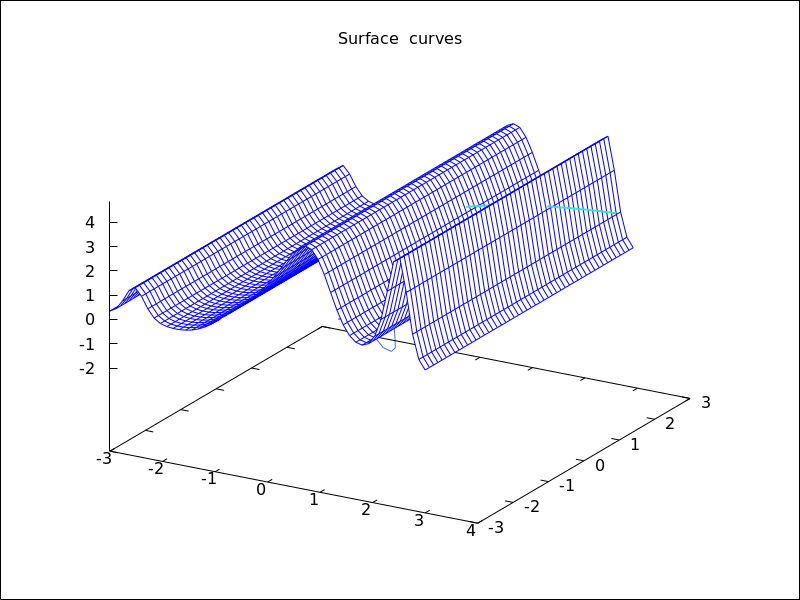 Categories: Package draw ·
Categories: Package draw ·
- Graphic object: parametric_surface (xfun, yfun, zfun, par1, par1min, par1max, par2, par2min, par2max) ¶
Draws parametric surfaces in 3D.
3D
The command
parametric_surface(xfun, yfun, zfun, par1, par1min, par1max, par2, par2min, par2max)plots the parametric surface[xfun, yfun, zfun], with parameter par1 taking values from par1min to par1max and parameter par2 taking values from par2min to par2max.This object is affected by the following graphic options:
draw_realpart,xu_grid,yv_grid,line_type,line_width,key,wired_surface,enhanced3dandcolor.Example:
(%i1) draw3d(title = "Sea shell", xu_grid = 100, yv_grid = 25, view = [100,20], surface_hide = true, parametric_surface(0.5*u*cos(u)*(cos(v)+1), 0.5*u*sin(u)*(cos(v)+1), u*sin(v) - ((u+3)/8*%pi)^2 - 20, u, 0, 13*%pi, v, -%pi, %pi) )$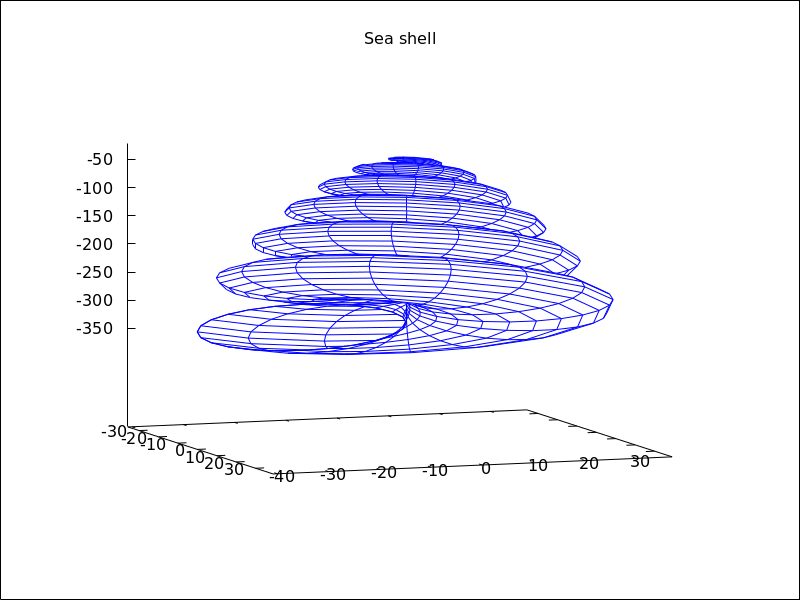 Categories: Package draw ·
Categories: Package draw ·
- Graphic object: points
points ([[x1,y1], [x2,y2],...])
points ([x1,x2,...], [y1,y2,...])
points ([y1,y2,...])
points ([[x1,y1,z1], [x2,y2,z2],...])
points ([x1,x2,...], [y1,y2,...], [z1,z2,...])
points (matrix)
points (1d_y_array)
points (1d_x_array, 1d_y_array)
points (1d_x_array, 1d_y_array, 1d_z_array)
points (2d_xy_array)
points (2d_xyz_array) ¶ -
Draws points in 2D and 3D.
This object is affected by the following graphic options:
point_size,point_type,points_joined,line_width,key,line_typeandcolor. In 3D mode, it is also affected byenhanced3d2D
points ([[x1,y1], [x2,y2],...])orpoints ([x1,x2,...], [y1,y2,...])plots points[x1,y1],[x2,y2], etc. If abscissas are not given, they are set to consecutive positive integers, so thatpoints ([y1,y2,...])draws points[1,y1],[2,y2], etc. If matrix is a two-column or two-row matrix,points (matrix)draws the associated points. If matrix is an one-column or one-row matrix, abscissas are assigned automatically.If 1d_y_array is a 1D lisp array of numbers,
points (1d_y_array)plots them setting abscissas to consecutive positive integers.points (1d_x_array, 1d_y_array)plots points with their coordinates taken from the two arrays passed as arguments. If 2d_xy_array is a 2D array with two columns, or with two rows,points (2d_xy_array)plots the corresponding points on the plane.Examples:
Two types of arguments for
points, a list of pairs and two lists of separate coordinates.(%i1) draw2d( key = "Small points", points(makelist([random(20),random(50)],k,1,10)), point_type = circle, point_size = 3, points_joined = true, key = "Great points", points(makelist(k,k,1,20),makelist(random(30),k,1,20)), point_type = filled_down_triangle, key = "Automatic abscissas", color = red, points([2,12,8]))$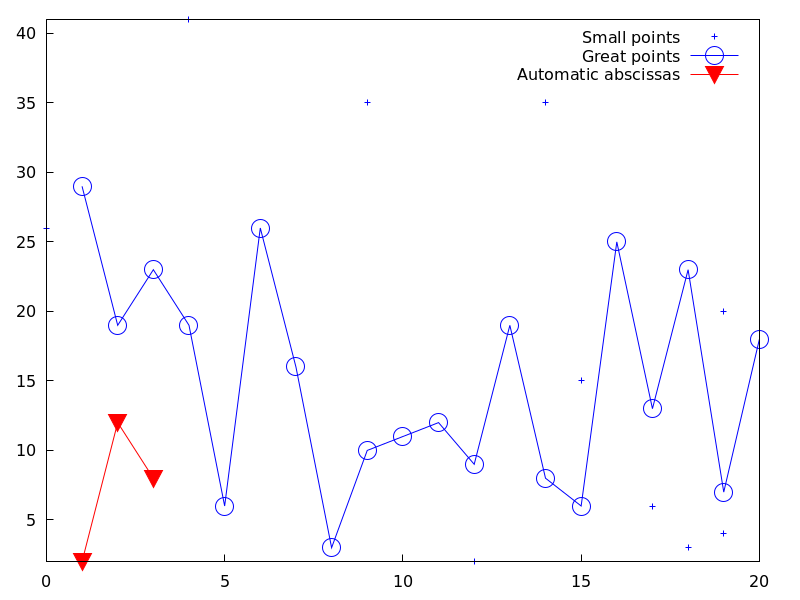
Drawing impulses.
(%i1) draw2d( points_joined = impulses, line_width = 2, color = red, points(makelist([random(20),random(50)],k,1,10)))$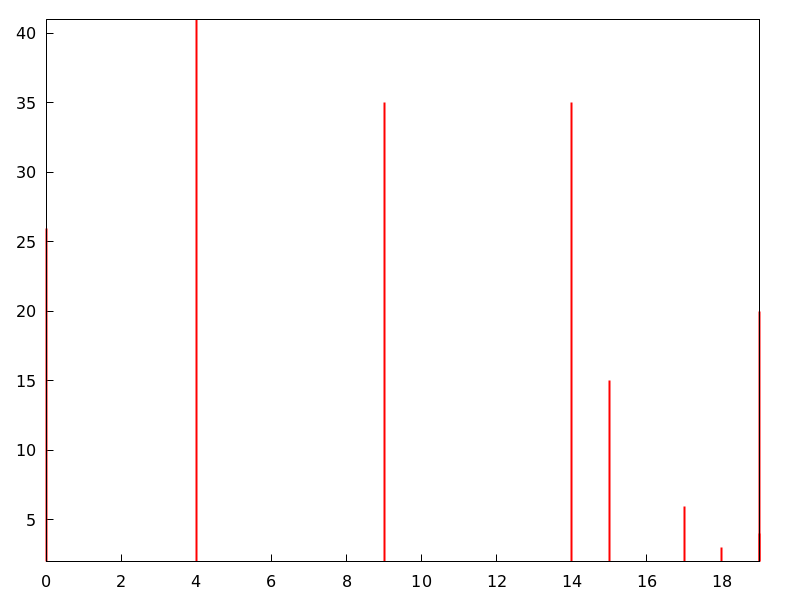
Array with ordinates.
(%i1) a: make_array (flonum, 100) $ (%i2) for i:0 thru 99 do a[i]: random(1.0) $ (%i3) draw2d(points(a)) $
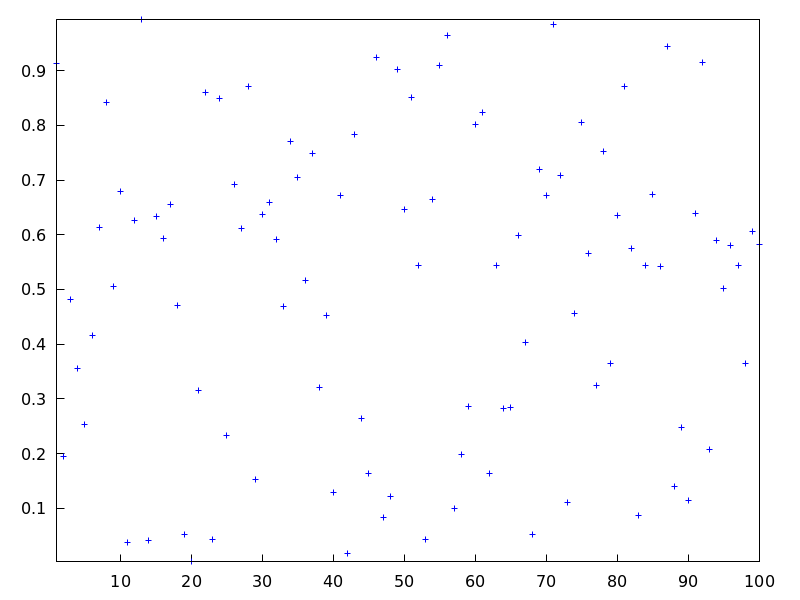
Two arrays with separate coordinates.
(%i1) x: make_array (flonum, 100) $ (%i2) y: make_array (fixnum, 100) $ (%i3) for i:0 thru 99 do ( x[i]: float(i/100), y[i]: random(10) ) $ (%i4) draw2d(points(x, y)) $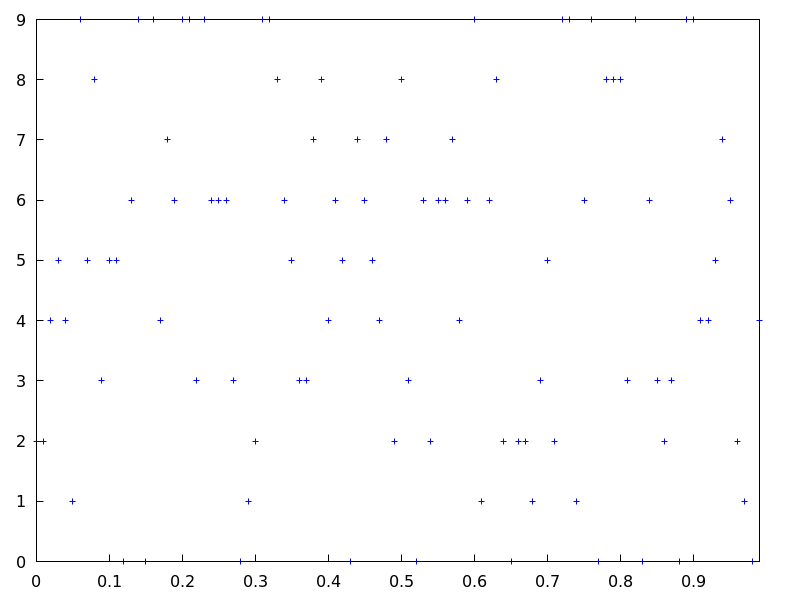
A two-column 2D array.
(%i1) xy: make_array(flonum, 100, 2) $ (%i2) for i:0 thru 99 do ( xy[i, 0]: float(i/100), xy[i, 1]: random(10) ) $ (%i3) draw2d(points(xy)) $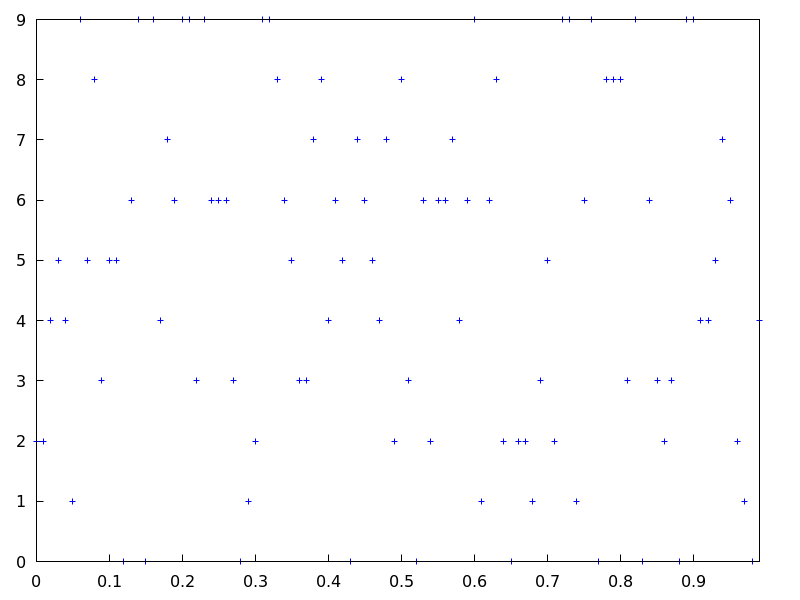
Drawing an array filled with function
read_array.(%i1) a: make_array(flonum,100) $ (%i2) read_array (file_search ("pidigits.data"), a) $ (%i3) draw2d(points(a)) $3D
points([[x1, y1, z1], [x2, y2, z2], ...])orpoints([x1, x2, ...], [y1, y2, ...], [z1, z2,...])plots points[x1, y1, z1],[x2, y2, z2], etc. If matrix is a three-column or three-row matrix,points (matrix)draws the associated points.When arguments are lisp arrays,
points (1d_x_array, 1d_y_array, 1d_z_array)takes coordinates from the three 1D arrays. If 2d_xyz_array is a 2D array with three columns, or with three rows,points (2d_xyz_array)plots the corresponding points.Examples:
One tridimensional sample,
(%i1) load ("numericalio")$ (%i2) s2 : read_matrix (file_search ("wind.data"))$ (%i3) draw3d(title = "Daily average wind speeds", point_size = 2, points(args(submatrix (s2, 4, 5))) )$Two tridimensional samples,
(%i1) load ("numericalio")$ (%i2) s2 : read_matrix (file_search ("wind.data"))$ (%i3) draw3d( title = "Daily average wind speeds. Two data sets", point_size = 2, key = "Sample from stations 1, 2 and 3", points(args(submatrix (s2, 4, 5))), point_type = 4, key = "Sample from stations 1, 4 and 5", points(args(submatrix (s2, 2, 3))) )$Unidimensional arrays,
(%i1) x: make_array (fixnum, 10) $ (%i2) y: make_array (fixnum, 10) $ (%i3) z: make_array (fixnum, 10) $ (%i4) for i:0 thru 9 do ( x[i]: random(10), y[i]: random(10), z[i]: random(10) ) $ (%i5) draw3d(points(x,y,z)) $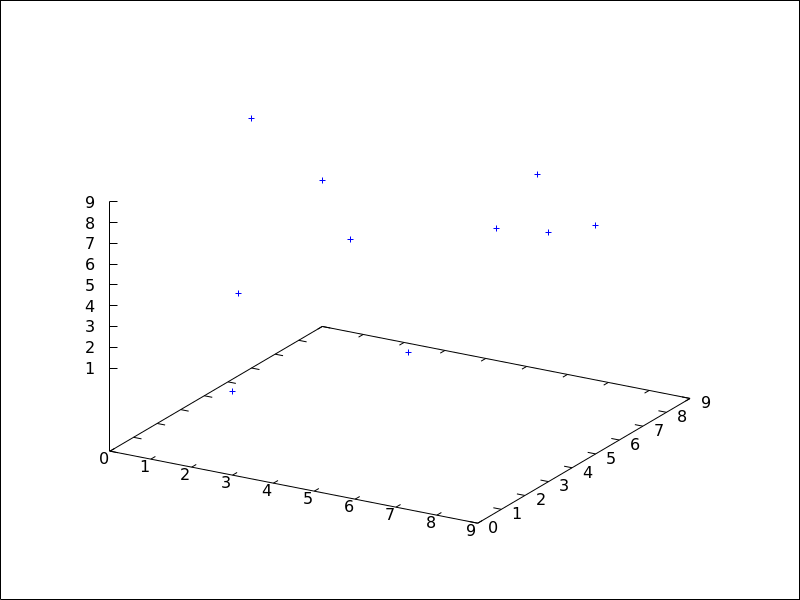
Bidimensional colored array,
(%i1) xyz: make_array(fixnum, 10, 3) $ (%i2) for i:0 thru 9 do ( xyz[i, 0]: random(10), xyz[i, 1]: random(10), xyz[i, 2]: random(10) ) $ (%i3) draw3d( enhanced3d = true, points_joined = true, points(xyz)) $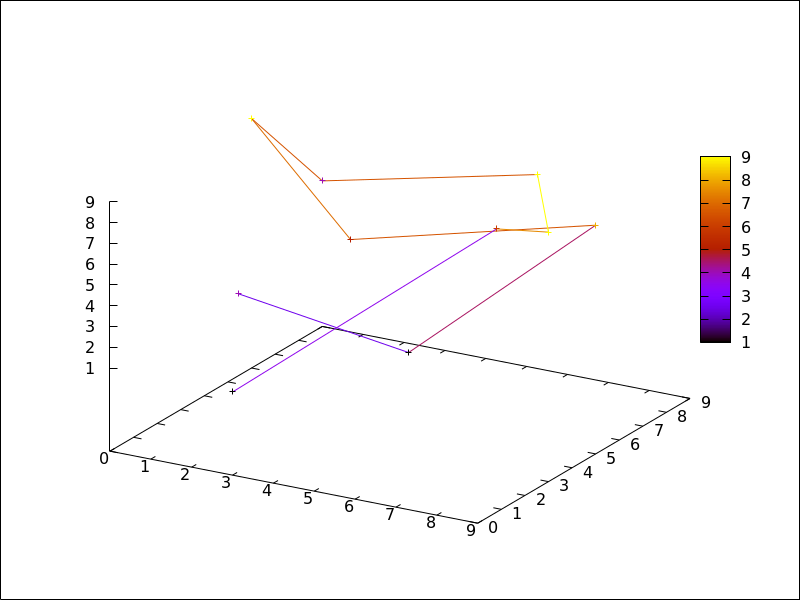
Color numbers explicitly specified by the user.
(%i1) pts: makelist([t,t^2,cos(t)], t, 0, 15)$ (%i2) col_num: makelist(k, k, 1, length(pts))$ (%i3) draw3d( enhanced3d = ['part(col_num,k),k], point_size = 3, point_type = filled_circle, points(pts))$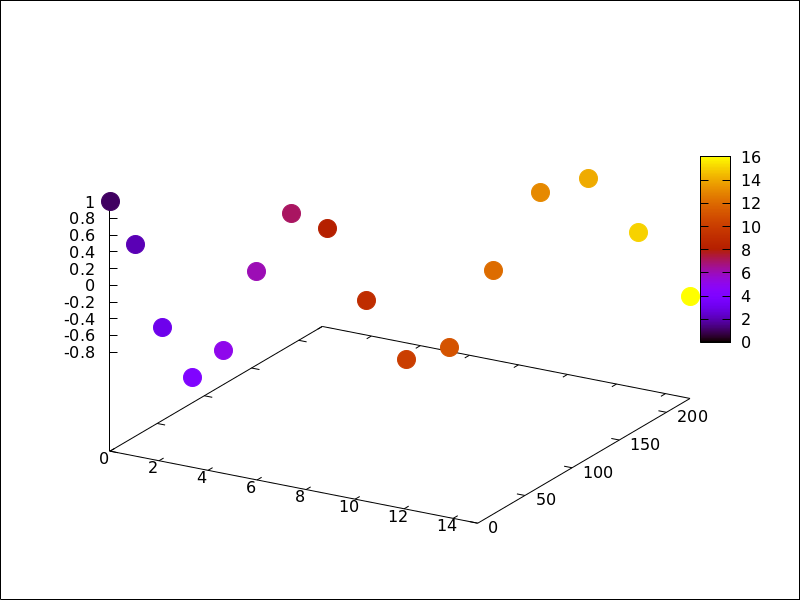 Categories: Package draw ·
Categories: Package draw ·
- Graphic object: polar (radius,ang,minang,maxang) ¶
Draws 2D functions defined in polar coordinates.
2D
polar (radius,ang,minang,maxang)plots functionradius(ang)defined in polar coordinates, with variable ang taking values from minang to maxang.This object is affected by the following graphic options:
nticks,line_width,line_type,keyandcolor.Example:
(%i1) draw2d(user_preamble = "set grid polar", nticks = 200, xrange = [-5,5], yrange = [-5,5], color = blue, line_width = 3, title = "Hyperbolic Spiral", polar(10/theta,theta,1,10*%pi) )$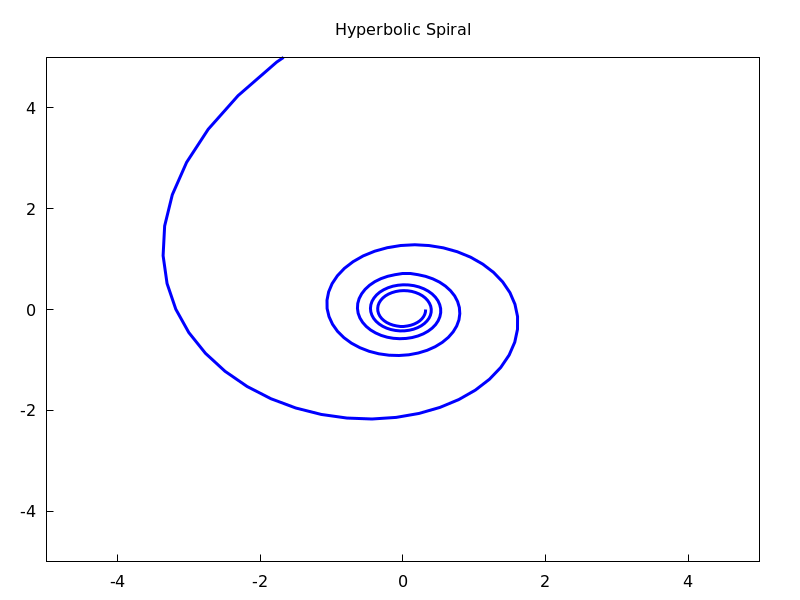 Categories: Package draw ·
Categories: Package draw ·
- Graphic object: polygon
polygon ([[x1, y1], [x2, y2], …])
polygon ([x1, x2, …], [y1, y2, …]) ¶ -
Draws polygons in 2D.
2D
The commands
polygon([[x1, y1], [x2, y2], ...])orpolygon([x1, x2, ...], [y1, y2, ...])plot on the plane a polygon with vertices[x1, y1],[x2, y2], etc.This object is affected by the following graphic options:
transparent,fill_color,fill_density,border,line_width,key,line_typeandcolor.Example:
(%i1) draw2d(color = "#e245f0", line_width = 8, polygon([[3,2],[7,2],[5,5]]), border = false, fill_color = yellow, polygon([[5,2],[9,2],[7,5]]) )$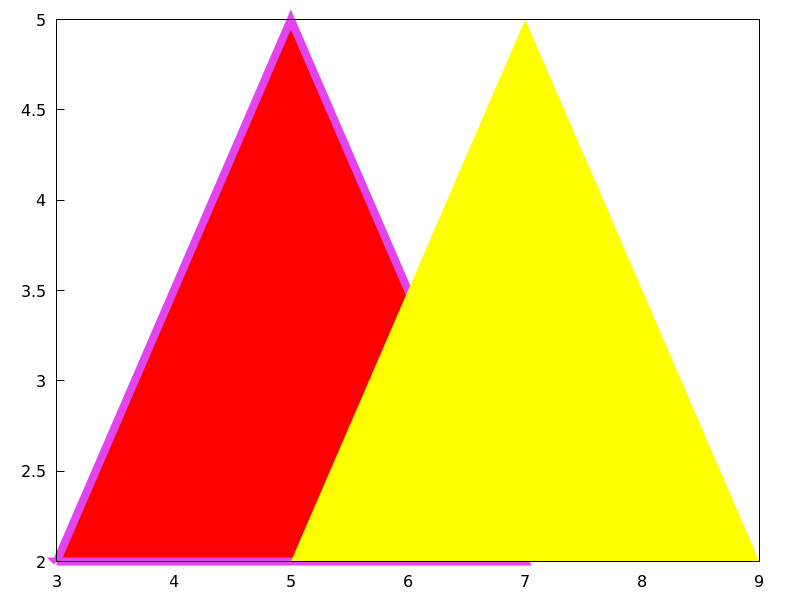 Categories: Package draw ·
Categories: Package draw ·
- Graphic object: quadrilateral (point_1, point_2, point_3, point_4) ¶
Draws a quadrilateral.
2D
quadrilateral([x1, y1], [x2, y2], [x3, y3], [x4, y4])draws a quadrilateral with vertices[x1, y1],[x2, y2],[x3, y3], and[x4, y4].This object is affected by the following graphic options:
transparent,fill_color,border,line_width,key,xaxis_secondary,yaxis_secondary,line_type,transformandcolor.Example:
(%i1) draw2d( quadrilateral([1,1],[2,2],[3,-1],[2,-2]))$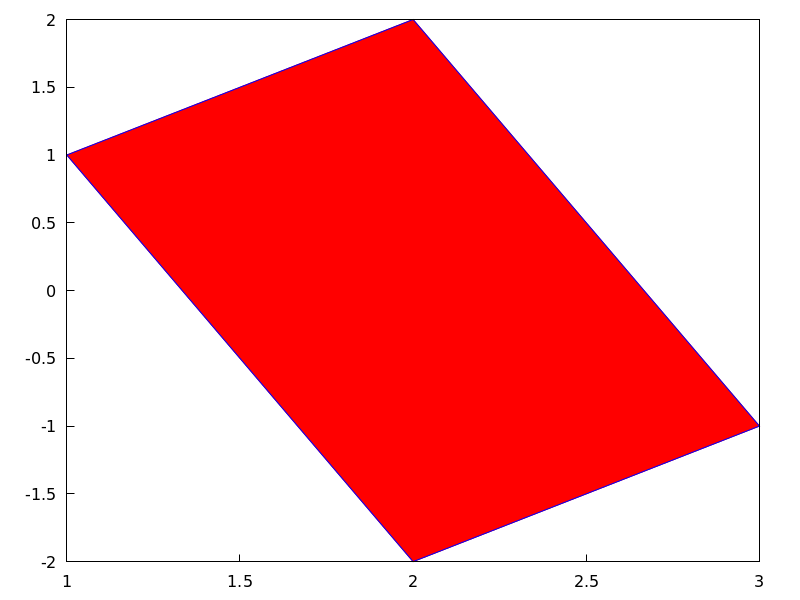
3D
quadrilateral([x1, y1, z1], [x2, y2, z2], [x3, y3, z3], [x4, y4, z4])draws a quadrilateral with vertices[x1, y1, z1],[x2, y2, z2],[x3, y3, z3], and[x4, y4, z4].This object is affected by the following graphic options:
line_type,line_width,color,key,enhanced3dandtransform.Categories: Package draw ·
- Graphic object: rectangle ([x1,y1], [x2,y2]) ¶
Draws rectangles in 2D.
2D
rectangle ([x1,y1], [x2,y2])draws a rectangle with opposite vertices[x1,y1]and[x2,y2].This object is affected by the following graphic options:
transparent,fill_color,border,line_width,key,line_typeandcolor.Example:
(%i1) draw2d(fill_color = red, line_width = 6, line_type = dots, transparent = false, fill_color = blue, rectangle([-2,-2],[8,-1]), /* opposite vertices */ transparent = true, line_type = solid, line_width = 1, rectangle([9,4],[2,-1.5]), xrange = [-3,10], yrange = [-3,4.5] )$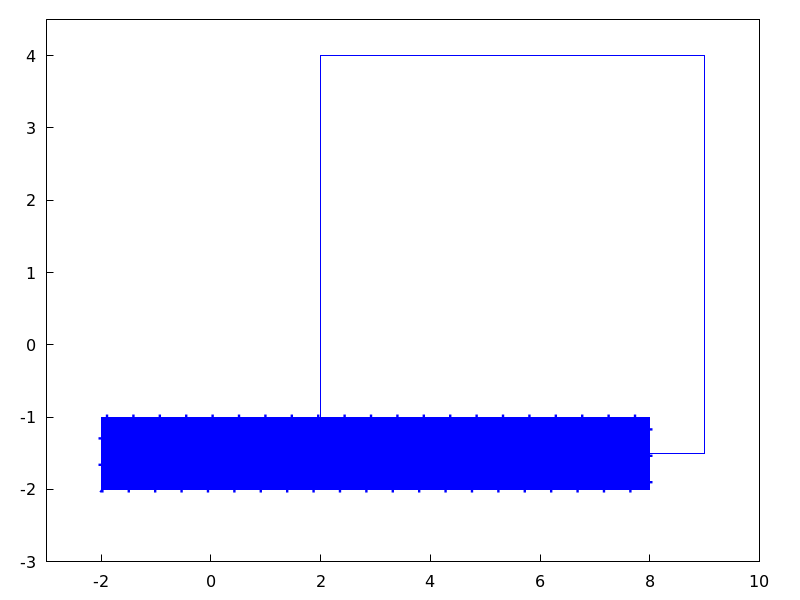 Categories: Package draw ·
Categories: Package draw ·
- Graphic object: region (expr,var1,minval1,maxval1,var2,minval2,maxval2) ¶
Plots a region on the plane defined by inequalities.
2D expr is an expression formed by inequalities and boolean operators
and,or, andnot. The region is bounded by the rectangle defined by [minval1, maxval1] and [minval2, maxval2].This object is affected by the following graphic options:
fill_color,fill_density,key,x_voxelandy_voxel.Example:
(%i1) draw2d( x_voxel = 30, y_voxel = 30, region(x^2+y^2<1 and x^2+y^2 > 1/2, x, -1.5, 1.5, y, -1.5, 1.5));
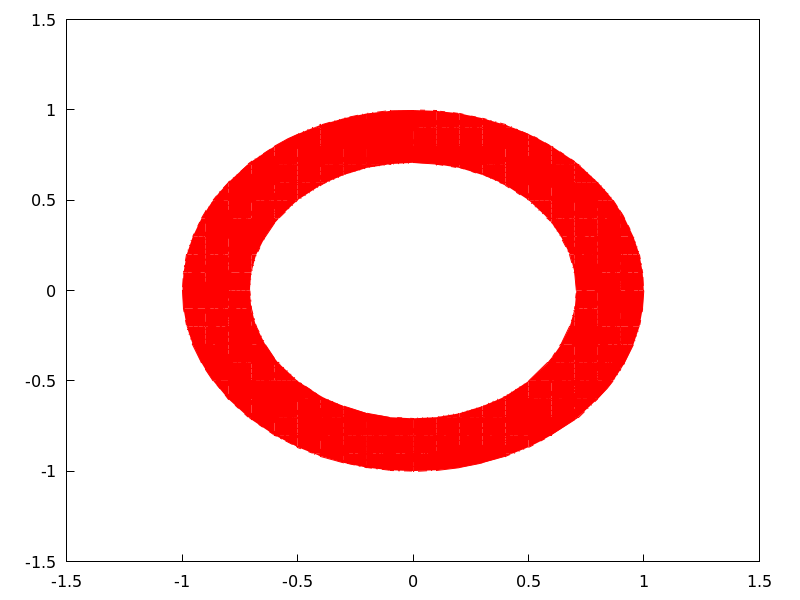
- Graphic object: spherical (radius, azi, minazi, maxazi, zen, minzen, maxzen) ¶
Draws 3D functions defined in spherical coordinates.
3D
spherical(radius, azi, minazi, maxazi, zen, minzen, maxzen)plots the functionradius(azi, zen)defined in spherical coordinates, with azimuth azi taking values from minazi to maxazi and zenith zen taking values from minzen to maxzen.This object is affected by the following graphic options:
xu_grid,yv_grid,line_type,key,wired_surface,enhanced3dandcolor.Example:
(%i1) draw3d(spherical(1,a,0,2*%pi,z,0,%pi))$
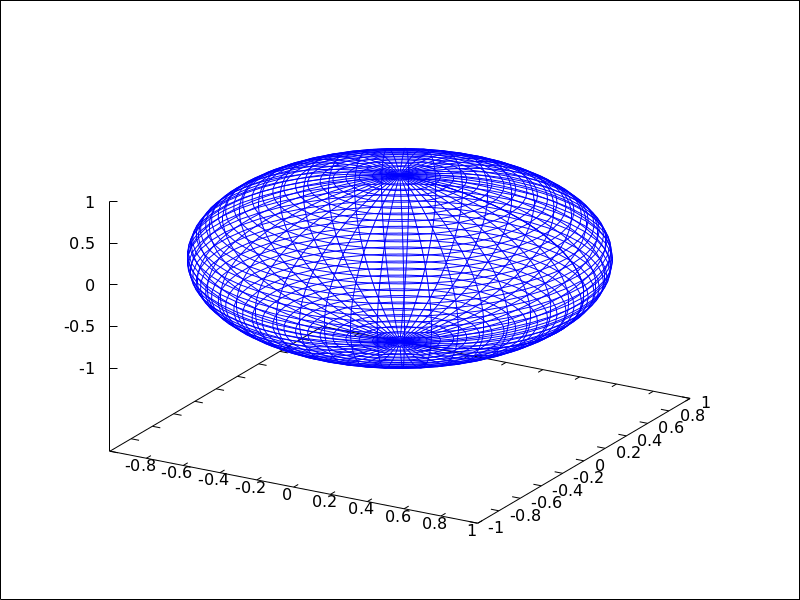 Categories: Package draw ·
Categories: Package draw ·
- Graphic object: triangle (point_1, point_2, point_3) ¶
Draws a triangle.
2D
triangle ([x1,y1], [x2,y2], [x3,y3])draws a triangle with vertices[x1,y1],[x2,y2], and[x3,y3].This object is affected by the following graphic options:
transparent,fill_color,border,line_width,key,xaxis_secondary,yaxis_secondary,line_type,transformandcolor.Example:
(%i1) draw2d( triangle([1,1],[2,2],[3,-1]))$
3D
triangle ([x1,y1,z1], [x2,y2,z2], [x3,y3,z3])draws a triangle with vertices[x1,y1,z1],[x2,y2,z2], and[x3,y3,z3].This object is affected by the following graphic options:
line_type,line_width,color,key,enhanced3dandtransform.Categories: Package draw ·
- Graphic object: tube (xfun,yfun,zfun,rfun,p,pmin,pmax) ¶
Draws a tube in 3D with varying diameter.
3D
[xfun,yfun,zfun]is the parametric curve with parameter p taking values from pmin to pmax. Circles of radius rfun are placed with their centers on the parametric curve and perpendicular to it.This object is affected by the following graphic options:
xu_grid,yv_grid,line_type,line_width,key,wired_surface,enhanced3d,colorandcapping.Example:
(%i1) draw3d( enhanced3d = true, xu_grid = 50, tube(cos(a), a, 0, cos(a/10)^2, a, 0, 4*%pi) )$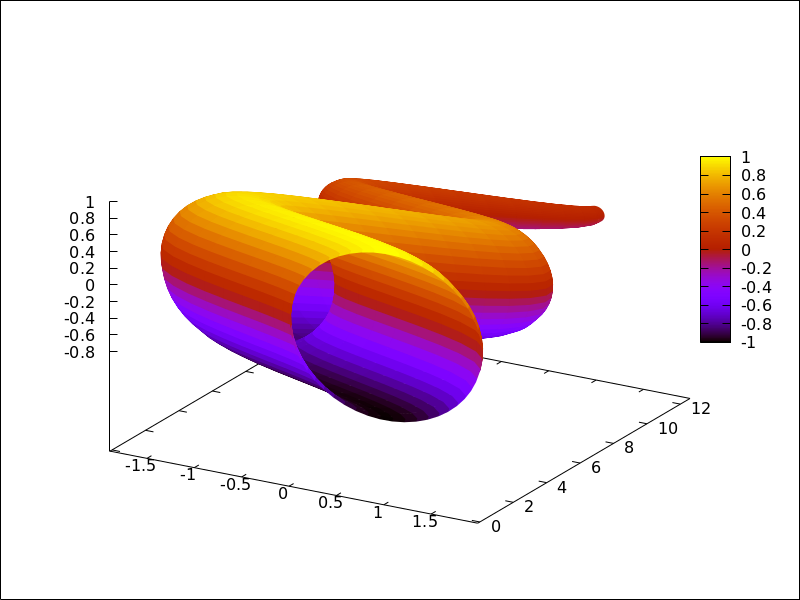 Categories: Package draw ·
Categories: Package draw ·
- Graphic object: vector
vector ([x,y], [dx,dy])
vector ([x,y,z], [dx,dy,dz]) ¶ -
Draws vectors in 2D and 3D.
This object is affected by the following graphic options:
head_both,head_length,head_angle,head_type,line_width,line_type,keyandcolor.2D
vector([x,y], [dx,dy])plots vector[dx,dy]with origin in[x,y].Example:
(%i1) draw2d(xrange = [0,12], yrange = [0,10], head_length = 1, vector([0,1],[5,5]), /* default type */ head_type = 'empty, vector([3,1],[5,5]), head_both = true, head_type = 'nofilled, line_type = dots, vector([6,1],[5,5]))$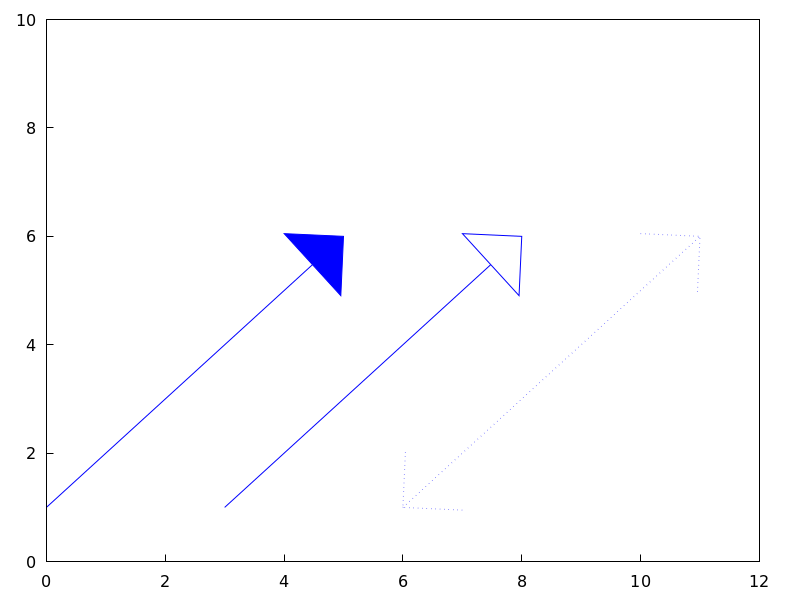
3D
vector([x,y,z], [dx,dy,dz])plots vector[dx,dy,dz]with origin in[x,y,z].Example:
(%i1) draw3d(color = cyan, vector([0,0,0],[1,1,1]/sqrt(3)), vector([0,0,0],[1,-1,0]/sqrt(2)), vector([0,0,0],[1,1,-2]/sqrt(6)) )$ Categories: Package draw ·
Categories: Package draw ·
- Variable: draw_renderer ¶
Default value:
gnuplot_pipesWhen
draw_rendereris set to'vtk, the VTK interface is used for draw.Categories: Package draw ·